Documents
Department of Justice Prosecutive Summary into NSA and CIA Criminal Activities
Oct. 2, 2014
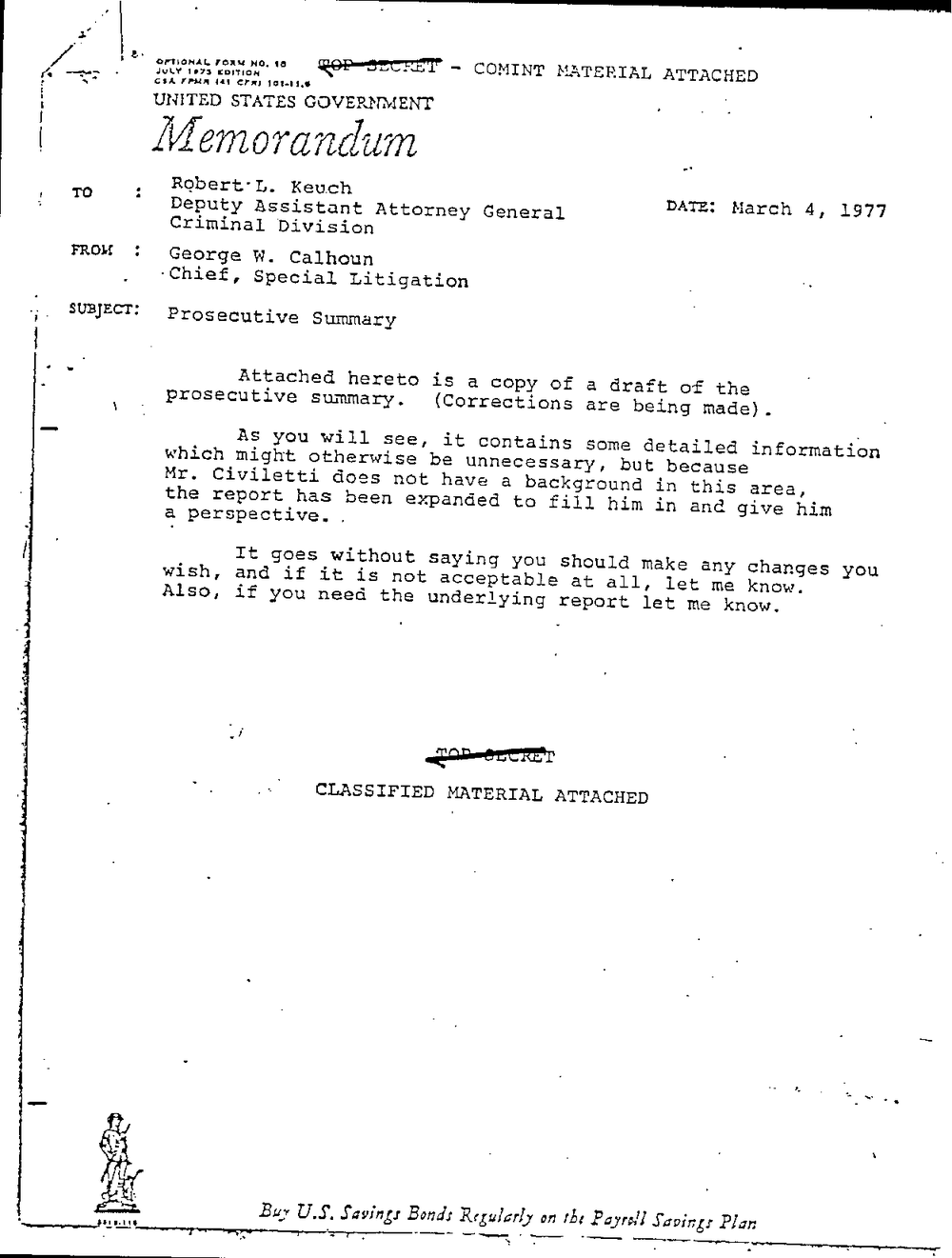
3
FROM
squcm
-
A
.
m} -Luhumi an].th
LL
-
onmwu. ranu no. to
- COMINT MATERIAL ATTACHED
JULY in: cannon
(NR
UNITED STATES GOVEPJTM ENT
M'emomndum
Robert?L. Keuch
Deputy Assistant Attorney General
Criminal'Division
DATE: March 4, 1977
George W. Calhoun
-Chief, Special Litigation
Prosecutive Summary
Attached hereto is a copy of a draft of the
prosecutive summary. (Corrections are being made).
As you will see, it contains some detailed information
which might otherwise be unnecessary, but because
Mr. Civiletti does not have a background in this area,
the report has been expanded to fill him in and give him
a perspective..
It goes without saying you should make any changes you
and if it is not acceptable at all, let me know.
if you need the underlying report let me know.
wish,
Also,
.gnn?eccaET
- . .J CLASSIFIED MATERIAL ATTACHED
Pajm?.? facing: Plan
-
Big 5491375! Bond: Regular
3
FROM
squcm
-
A
.
m} -Luhumi an].th
LL
-
onmwu. ranu no. to
- COMINT MATERIAL ATTACHED
JULY in: cannon
(NR
UNITED STATES GOVEPJTM ENT
M'emomndum
Robert?L. Keuch
Deputy Assistant Attorney General
Criminal'Division
DATE: March 4, 1977
George W. Calhoun
-Chief, Special Litigation
Prosecutive Summary
Attached hereto is a copy of a draft of the
prosecutive summary. (Corrections are being made).
As you will see, it contains some detailed information
which might otherwise be unnecessary, but because
Mr. Civiletti does not have a background in this area,
the report has been expanded to fill him in and give him
a perspective..
It goes without saying you should make any changes you
and if it is not acceptable at all, let me know.
if you need the underlying report let me know.
wish,
Also,
.gnn?eccaET
- . .J CLASSIFIED MATERIAL ATTACHED
Pajm?.? facing: Plan
-
Big 5491375! Bond: Regular
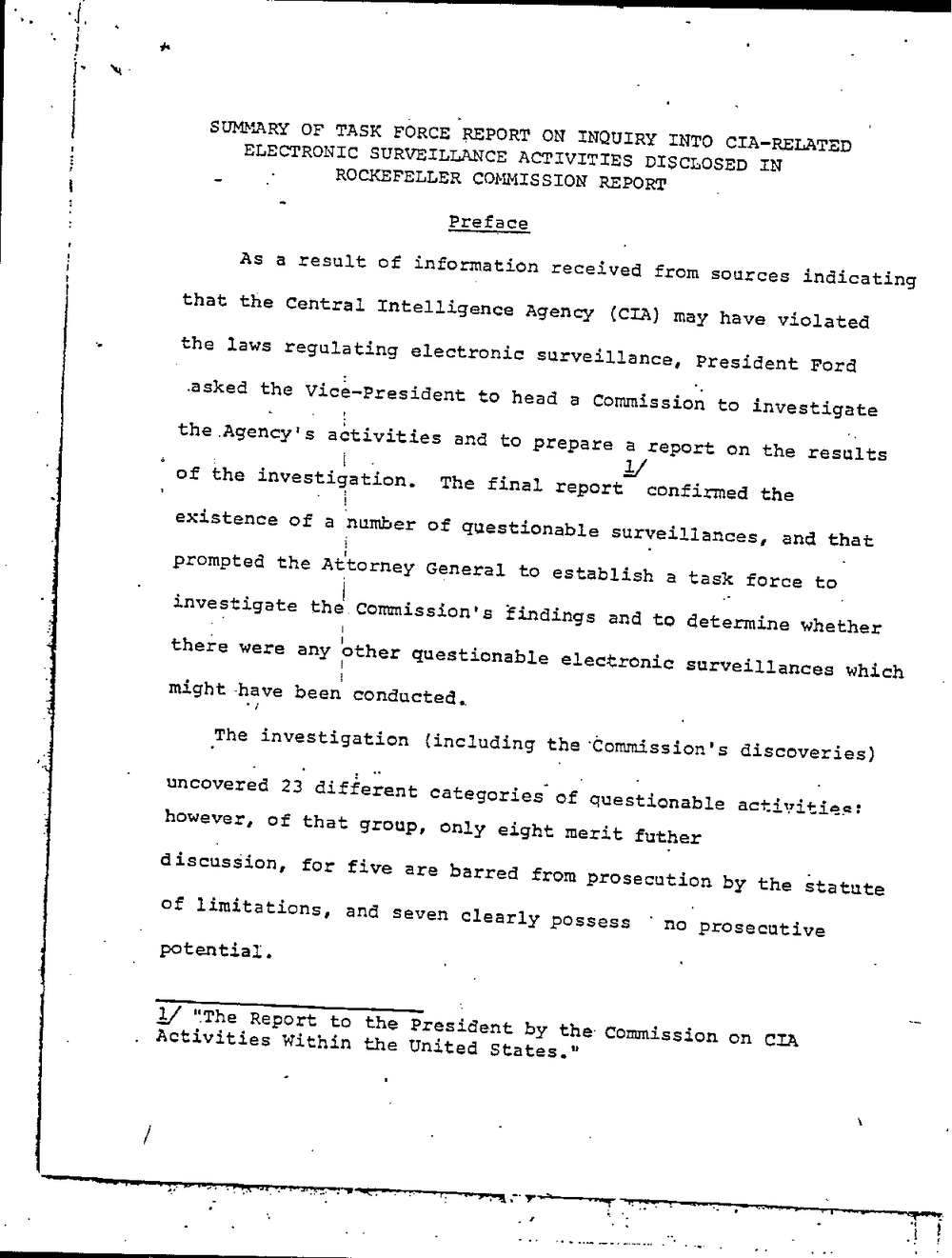
SUMMARY OF TASK FORCE REPORT ON INQUIRY INTO CIA-RELATED
ELECTRONIC SURVEILLANCE ACTIVITIES DISCLOSED IN
ROCKEFELLER COMMISSION REPORT
1-
.o - n1 .dhr unl?l-h
21%
As a result of information received from sources indicating
that the Central Intelligence Agency (CIA) may have violated
. the laws regulating electronic surveillance, President Ford
I i l/
'4 of the investigation. The final report confirmed the
.1 'i
existence of a number of questionable surveillances, and that
prompted the Attorney General to establish a task force to
investigate the.Commission's findings and to determine whether
I
there were any Fther questionable electronic surveillances which
i
might-have been conducted.
.
.4 cu.? Am
'The investigation (including the'Commission's discoveries)
uncovered 23 difierent categories of questionable activities:
however, of that group, only eight merit father
discussion, for five are barred from prosecution by the statute
of limitations, and seven clearly possess no prosecutive
potential.
;/'5The Report to the President by the-Commission on CIA
Activities Within the United States."
a
. 3?441
.
SUMMARY OF TASK FORCE REPORT ON INQUIRY INTO CIA-RELATED
ELECTRONIC SURVEILLANCE ACTIVITIES DISCLOSED IN
ROCKEFELLER COMMISSION REPORT
1-
.o - n1 .dhr unl?l-h
21%
As a result of information received from sources indicating
that the Central Intelligence Agency (CIA) may have violated
. the laws regulating electronic surveillance, President Ford
I i l/
'4 of the investigation. The final report confirmed the
.1 'i
existence of a number of questionable surveillances, and that
prompted the Attorney General to establish a task force to
investigate the.Commission's findings and to determine whether
I
there were any Fther questionable electronic surveillances which
i
might-have been conducted.
.
.4 cu.? Am
'The investigation (including the'Commission's discoveries)
uncovered 23 difierent categories of questionable activities:
however, of that group, only eight merit father
discussion, for five are barred from prosecution by the statute
of limitations, and seven clearly possess no prosecutive
potential.
;/'5The Report to the President by the-Commission on CIA
Activities Within the United States."
a
. 3?441
.
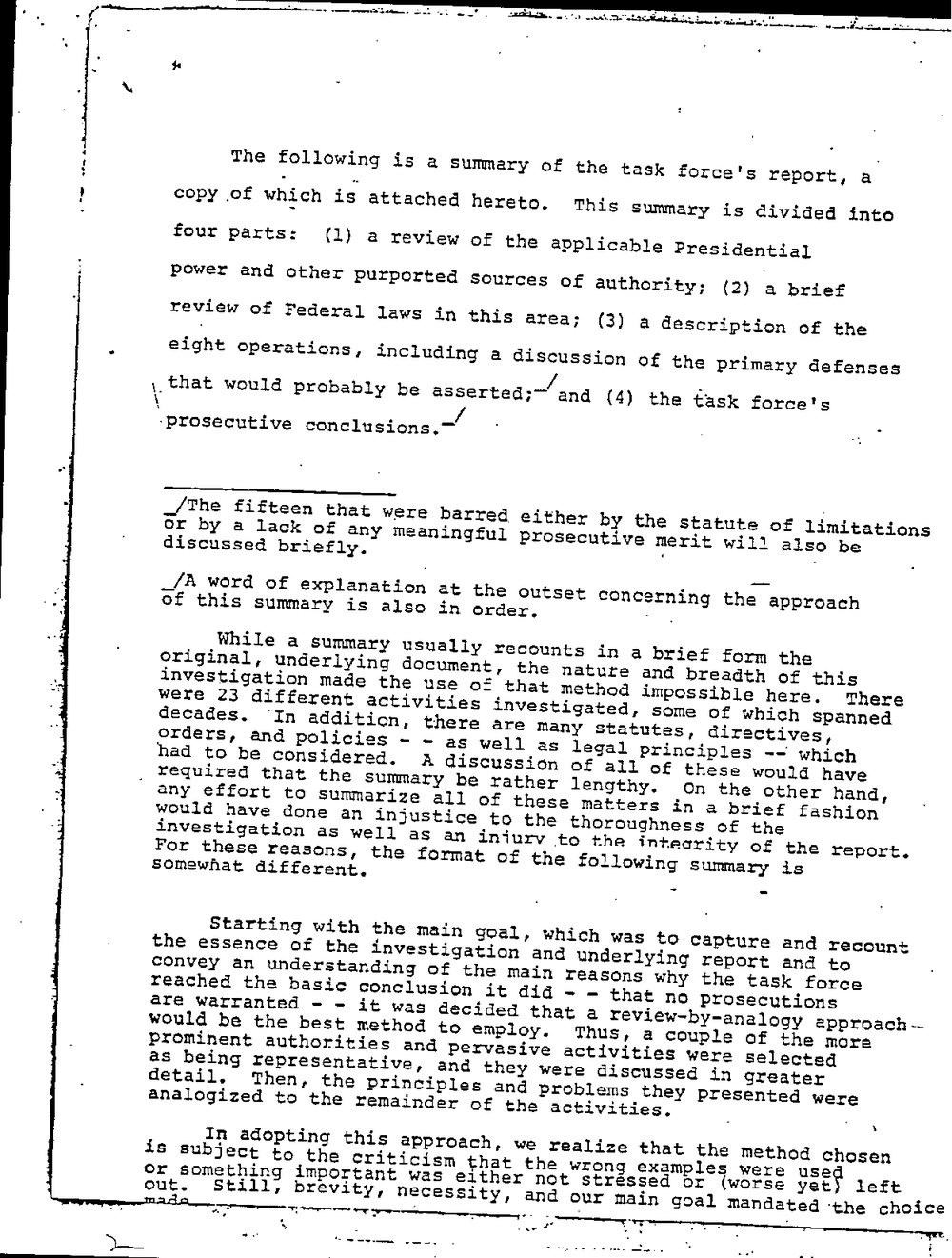
.
. . .t
.1 Flinn L. -
I
. 1" idly
The following is a summary of the task force's report, a-
copy_of which is attached hereto. This summary is divided into
four parts: (1) a review of the applicable Presidential
power and other purported sources of authority; (2) a brief
review of Federal laws in this area; (3) a description of the
eight operations, including a discussion of the primary defenses
_that would probably be (4) the task force's
-prosecutive conclusions.-
or by a lack of any meaningful prosecutive merit will also be
discussed briefly.
word of explanation at the outset concerning the approach
of this summary is also in order. .
While a summary usually recounts in a brief form the
nal, underlying document, the nature and breadth of this
investigation made the use of that method impossible here. There
were 23 different activities investigated, some of which spanned
decades. 'In addition, there are many statutes, directives,
orders, and policies - - as well as legal principles -4 which
'had to be considered. A discussion of all of these would have
are warranted - - it was decided that a review-by-analogy approach~~
would be the best method to employ. Thus, a couple of the more
prominent authorities and pervasive activities were selected
as being representative, and they were discussed in greater
detail. Then, the principles and problems they presented were
analoqized to the remainder of the activities.
In adopting this approach, we realize that the method chosen
is to the criticism that the wrong examples were use
or something important was either not stressed or (worse yet left .
out. Still, brevxty, necessity, and our main goal mandated the chozce
. av?ll
.-.-
..
.
. . .t
.1 Flinn L. -
I
. 1" idly
The following is a summary of the task force's report, a-
copy_of which is attached hereto. This summary is divided into
four parts: (1) a review of the applicable Presidential
power and other purported sources of authority; (2) a brief
review of Federal laws in this area; (3) a description of the
eight operations, including a discussion of the primary defenses
_that would probably be (4) the task force's
-prosecutive conclusions.-
or by a lack of any meaningful prosecutive merit will also be
discussed briefly.
word of explanation at the outset concerning the approach
of this summary is also in order. .
While a summary usually recounts in a brief form the
nal, underlying document, the nature and breadth of this
investigation made the use of that method impossible here. There
were 23 different activities investigated, some of which spanned
decades. 'In addition, there are many statutes, directives,
orders, and policies - - as well as legal principles -4 which
'had to be considered. A discussion of all of these would have
are warranted - - it was decided that a review-by-analogy approach~~
would be the best method to employ. Thus, a couple of the more
prominent authorities and pervasive activities were selected
as being representative, and they were discussed in greater
detail. Then, the principles and problems they presented were
analoqized to the remainder of the activities.
In adopting this approach, we realize that the method chosen
is to the criticism that the wrong examples were use
or something important was either not stressed or (worse yet left .
out. Still, brevxty, necessity, and our main goal mandated the chozce
. av?ll
.-.-
..
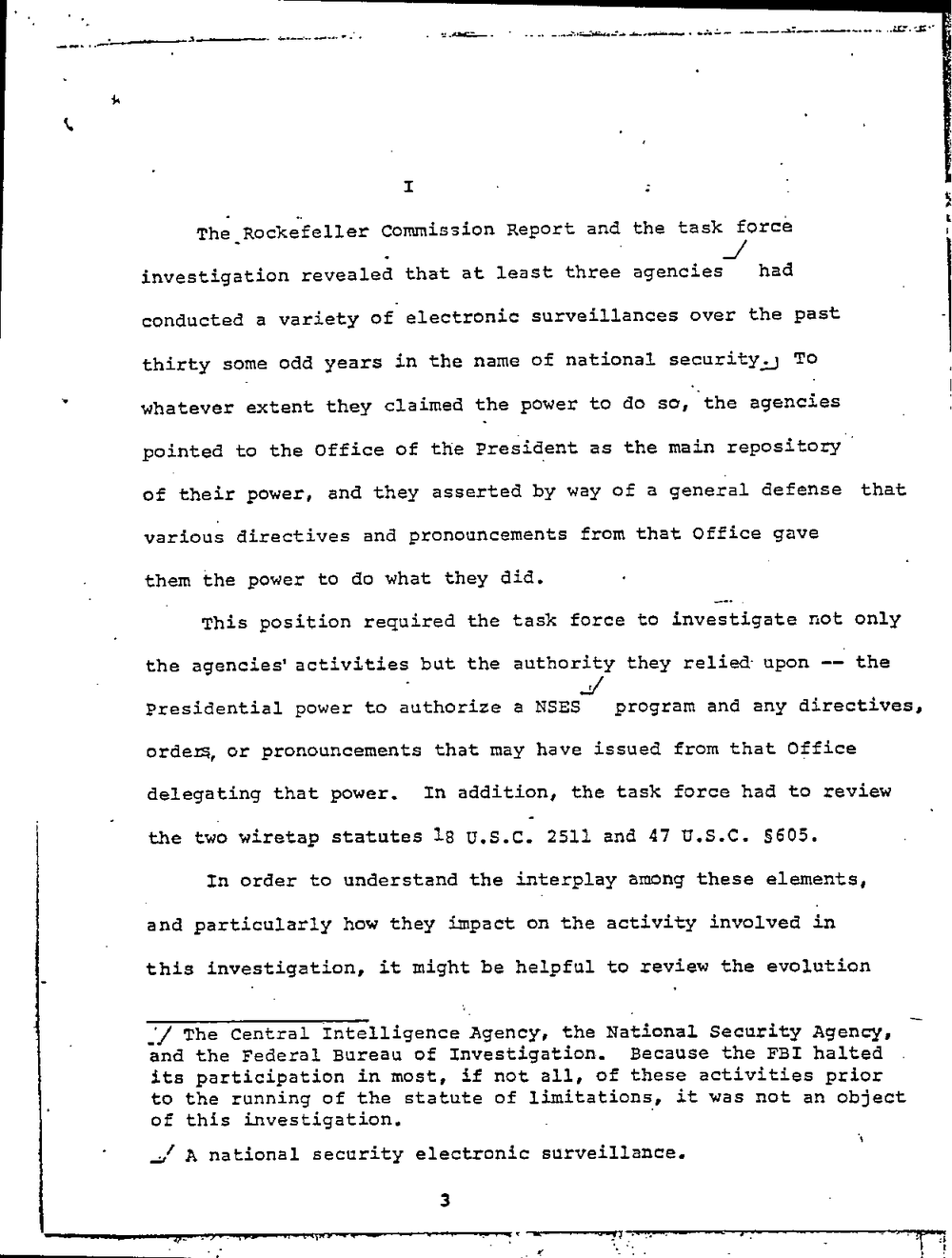
I -
The.Rockefeller Commission Report and the task force
investigation revealed that at least three agencies?/ had
conducted a variety of electronic surveillances over the past
thirty some odd years in the name of national To
whatever extent they claimed the power to do so, the agencies
pointed to the Office of the President as the main repository?
of their power, and they asserted by way of a general defense that
various directives and pronouncements from that Office gave
them the power to do what they did.
- This position required the task force to investigate not only
the agencies?activities but the authority they relied upon the
Presidential power to authorize a program and any directives,
order; or pronouncements that may have issued from that Office
delegating that power. In addition, the task force had to review
the two wiretap statutes 18 U.S.C: 2511 and 47 U.S.C. 5605.
In order to understand the interplay among these elements,
and particularly how they impact on the activity involved in
this investigation, it might be helpful to review the evolution
--.
4/ The Central intelligence Agency, the National Security Agency,
and the Federal Bureau of Investigation. Because the FBI halted
its participation in most, if not all, of these activities prior
to the running of the statute of limitations, it was not an object
of this investigation.
4/ A national security electronic surveillance.
3
J7- . 7 1- r?ql? ?v 1. w?g I
a
I -
The.Rockefeller Commission Report and the task force
investigation revealed that at least three agencies?/ had
conducted a variety of electronic surveillances over the past
thirty some odd years in the name of national To
whatever extent they claimed the power to do so, the agencies
pointed to the Office of the President as the main repository?
of their power, and they asserted by way of a general defense that
various directives and pronouncements from that Office gave
them the power to do what they did.
- This position required the task force to investigate not only
the agencies?activities but the authority they relied upon the
Presidential power to authorize a program and any directives,
order; or pronouncements that may have issued from that Office
delegating that power. In addition, the task force had to review
the two wiretap statutes 18 U.S.C: 2511 and 47 U.S.C. 5605.
In order to understand the interplay among these elements,
and particularly how they impact on the activity involved in
this investigation, it might be helpful to review the evolution
--.
4/ The Central intelligence Agency, the National Security Agency,
and the Federal Bureau of Investigation. Because the FBI halted
its participation in most, if not all, of these activities prior
to the running of the statute of limitations, it was not an object
of this investigation.
4/ A national security electronic surveillance.
3
J7- . 7 1- r?ql? ?v 1. w?g I
a
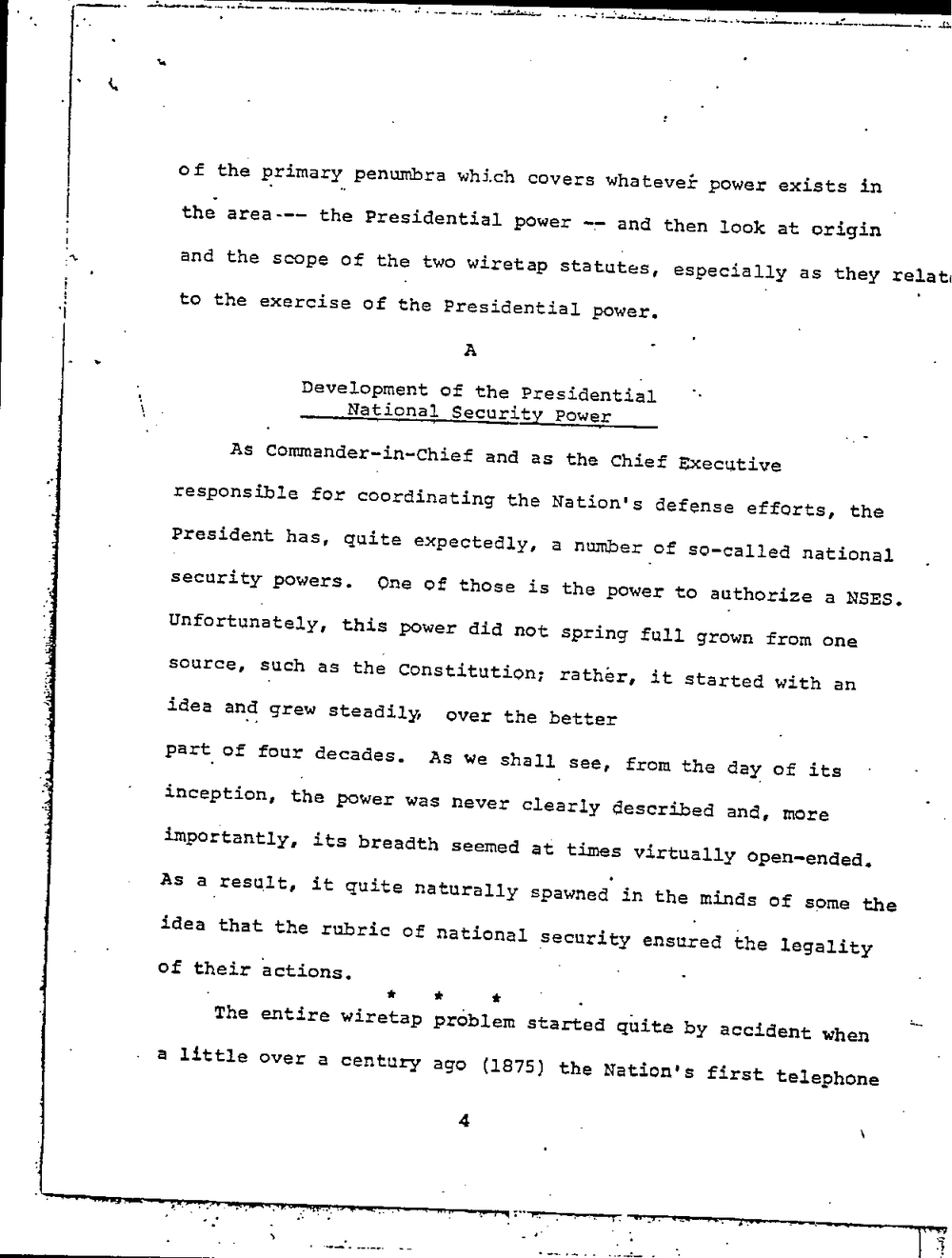
- . .. . . . a
- m. u, -.-.. - 0.. .. . .. .- - .-..
. act??
of the primary penumbra which covers whatever power exists in
the area--? the Presidential power -r and then look at origin
and the scOpe of the two wiretap statutes, especially as they relab
to the exercise of the Presidential power.
A
DeveIOpment of the Presidential
National Security Power
As Commander-in?Chief and as the Chief Executive
reSponsible for coordinating the Nation's defense efforts, the
President has, quite expectedly, a number of so-called national
.
I "All 4..
security powers. One of those is the power to authorize a NSES.
Unfortunately, this power did not spring full grown from one
source, such as the Constitution; rather, it started with an
idea and grew steadily over the better
part of four decades. As we shall See, from the day of its
inception, the power was never clearly described and, more
importantly, its breadth seemed at times virtually open-ended.
As a result, it quite naturally spawned in the minds of some the
idea that the rubric of national security ensured the legality
of their actions.
1 .
The entire wiretap problem started quite by accident when
a little over a century ago (1875) the Nation's first telephone
{r71
- . .. . . . a
- m. u, -.-.. - 0.. .. . .. .- - .-..
. act??
of the primary penumbra which covers whatever power exists in
the area--? the Presidential power -r and then look at origin
and the scOpe of the two wiretap statutes, especially as they relab
to the exercise of the Presidential power.
A
DeveIOpment of the Presidential
National Security Power
As Commander-in?Chief and as the Chief Executive
reSponsible for coordinating the Nation's defense efforts, the
President has, quite expectedly, a number of so-called national
.
I "All 4..
security powers. One of those is the power to authorize a NSES.
Unfortunately, this power did not spring full grown from one
source, such as the Constitution; rather, it started with an
idea and grew steadily over the better
part of four decades. As we shall See, from the day of its
inception, the power was never clearly described and, more
importantly, its breadth seemed at times virtually open-ended.
As a result, it quite naturally spawned in the minds of some the
idea that the rubric of national security ensured the legality
of their actions.
1 .
The entire wiretap problem started quite by accident when
a little over a century ago (1875) the Nation's first telephone
{r71
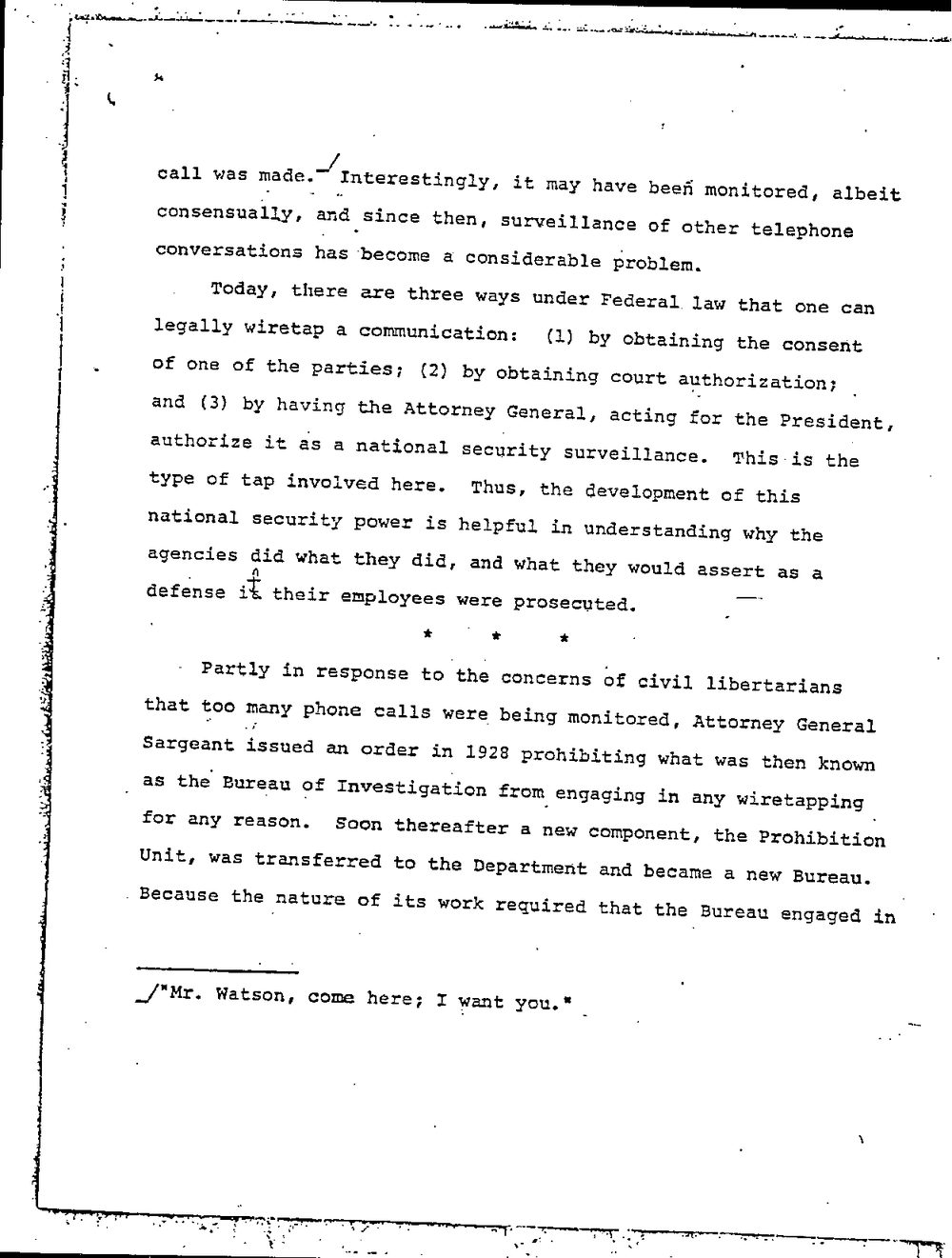
'ILL.auII?call was made.? Interestingly, it may have been monitored, albeit
nu?
f!
consensually, and since then, surveillance of other telephone
conversations has become a considerable problem.
Today, there are three ways under Federal law that one can
-
-
legally wiretap a communication: (1) by obtaining the consent
of one of the parties; (2) by obtaining court authorization;
and (3) by having the Attorney General, acting for the President,
authorize it as a national security surveillance. This-is the
type of tap involved here. Thus, the development of this
national security power is helpful in understanding why the
Mug-J-
agencies did what they did, and what they would assert as a
4.11.
0
defense it their employees were prosecuted.
.
Partly in response to the concerns of civil libertarians
that too many phone calls were being monitored, Attorney General
Sergeant issued an order in 1928 prohibiting what was then known
as the Bureau of InVestigation from engaging in any wiretapping
for any reason. Soon thereafter a new component, the Prohibition
Unit, was transferred to the Department and became a new BureauBecause the nature of its work required that the Bureau engaged in
A
Watson, come here; I want you."
'ILL.auII?call was made.? Interestingly, it may have been monitored, albeit
nu?
f!
consensually, and since then, surveillance of other telephone
conversations has become a considerable problem.
Today, there are three ways under Federal law that one can
-
-
legally wiretap a communication: (1) by obtaining the consent
of one of the parties; (2) by obtaining court authorization;
and (3) by having the Attorney General, acting for the President,
authorize it as a national security surveillance. This-is the
type of tap involved here. Thus, the development of this
national security power is helpful in understanding why the
Mug-J-
agencies did what they did, and what they would assert as a
4.11.
0
defense it their employees were prosecuted.
.
Partly in response to the concerns of civil libertarians
that too many phone calls were being monitored, Attorney General
Sergeant issued an order in 1928 prohibiting what was then known
as the Bureau of InVestigation from engaging in any wiretapping
for any reason. Soon thereafter a new component, the Prohibition
Unit, was transferred to the Department and became a new BureauBecause the nature of its work required that the Bureau engaged in
A
Watson, come here; I want you."
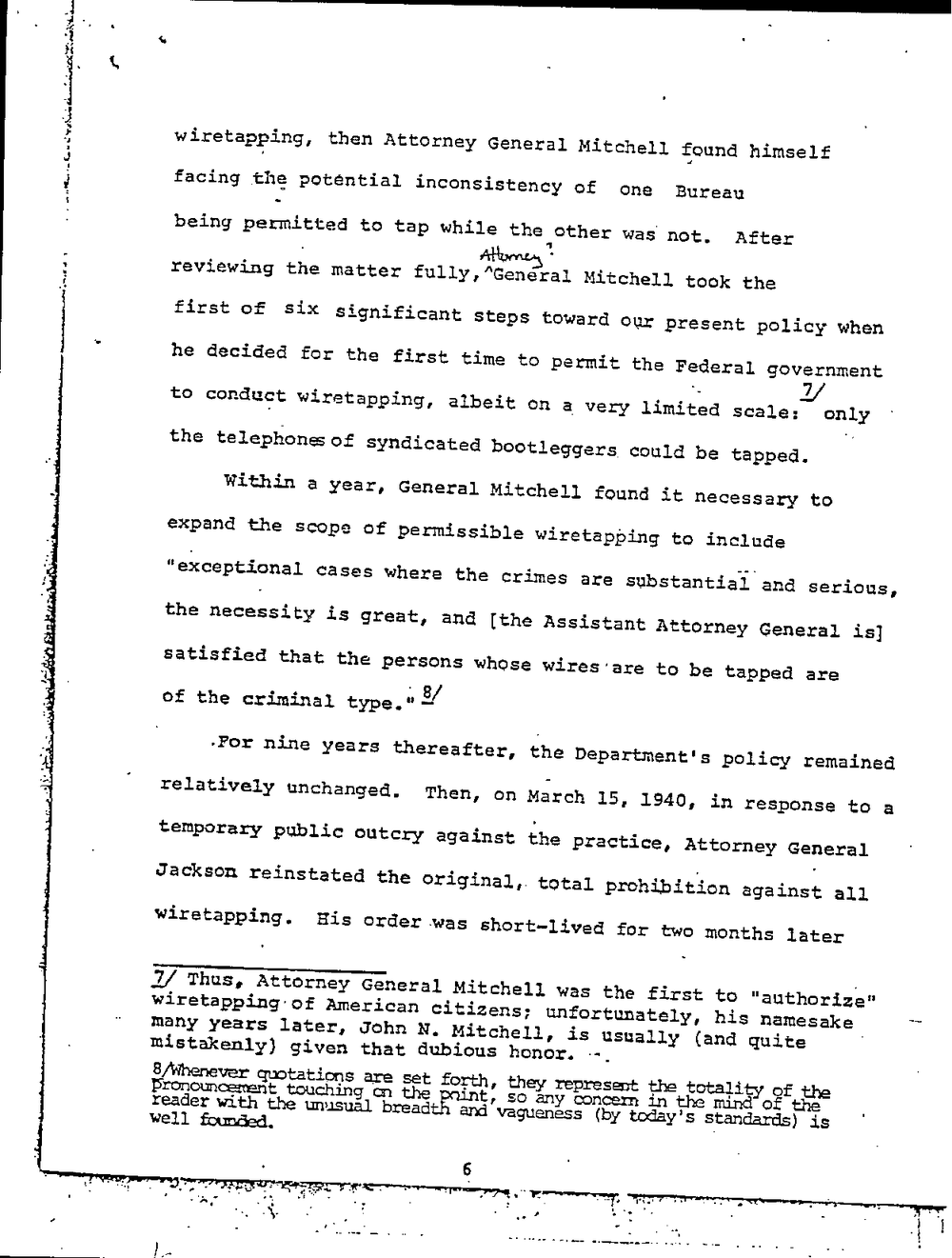
Jihad;
?hlg
wiretapping, then Attorney General Mitchell found himself
facing the potential inconsistency of one Bureau
being permitted to tap while the other was not. After
. a. a
reviewing the matter fully,?General Mitchell took the
first of? six significant steps toward our present policy when
I
I
he decided for the first time to permit the Federal government
-- 2/
to conduct wiretapping, albeit on a very limited scale: only
the telephonesof syndicated bootleggers could be tapped.
Within a year, General Mitchell found it necessary to
expand the scope of permissible wiretapping to include
nun?, ..
"enceptional cases where the crimes are substantial and serious,
the necessity is great, and [the Assistant Attorney General is]
satisfied that the persons whose wireS'are to be tapped are
I I
of the criminal type.?-
.For nine years thereafter, the Department's policy remained
relatively unchanged. Then, on March 15, 1940, in response to a
temporary public outcry against the practice, Attorney General
A
Jackson reinstated the original, total prohibition against all
wiretapping. His order was short-lived for two months later
Thus, Attorney General Mitchell was the first to "authorize"
wiretapping of American citizens: unfortunately, his namesake
many years later, John N. Mitchell, is usually (and quite
mistakenly) given that dubious honor. 4.
pronouncenent touching on the t, so any concern in the nund of
reader with the unusual bread and vagueness (by today's standards) is
well founded.m-o . .-. .
I,
Jihad;
?hlg
wiretapping, then Attorney General Mitchell found himself
facing the potential inconsistency of one Bureau
being permitted to tap while the other was not. After
. a. a
reviewing the matter fully,?General Mitchell took the
first of? six significant steps toward our present policy when
I
I
he decided for the first time to permit the Federal government
-- 2/
to conduct wiretapping, albeit on a very limited scale: only
the telephonesof syndicated bootleggers could be tapped.
Within a year, General Mitchell found it necessary to
expand the scope of permissible wiretapping to include
nun?, ..
"enceptional cases where the crimes are substantial and serious,
the necessity is great, and [the Assistant Attorney General is]
satisfied that the persons whose wireS'are to be tapped are
I I
of the criminal type.?-
.For nine years thereafter, the Department's policy remained
relatively unchanged. Then, on March 15, 1940, in response to a
temporary public outcry against the practice, Attorney General
A
Jackson reinstated the original, total prohibition against all
wiretapping. His order was short-lived for two months later
Thus, Attorney General Mitchell was the first to "authorize"
wiretapping of American citizens: unfortunately, his namesake
many years later, John N. Mitchell, is usually (and quite
mistakenly) given that dubious honor. 4.
pronouncenent touching on the t, so any concern in the nund of
reader with the unusual bread and vagueness (by today's standards) is
well founded.m-o . .-. .
I,
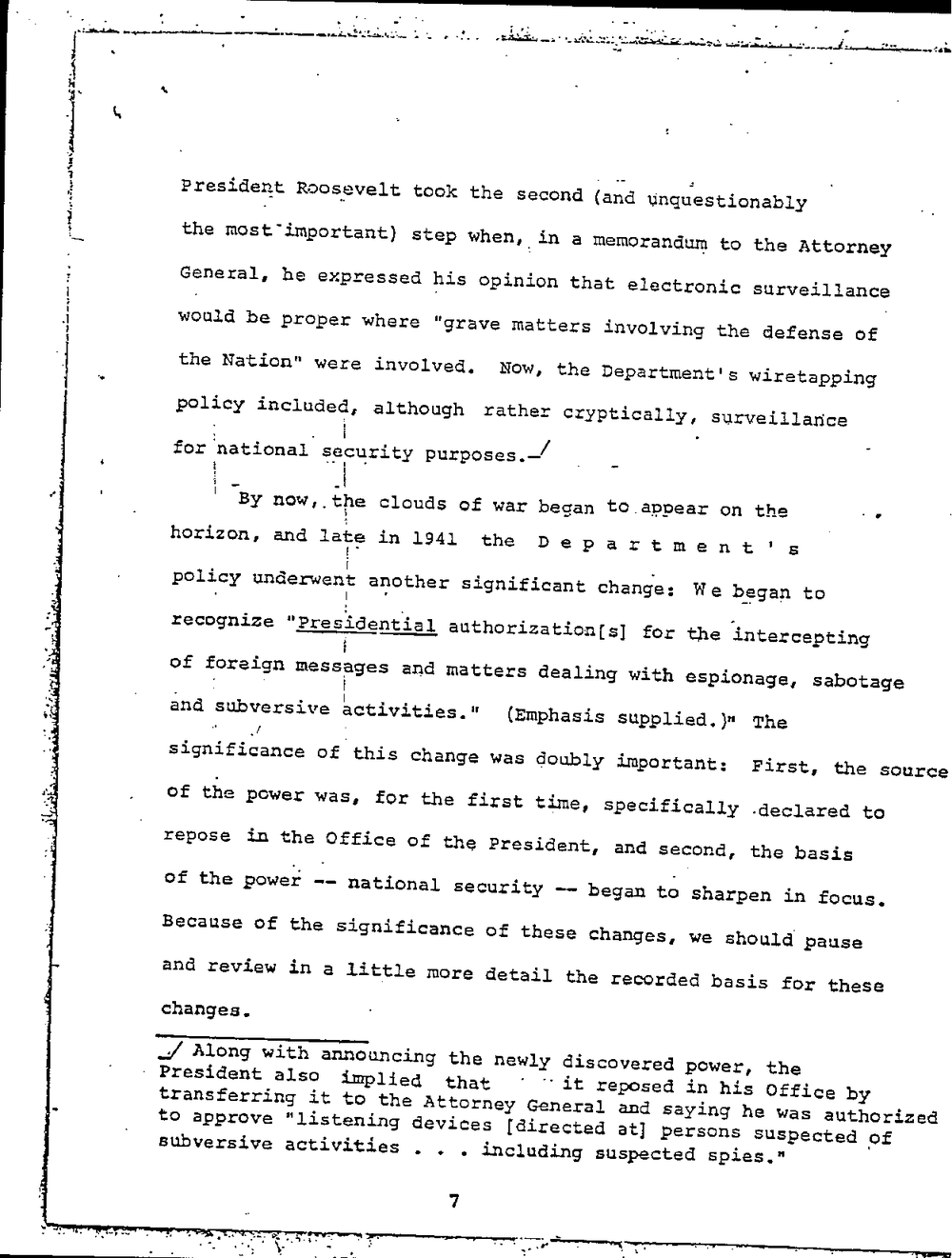
. .4 \ns'w Ilia-5wllm?L??L?me Jun?[mat
cm
.
?1
c.
.I-I
- x. Ling-W.- .ah
President Roosevelt took the second (and unquestionably
the most?important) step when, in a memorandum to the Attorney
General, he expressed his Opinion that electronic surveillance
would be proper where "grave matters involving the defense of
the Nation" were involved. Now, the Department's wiretapping
although rather surveillance
i .
curity purpoaes.?/
By now, the clouds of war began 0n the 'v
horizon, and late in 1941 the a a
i .
policy underwent another significant change: Vie began to
. I
recognize "Presidential authorization[s] for the intercepting
i
of foreign messages and matters dealing with espionage, sabotage
I . . . . .
and subversive actiVities." (EmphaSis supplied.)" The
significance of this change was doubly important: First, the source
power was, for the first time, specifically'.declared to
in the Office of the President, and second, the basis
power 4- national security - began to sharpen in focus.
Because of the significance of these changes,.we should pause
and review in a little more detail the recorded basis for these
Along with announcing the newly discovered power, the
that "it reposed in his Office by
transferring it to the Attorney General and saying he was authorized
to approve "listening devices [directed at] persons suspected of
. . . including suspected spies."
7
policy included,
forinational's
I El
of the
repose
of the
changes.
- President also implied
subversive activities
WT Tz?tf
. .4 \ns'w Ilia-5wllm?L??L?me Jun?[mat
cm
.
?1
c.
.I-I
- x. Ling-W.- .ah
President Roosevelt took the second (and unquestionably
the most?important) step when, in a memorandum to the Attorney
General, he expressed his Opinion that electronic surveillance
would be proper where "grave matters involving the defense of
the Nation" were involved. Now, the Department's wiretapping
although rather surveillance
i .
curity purpoaes.?/
By now, the clouds of war began 0n the 'v
horizon, and late in 1941 the a a
i .
policy underwent another significant change: Vie began to
. I
recognize "Presidential authorization[s] for the intercepting
i
of foreign messages and matters dealing with espionage, sabotage
I . . . . .
and subversive actiVities." (EmphaSis supplied.)" The
significance of this change was doubly important: First, the source
power was, for the first time, specifically'.declared to
in the Office of the President, and second, the basis
power 4- national security - began to sharpen in focus.
Because of the significance of these changes,.we should pause
and review in a little more detail the recorded basis for these
Along with announcing the newly discovered power, the
that "it reposed in his Office by
transferring it to the Attorney General and saying he was authorized
to approve "listening devices [directed at] persons suspected of
. . . including suspected spies."
7
policy included,
forinational's
I El
of the
repose
of the
changes.
- President also implied
subversive activities
WT Tz?tf
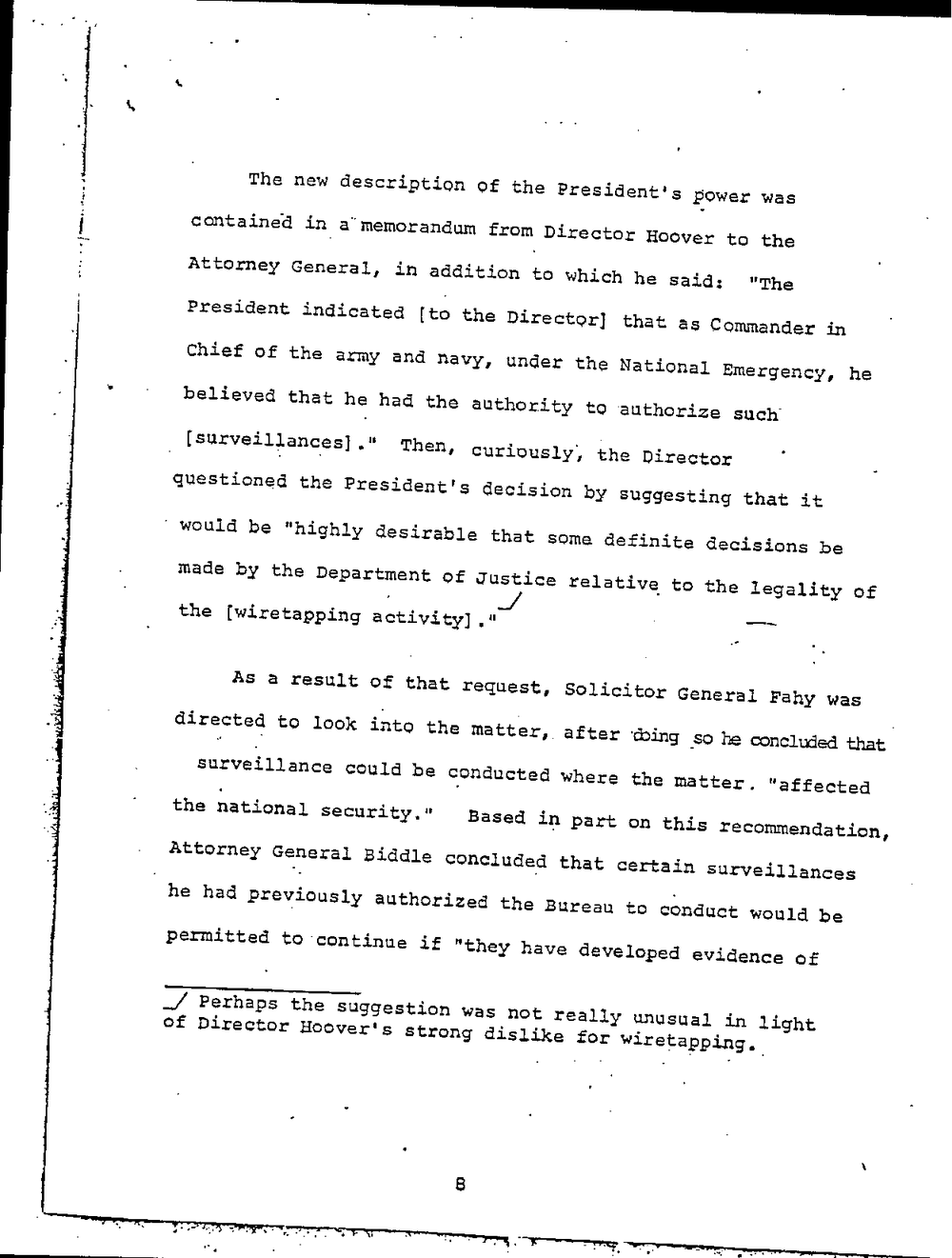
The new description of the President's power was
contained in a memorandum from Director Hoover to the
Attorney General, in addition to which he said: "The
President indicated [to the Director] that as Commander in
Chief of the army and navy, under the National Emergency, he
believed that he had the authority to authorize such?
[surveillanqes]-" Then. curiously, the Director
questioned the President's decision by suggesting that it
made by the Department of Justice relative to the legality of
the [wiretapping activity]."
As a result of that request, Solicitor General Fahy was
directed to look into the matter, after doing _so he concluded that.
surveillance could be conducted where the matter. "affected
the national security." Based in part on this recommendation,
Attorney General Biddle concluded that certain surveillances
he had previously authorized the Bureau to conduct would be
permitted to continue if "they have developed evidence of
Perhaps the suggestion was not really unusual in light
of Director Hoover's strong dislike for wiretapping._
The new description of the President's power was
contained in a memorandum from Director Hoover to the
Attorney General, in addition to which he said: "The
President indicated [to the Director] that as Commander in
Chief of the army and navy, under the National Emergency, he
believed that he had the authority to authorize such?
[surveillanqes]-" Then. curiously, the Director
questioned the President's decision by suggesting that it
made by the Department of Justice relative to the legality of
the [wiretapping activity]."
As a result of that request, Solicitor General Fahy was
directed to look into the matter, after doing _so he concluded that.
surveillance could be conducted where the matter. "affected
the national security." Based in part on this recommendation,
Attorney General Biddle concluded that certain surveillances
he had previously authorized the Bureau to conduct would be
permitted to continue if "they have developed evidence of
Perhaps the suggestion was not really unusual in light
of Director Hoover's strong dislike for wiretapping._
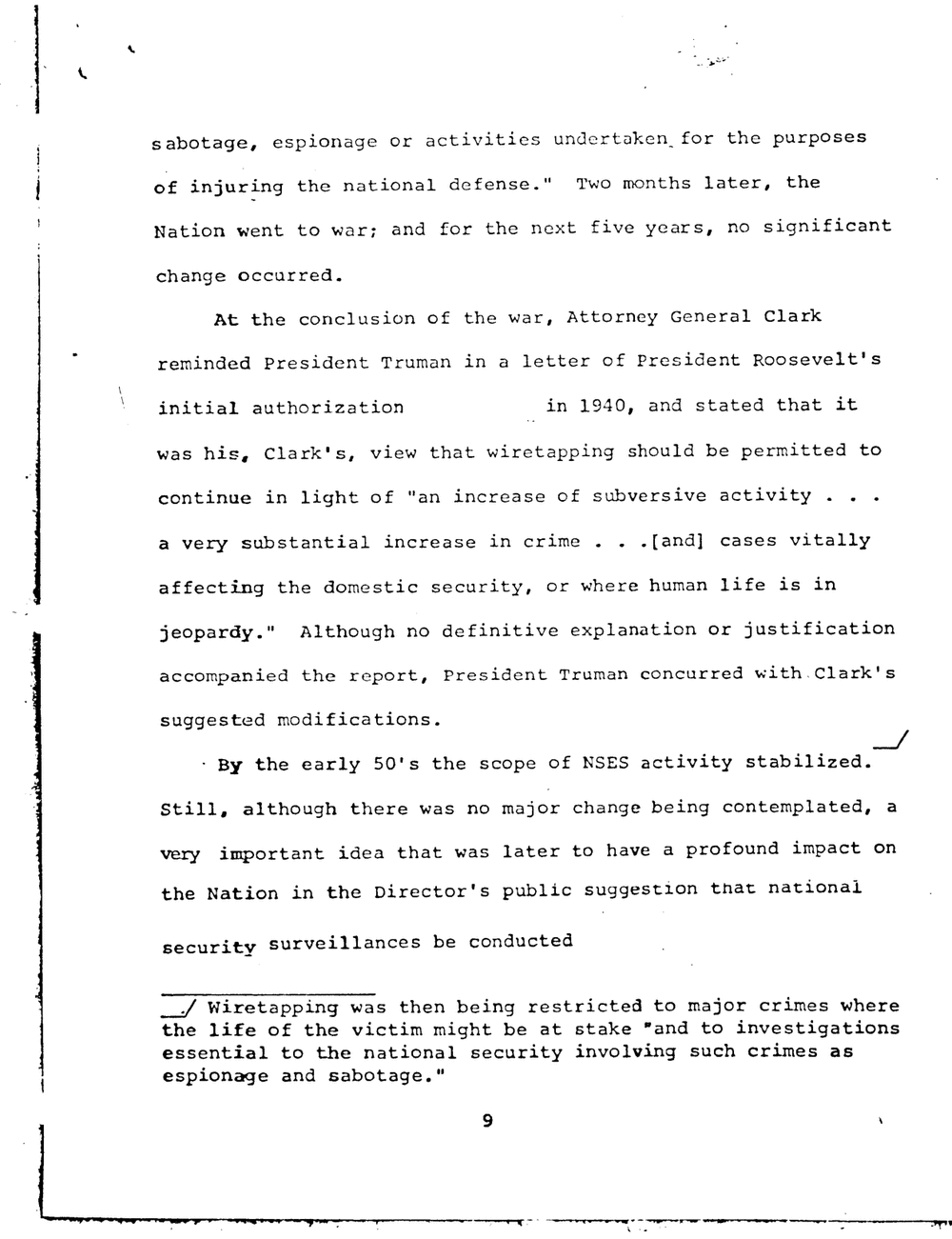
v-?yv-v
sabotage, eSpionage or activities undertaken?for the purposes
of injuring the national defense.? Two months later, the
Nation went to war; and for the next five years, no significant
change occurred.
At the conclusion of the war, Attorney General Clark
reminded President Truman in a letter of President Roosevelt's
initial authorization .in 1940, and stated that it
was his, Clark's, view that wiretapping should be permitted to
continue in light of "an increase of subversive activity . . .
a very substantial increase in crime . . .[and] cases vitally
affecting the domestic security, or where human life is in
jeopardy." Although no definitive eXplanation or justification
accompanied the report, President Truman concurred with Clark's
suggested modifications.
- By the early 50's the scope of NSES activity
Still, although there was no major change being contemplated, a
van] important idea that was later to have a profound impact on
the Nation in the Director's public suggestion that national
securitv surveillances be conducted
Wiretapping was then being restricted to major crimes where
the life of the victim might be at stake "and to investigations
essential to the national security involving such crimes as
eSpionage and sabotage."
.
..
v-?yv-v
sabotage, eSpionage or activities undertaken?for the purposes
of injuring the national defense.? Two months later, the
Nation went to war; and for the next five years, no significant
change occurred.
At the conclusion of the war, Attorney General Clark
reminded President Truman in a letter of President Roosevelt's
initial authorization .in 1940, and stated that it
was his, Clark's, view that wiretapping should be permitted to
continue in light of "an increase of subversive activity . . .
a very substantial increase in crime . . .[and] cases vitally
affecting the domestic security, or where human life is in
jeopardy." Although no definitive eXplanation or justification
accompanied the report, President Truman concurred with Clark's
suggested modifications.
- By the early 50's the scope of NSES activity
Still, although there was no major change being contemplated, a
van] important idea that was later to have a profound impact on
the Nation in the Director's public suggestion that national
securitv surveillances be conducted
Wiretapping was then being restricted to major crimes where
the life of the victim might be at stake "and to investigations
essential to the national security involving such crimes as
eSpionage and sabotage."
.
..
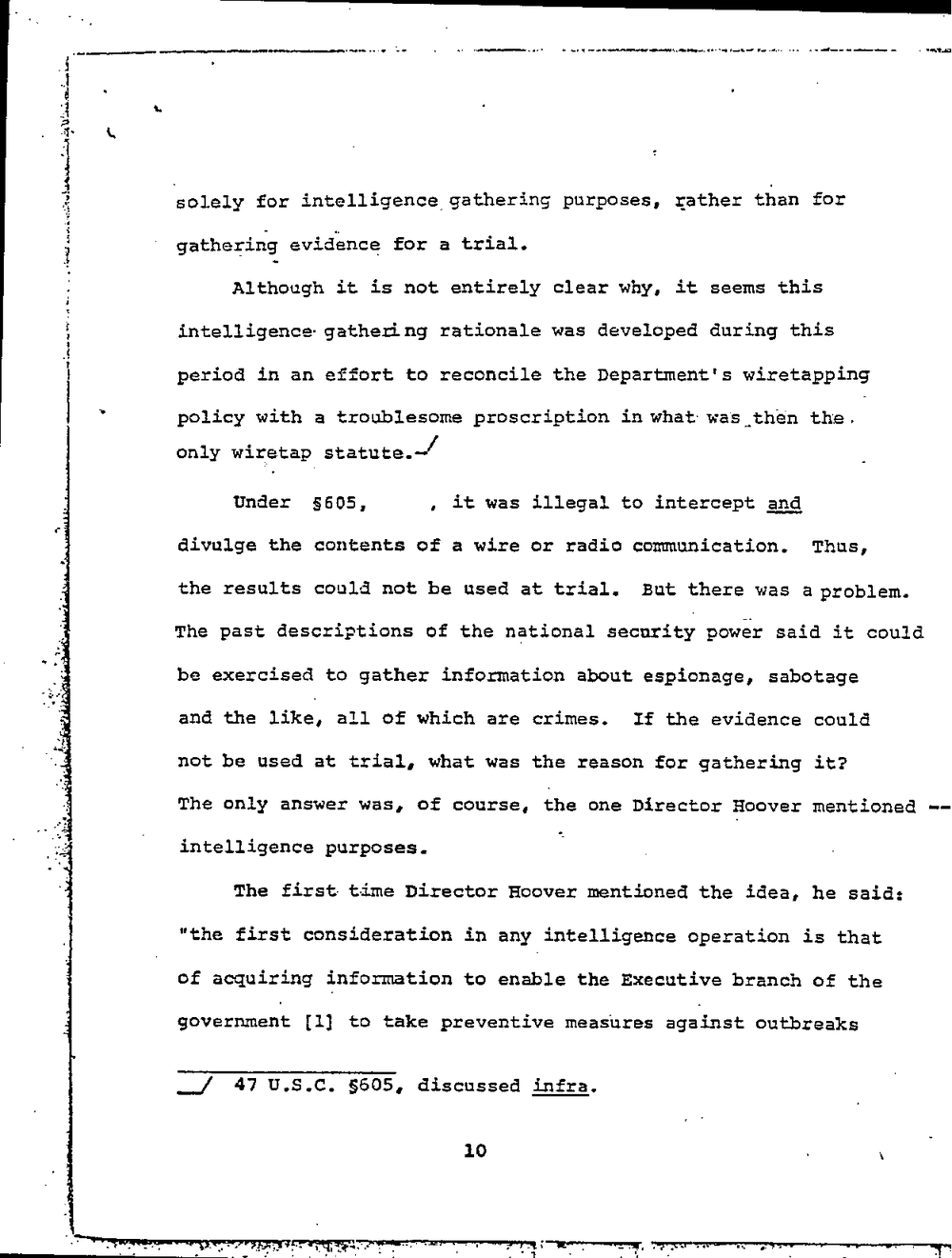
?ui
. ?auxinIn. ?lanai
?ink
clau? dun-n? .
Isolely for intelligence gathering purposes, rather than for
gathering evidence for a trial.
Although it is not entirely clear why, it seems this
intelligence-gathering rationale was develoPed during this
period in an effort to reconcile the Department's wiretapping
policy with a troublesome proscription innwhat-was?then the.-
only wiretap statute.-/
Under 5605, it was illegal to intercept and
divulge the contents of a wire or radio communication. Thus,
the results could not be used at trial. But there was a problem.
The past descriptions of the national security power said it could
be exercised to gather information about sepionage, sabotage
and the like. all of which are crimes. If the evidence could
not be used at trial, what was the reason for gathering it?
The only answer was, of course, the one Director Hoover mentioned --
intelligence purposes.
The first-time Director Hoover mentioned the idea, he said:
"the first consideration in any intelligence operation is that
of acquiring information to enable the Executive branch of the
government to take preventive measures against outbreaks
47 U.S.C. ?605, discussed infra.
10 -
?ui
. ?auxinIn. ?lanai
?ink
clau? dun-n? .
Isolely for intelligence gathering purposes, rather than for
gathering evidence for a trial.
Although it is not entirely clear why, it seems this
intelligence-gathering rationale was develoPed during this
period in an effort to reconcile the Department's wiretapping
policy with a troublesome proscription innwhat-was?then the.-
only wiretap statute.-/
Under 5605, it was illegal to intercept and
divulge the contents of a wire or radio communication. Thus,
the results could not be used at trial. But there was a problem.
The past descriptions of the national security power said it could
be exercised to gather information about sepionage, sabotage
and the like. all of which are crimes. If the evidence could
not be used at trial, what was the reason for gathering it?
The only answer was, of course, the one Director Hoover mentioned --
intelligence purposes.
The first-time Director Hoover mentioned the idea, he said:
"the first consideration in any intelligence operation is that
of acquiring information to enable the Executive branch of the
government to take preventive measures against outbreaks
47 U.S.C. ?605, discussed infra.
10 -
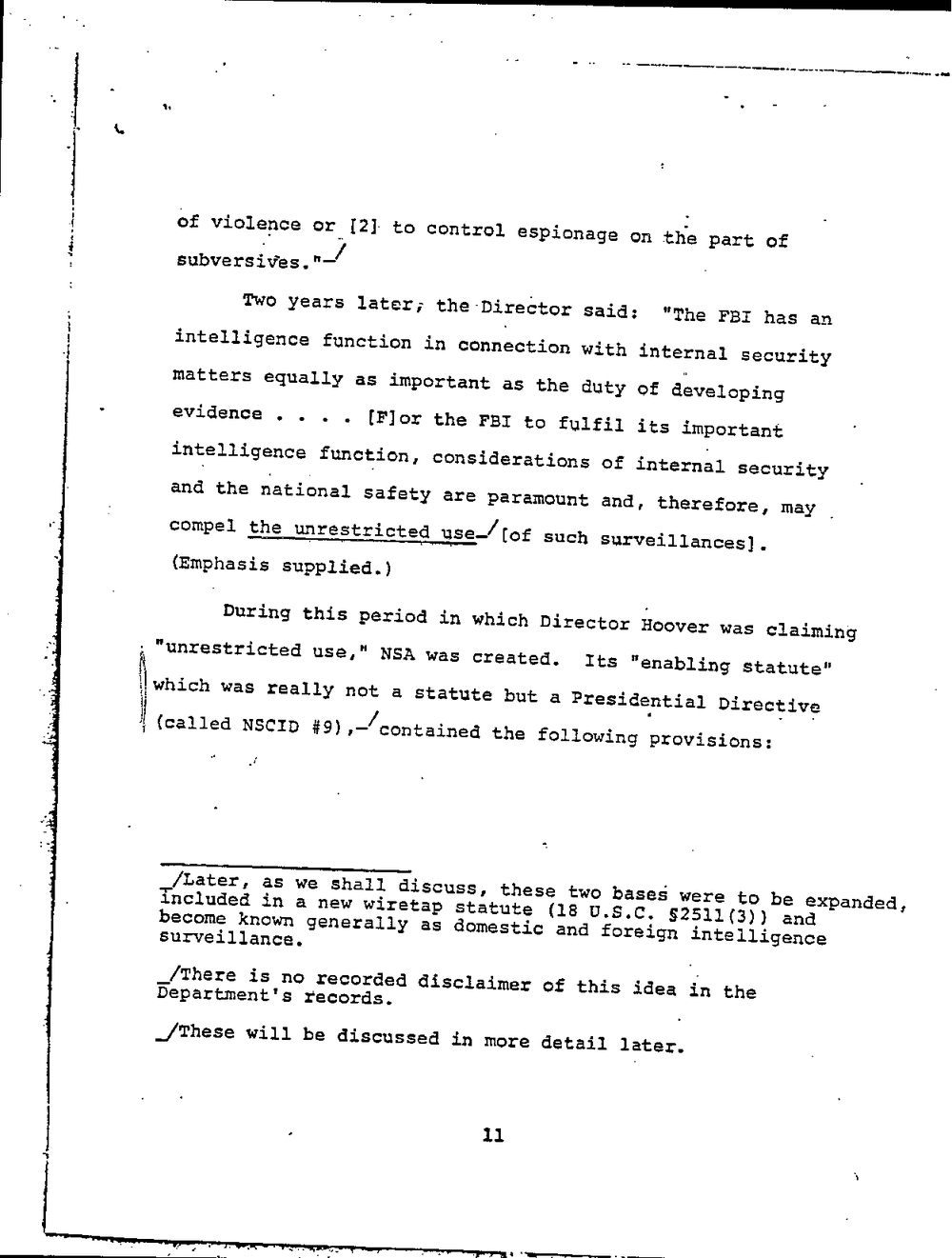
.. John.
?gl?
.. 1
I
A
.muLAm
of violence or [21 to control espionage on the part of
subversives."-
Two years later; the-Director said: "The FBI has an
intelligence function in connection with internal security
matters equally as important as the duty of developing
evidence . . . . [Flor the FBI to fulfil its important
intelligence function, considerations of internal security
and the national safety are paramount and, therefore, may
compel the unrestricted such surveillances].
(Emphasis supplied.)
During this period in which Director Hoover was claiming
"unrestricted use," NSA was created. Its ?enabling statute"
ggwhich was really not a statute but a Presidential Directive
.
i(called NSCID the following provisions:
/Later, as we shall discuss, these two bases were to be expanded,
included in a new wiretap statute (18 U.S.C. 52511(3)) and
_/There is no recorded disclaimer of this idea in the
Department's records.
_/These will be discussed in more detail later.
.. John.
?gl?
.. 1
I
A
.muLAm
of violence or [21 to control espionage on the part of
subversives."-
Two years later; the-Director said: "The FBI has an
intelligence function in connection with internal security
matters equally as important as the duty of developing
evidence . . . . [Flor the FBI to fulfil its important
intelligence function, considerations of internal security
and the national safety are paramount and, therefore, may
compel the unrestricted such surveillances].
(Emphasis supplied.)
During this period in which Director Hoover was claiming
"unrestricted use," NSA was created. Its ?enabling statute"
ggwhich was really not a statute but a Presidential Directive
.
i(called NSCID the following provisions:
/Later, as we shall discuss, these two bases were to be expanded,
included in a new wiretap statute (18 U.S.C. 52511(3)) and
_/There is no recorded disclaimer of this idea in the
Department's records.
_/These will be discussed in more detail later.
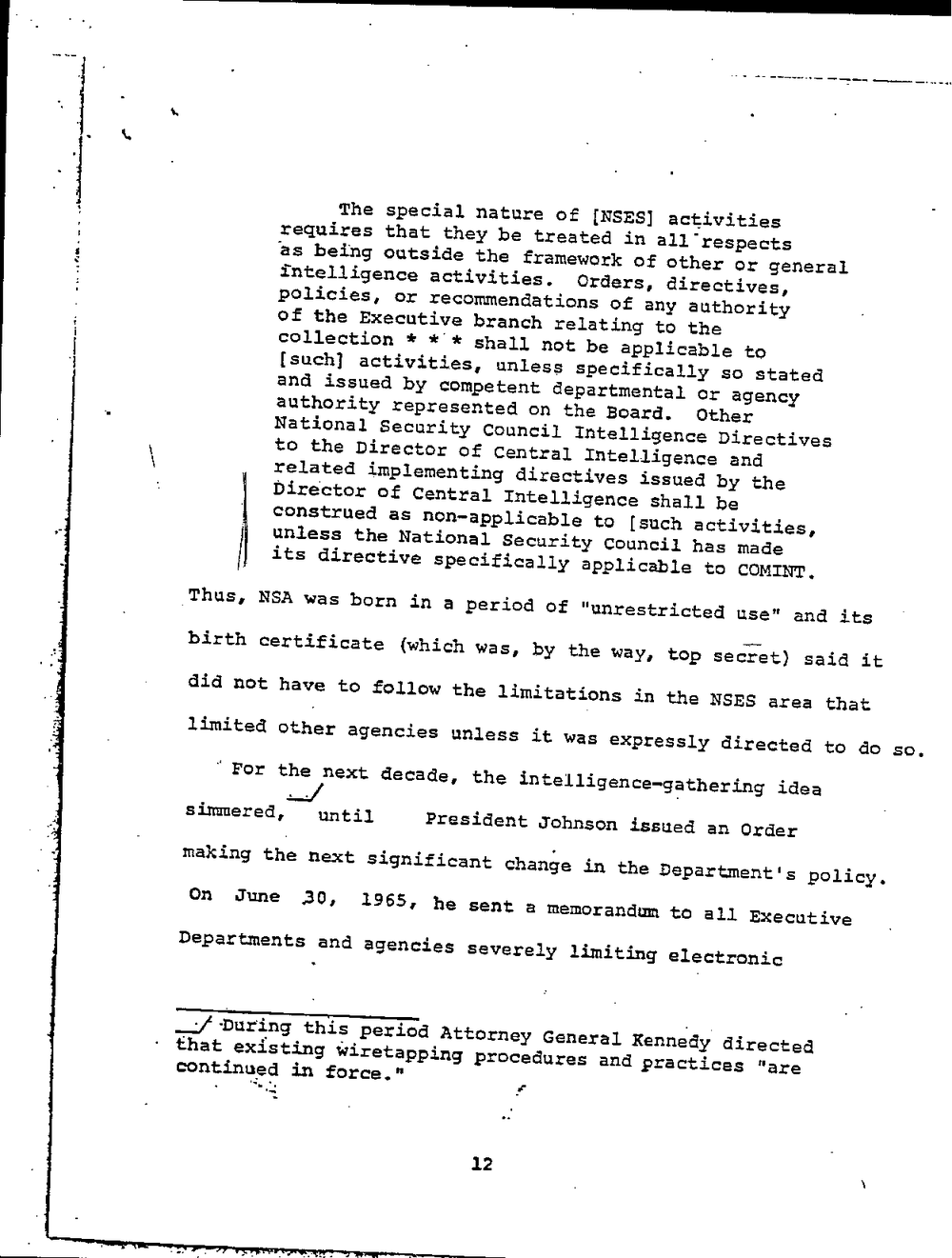
.11?1. i
A.
quLi I 'th?A
. .. -
The special nature of activities
requires that they be treated in all'resPects
as being outside the framework of other or general
intelligence activities. Orders, directives,
policies, or recommendations of any authority
of the Executive branch relating to the
collection shall not be applicable to
[such] activities, unless specifically so stated
and issued by competent departmental or agency
authority represented on the Board.
National Security Council Intelligence Directives
to the Director of Central Intelligence and
related implementing directives issued by the
Director of Central Intelligence shall be
construed as non-applicable to [such activities,
unless the National Security Council has made
its directive specifically applicable to COMINT.
VThus, NSA was born in a period of "unrestricted use" and its
birth certificate (which was, by the way, top secret) said it
did not have to follow the limitations in the N838 area that
limited other agencies unless it was expressly directed to do so
the intelligence-gathering idea
President Johnson issued an Order
making the next significant change in the Department's policy.
1965: he sent a memorandum to all Executive
Departments and agencies severely limiting electronic
During this period Attorney General Kennedy directed
that existing wiretapping procedures and practices "are
12
?For the next decade,
simmered, until
On June 30,
continued in force."
1:7 r'_'17 r}7711-' V3111:
.11?1. i
A.
quLi I 'th?A
. .. -
The special nature of activities
requires that they be treated in all'resPects
as being outside the framework of other or general
intelligence activities. Orders, directives,
policies, or recommendations of any authority
of the Executive branch relating to the
collection shall not be applicable to
[such] activities, unless specifically so stated
and issued by competent departmental or agency
authority represented on the Board.
National Security Council Intelligence Directives
to the Director of Central Intelligence and
related implementing directives issued by the
Director of Central Intelligence shall be
construed as non-applicable to [such activities,
unless the National Security Council has made
its directive specifically applicable to COMINT.
VThus, NSA was born in a period of "unrestricted use" and its
birth certificate (which was, by the way, top secret) said it
did not have to follow the limitations in the N838 area that
limited other agencies unless it was expressly directed to do so
the intelligence-gathering idea
President Johnson issued an Order
making the next significant change in the Department's policy.
1965: he sent a memorandum to all Executive
Departments and agencies severely limiting electronic
During this period Attorney General Kennedy directed
that existing wiretapping procedures and practices "are
12
?For the next decade,
simmered, until
On June 30,
continued in force."
1:7 r'_'17 r}7711-' V3111:
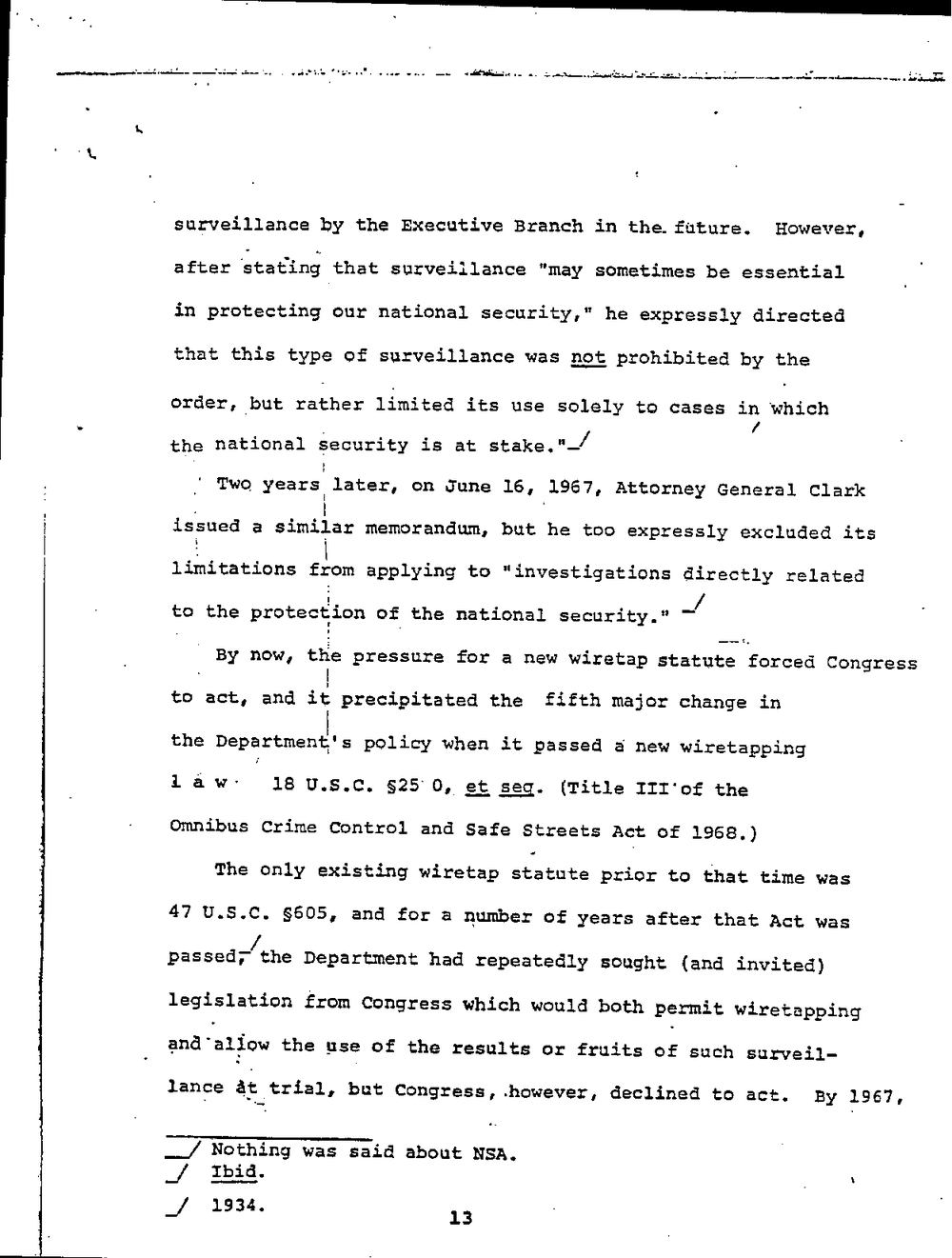
Lusurveillance by the Executive Branch in the.future. However,
after stating that surveillance "may sometimes be essential
in protecting our national security,? he expressly directed
that this type of surveillance was not prohibited by the
order, but rather limited its use solely to cases in which
the national security is at
Two yearsglater, on June 16, 1967, Attorney General Clark
.
issued a similar memorandum, but he too expressly excluded its
i
a
limitations from applying to "investigations directly related
to the protection of the national security."
By now, the pressure for a new wiretap statute forced Congress
to act, and i; precipitated the fifth major change in
the Department's policy when it passed a new wiretapping
1 a w- I 18 U.S.C. ?25 O, 33 Egg. (Title the
Omnibus Crime Control and Safe Streets Act of 1968.)
The only existing wiretap statute prior to that time was
47 U.S.C. 5505, and for a number of years after that Act was
passedr/the Department had repeatedly sought (and invited)
legislation from Congress which would both permit wiretapping
and'allow the use of the results or fruits of such surveil-
lance at trial, but Congress,.however, declined to act. By 1967,
Nothing was said about NSA.
Ibid. .
1934. 13
Lusurveillance by the Executive Branch in the.future. However,
after stating that surveillance "may sometimes be essential
in protecting our national security,? he expressly directed
that this type of surveillance was not prohibited by the
order, but rather limited its use solely to cases in which
the national security is at
Two yearsglater, on June 16, 1967, Attorney General Clark
.
issued a similar memorandum, but he too expressly excluded its
i
a
limitations from applying to "investigations directly related
to the protection of the national security."
By now, the pressure for a new wiretap statute forced Congress
to act, and i; precipitated the fifth major change in
the Department's policy when it passed a new wiretapping
1 a w- I 18 U.S.C. ?25 O, 33 Egg. (Title the
Omnibus Crime Control and Safe Streets Act of 1968.)
The only existing wiretap statute prior to that time was
47 U.S.C. 5505, and for a number of years after that Act was
passedr/the Department had repeatedly sought (and invited)
legislation from Congress which would both permit wiretapping
and'allow the use of the results or fruits of such surveil-
lance at trial, but Congress,.however, declined to act. By 1967,
Nothing was said about NSA.
Ibid. .
1934. 13
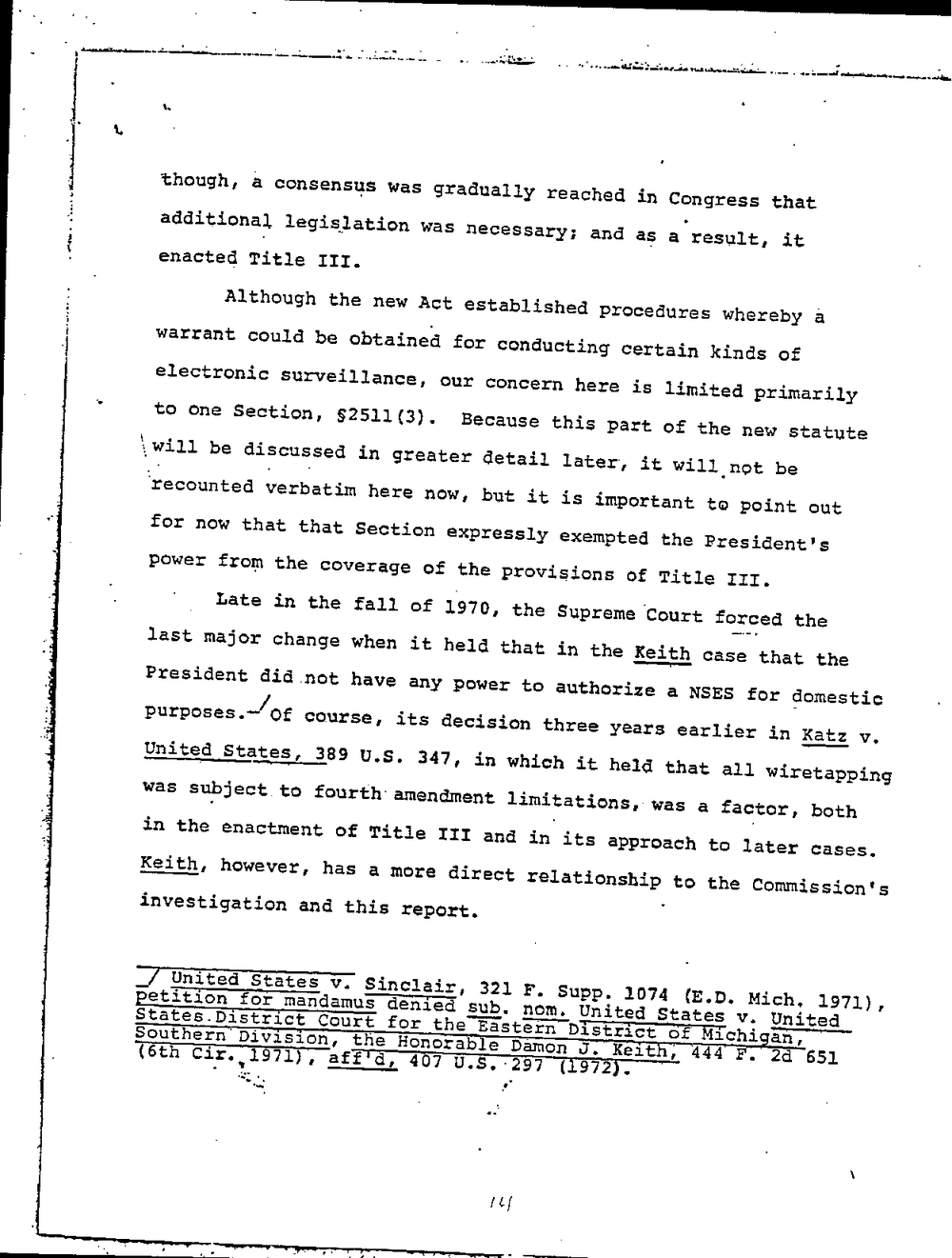
..
.?hhnu
. though, a consensus was gradually reached in Congress that
additional legislation was necessary; and as a result, it
enacted Title
Although the new Act established procedures whereby a
warrant could be obtained for conducting certain kinds of
electronic surveillance, our concern here is limited primarily
to one Section, $2511(3). Because this part of the new statute
twill be discussed in greater detail later, it willanot be
:recounted verbatim here now, but it is important to point out
for now that that Section expressly exempted the President's
power from the coverage of the provisions of Title
Late in the fall of 1S70, the Supreme Court forced the
last major change when it held that in the Egith case that the
President did not have any power to authorize a NSES for domestic
course, its decision three years earlier in get; v.
United States, 389 0.8. 347, in which it held that all wiretapping
was subject.to fourth amendment limitations, was a factor, both
in the enactment of Title and in its approach to later cases.
ggigh, however, has a more direct relationship to the Commission's
investigation and this report.
United States v. Sinclair, 321 F. Supp. 1074 (3.0. Mich. 1971),
petition for mandamus denied sub. nom. United States v. United
States.District Court for the?Eastern District of? ichigan,
Southern Division, the Honorable Damon J. Keith, 444 F. 2d 651
(6th aff'd, 407 U.S. 297 (1972?vjvj ., '11:
l.
.
..
.?hhnu
. though, a consensus was gradually reached in Congress that
additional legislation was necessary; and as a result, it
enacted Title
Although the new Act established procedures whereby a
warrant could be obtained for conducting certain kinds of
electronic surveillance, our concern here is limited primarily
to one Section, $2511(3). Because this part of the new statute
twill be discussed in greater detail later, it willanot be
:recounted verbatim here now, but it is important to point out
for now that that Section expressly exempted the President's
power from the coverage of the provisions of Title
Late in the fall of 1S70, the Supreme Court forced the
last major change when it held that in the Egith case that the
President did not have any power to authorize a NSES for domestic
course, its decision three years earlier in get; v.
United States, 389 0.8. 347, in which it held that all wiretapping
was subject.to fourth amendment limitations, was a factor, both
in the enactment of Title and in its approach to later cases.
ggigh, however, has a more direct relationship to the Commission's
investigation and this report.
United States v. Sinclair, 321 F. Supp. 1074 (3.0. Mich. 1971),
petition for mandamus denied sub. nom. United States v. United
States.District Court for the?Eastern District of? ichigan,
Southern Division, the Honorable Damon J. Keith, 444 F. 2d 651
(6th aff'd, 407 U.S. 297 (1972?vjvj ., '11:
l.
.
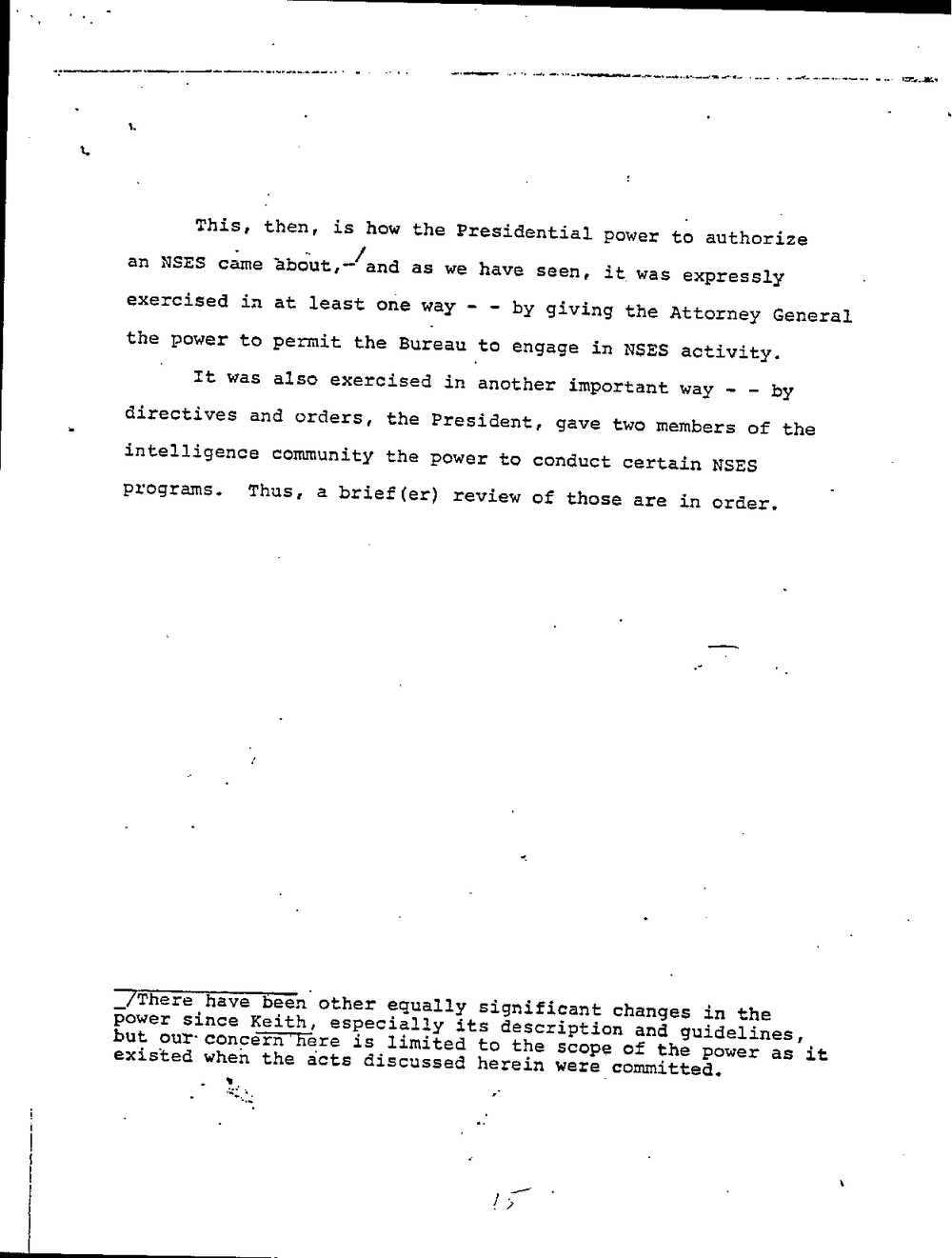
I dun?CThis, then, is how the Presidential power to authorize
an NSES came "about,
-/and as we have seen,
it_was expressly
exercised in at least one way - - by giving the Attorney General
the power to permit the Bureau to engage in NSES activity.
It was also exercised in another important way - - by
directives and orders, the President,
gave two members of the
intelligence community the power to conduct certain NSES
programs.
_/There have Been 0
power since Keith,
but our concern'?er
existed when the ac
.
0..
-
Thus, a brief(er) review of those are in order.
ther equally significant changes in the
especially its descrip
is limited to the sc
ts discussed herein we
'1
tion and guidelines,
ope of the power as it
rencommitted.
4- .n u.
I dun?CThis, then, is how the Presidential power to authorize
an NSES came "about,
-/and as we have seen,
it_was expressly
exercised in at least one way - - by giving the Attorney General
the power to permit the Bureau to engage in NSES activity.
It was also exercised in another important way - - by
directives and orders, the President,
gave two members of the
intelligence community the power to conduct certain NSES
programs.
_/There have Been 0
power since Keith,
but our concern'?er
existed when the ac
.
0..
-
Thus, a brief(er) review of those are in order.
ther equally significant changes in the
especially its descrip
is limited to the sc
ts discussed herein we
'1
tion and guidelines,
ope of the power as it
rencommitted.
4- .n u.
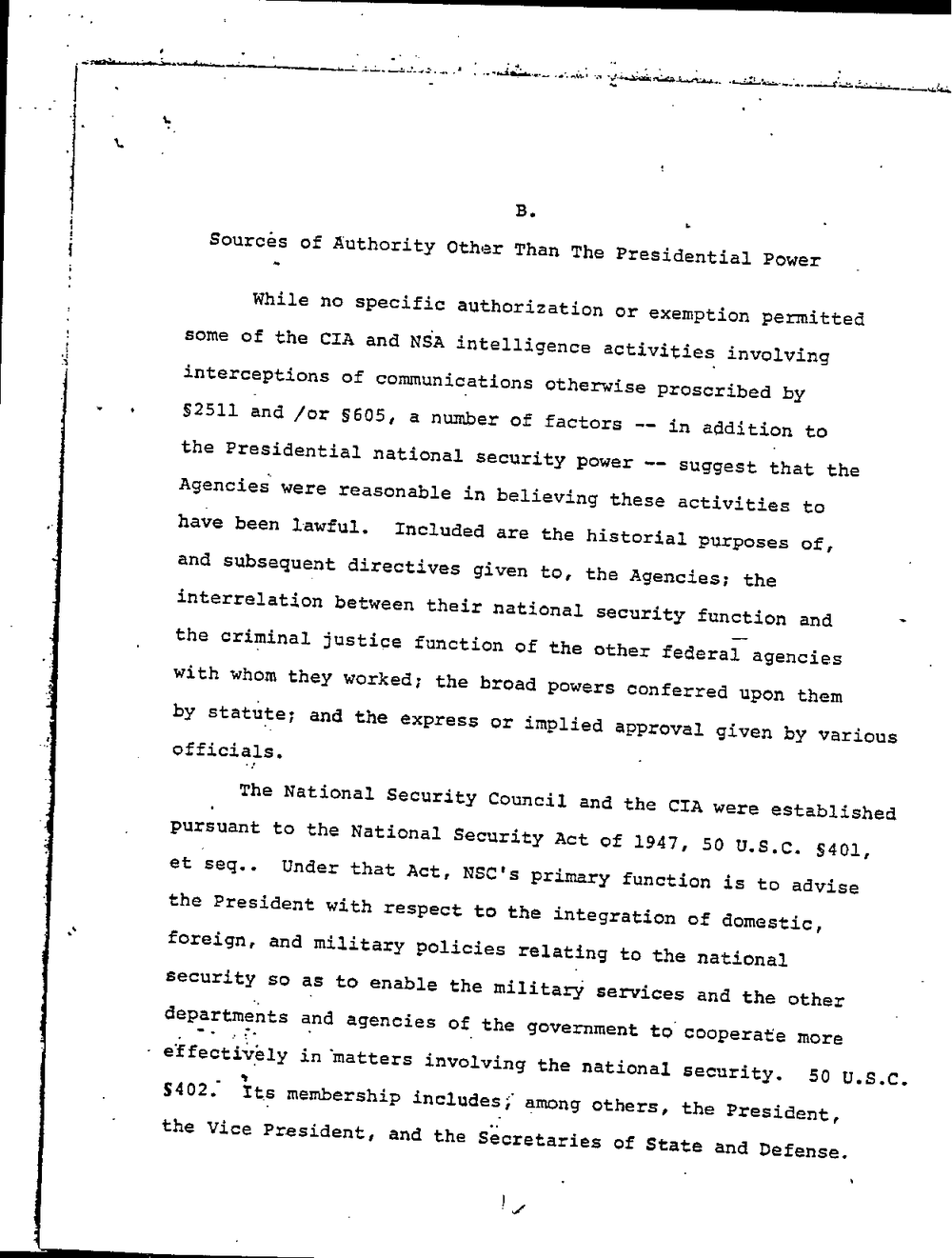
- .. ?.u-wo-hl
- effectively in?matters involving the national security.
E.
Sources of Authority Other Than The Presidential Power
While no specific authoriZation or exemption permitted
some of the CIA and NSA intelligence activities involving
interceptions of communications otherwise proscribed by
52511 and /or 5605, a number of factors -- in addition to
the Presidential national security power suggest that the
Agencies were reasonable in believing these activities to
have been lawful. Included are the historial purposes of,
and subsequent directives given to, the Agencies; the
interrelation between their national security function and
the criminal justice function of the other federal-agencies
with whom they worked; the broad powers conferred upon them
by statute; and the express or implied approval given by various
officials.
The National Security Council and the CIA were established
pursuant to the National Security Act of 1947, 50 U.S.C. S401,
et?seq.. Under that Act, NSC's primary function is to advise
the President with respect to the integration of domestic,
foreign,
departments and agencies of the government to cooperate more
50 U.S.C.
. 1 .
5402. Its membership includes; among others, the President,
the Vice President, and the Secretaries of State and Defense.
- .. ?.u-wo-hl
- effectively in?matters involving the national security.
E.
Sources of Authority Other Than The Presidential Power
While no specific authoriZation or exemption permitted
some of the CIA and NSA intelligence activities involving
interceptions of communications otherwise proscribed by
52511 and /or 5605, a number of factors -- in addition to
the Presidential national security power suggest that the
Agencies were reasonable in believing these activities to
have been lawful. Included are the historial purposes of,
and subsequent directives given to, the Agencies; the
interrelation between their national security function and
the criminal justice function of the other federal-agencies
with whom they worked; the broad powers conferred upon them
by statute; and the express or implied approval given by various
officials.
The National Security Council and the CIA were established
pursuant to the National Security Act of 1947, 50 U.S.C. S401,
et?seq.. Under that Act, NSC's primary function is to advise
the President with respect to the integration of domestic,
foreign,
departments and agencies of the government to cooperate more
50 U.S.C.
. 1 .
5402. Its membership includes; among others, the President,
the Vice President, and the Secretaries of State and Defense.
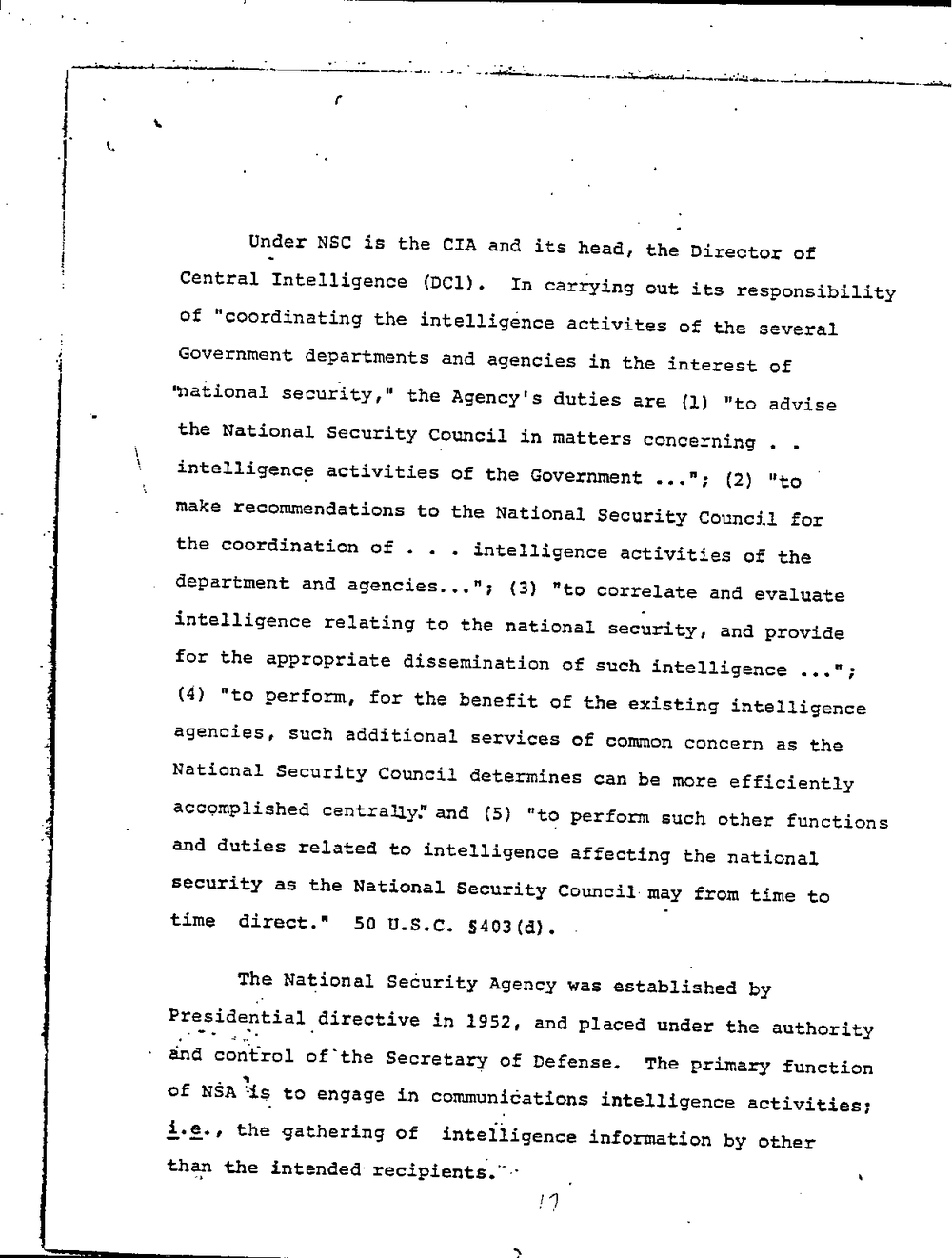
- Jahangir: 4?
4 Linn-.1.
Under NSC is the CIA and its head, the Director of
Central Intelligence In carrying out its responsibility
of "coordinating the intelligence activites of the several
Government departments and agencies in the interest of
'national security," the Agency's duties are "to advise
the National Security Council in matters concerning . .
intelligence activities of the Government (2) "to
make recommendations to the National Security Council for
the coordination of . . . intelligence activities of the
department and (3) ?to correlate and evaluate
intelligence relating to the national security, and provide
for the appropriate dissemination of such intelligence
(4) "to perform, for the benefit of the existing intelligence
agencies, such additional services of common concern as the
National Security Council determines can be more efficiently
accomplished centraIud'and (5) ?to perform such other functions
and duties related to intelligence affecting the national
security as the National Security Council may from time to
time direct.? SO U.S.C. 5403(d).
The National Security Agency was established by
Presidential directive in 1952, and placed under the authority
and control of?the Secretary of Defense. The primary function
- a .
of NSA is to engage in communications intelligence actiVities:
1.3., the gathering of intelligence information by other
than the intended recipientst""
- Jahangir: 4?
4 Linn-.1.
Under NSC is the CIA and its head, the Director of
Central Intelligence In carrying out its responsibility
of "coordinating the intelligence activites of the several
Government departments and agencies in the interest of
'national security," the Agency's duties are "to advise
the National Security Council in matters concerning . .
intelligence activities of the Government (2) "to
make recommendations to the National Security Council for
the coordination of . . . intelligence activities of the
department and (3) ?to correlate and evaluate
intelligence relating to the national security, and provide
for the appropriate dissemination of such intelligence
(4) "to perform, for the benefit of the existing intelligence
agencies, such additional services of common concern as the
National Security Council determines can be more efficiently
accomplished centraIud'and (5) ?to perform such other functions
and duties related to intelligence affecting the national
security as the National Security Council may from time to
time direct.? SO U.S.C. 5403(d).
The National Security Agency was established by
Presidential directive in 1952, and placed under the authority
and control of?the Secretary of Defense. The primary function
- a .
of NSA is to engage in communications intelligence actiVities:
1.3., the gathering of intelligence information by other
than the intended recipientst""
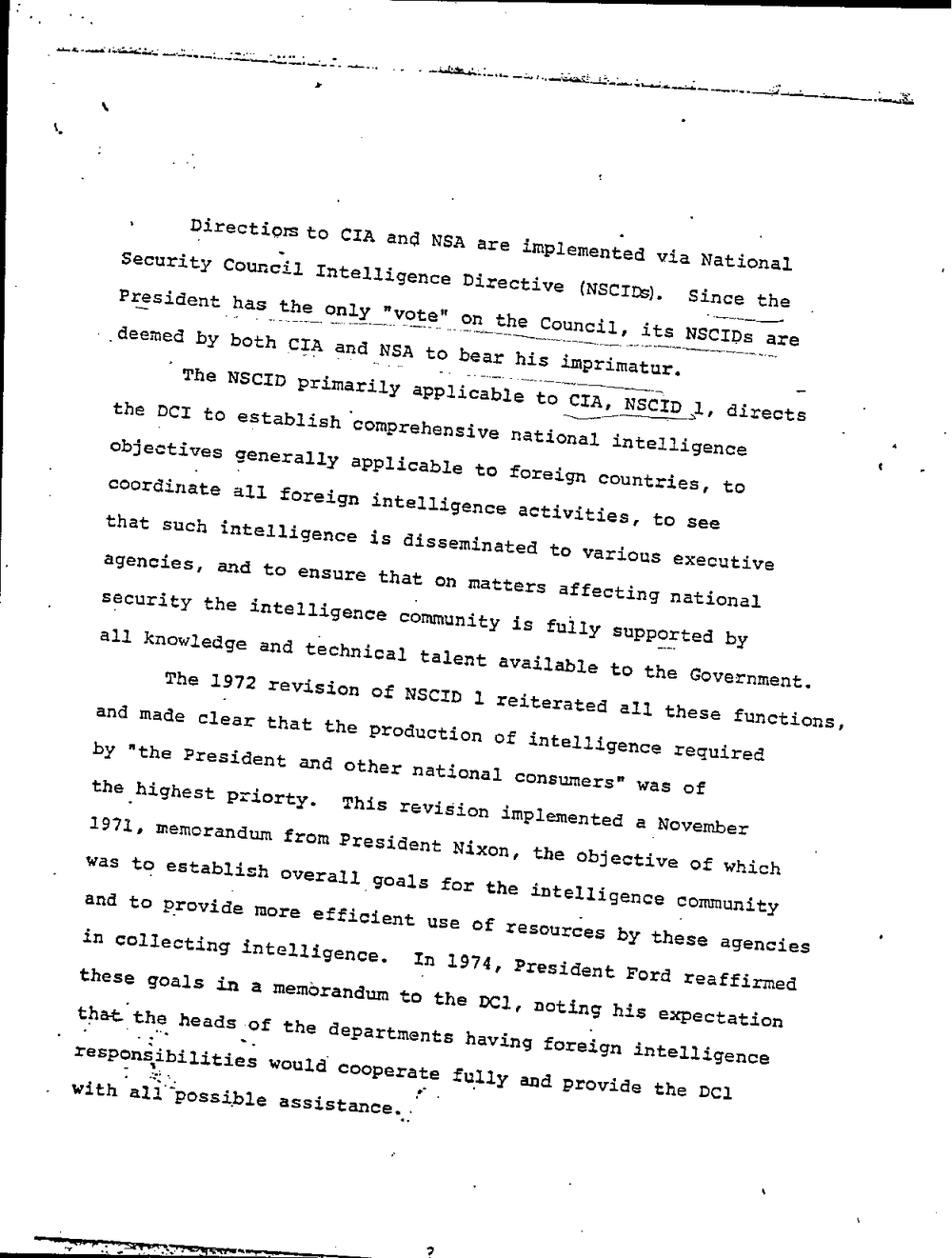
I . . I. .
?ail-nag?; ?our . -
Sec
Pre
aidee
the
obj
COO
1971,
. . .
3'
urity Council Intelligence
sident has the only :ypte
med by both end NSA to
The NSCID primarily applica
DCI to
actives
rdinate
us'
Directive (NSCIDQ. Since the
Council, its NSC
Hmw?mwmw
IDs are
on th
hear his imprimatur.
bl
.
sources by these agencies
In 1974, President Ford reaffirmed
I . . I. .
?ail-nag?; ?our . -
Sec
Pre
aidee
the
obj
COO
1971,
. . .
3'
urity Council Intelligence
sident has the only :ypte
med by both end NSA to
The NSCID primarily applica
DCI to
actives
rdinate
us'
Directive (NSCIDQ. Since the
Council, its NSC
Hmw?mwmw
IDs are
on th
hear his imprimatur.
bl
.
sources by these agencies
In 1974, President Ford reaffirmed
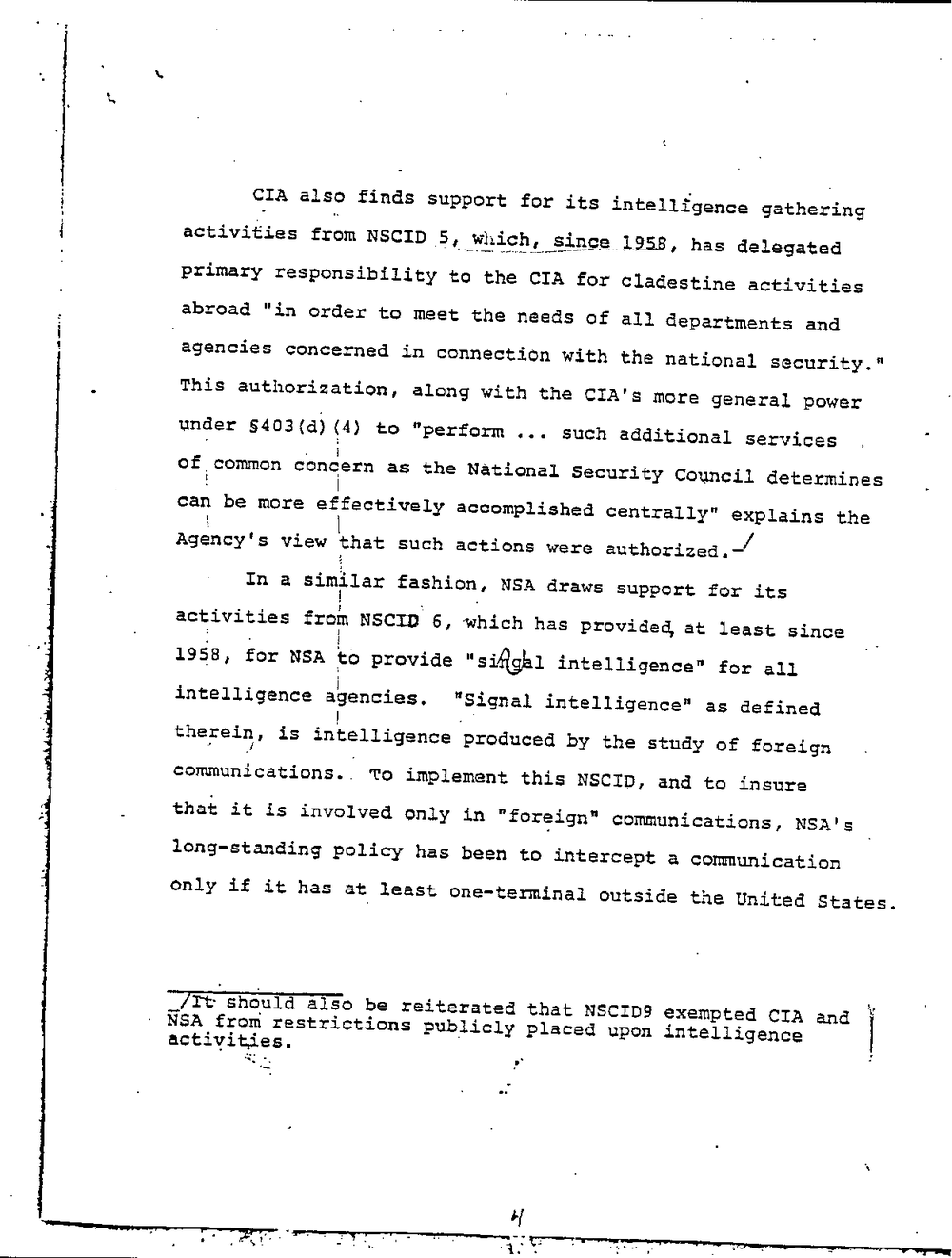
4. a
Aau'
'4
.
I
-
nut-1 Wet
CIA also finds support for its intelligence gathering
activities from NSCID has delegated
primary responsibility to the CIA for cladestine activities
abroad "in order to meet the needs of all departments and
agencies concerned in connectiOn with the national security."
This authorization, along with the more general power
under to "perform such additional services
oficommon condern as the National Security Council determines
. I
can be more effectively accomplished centrally" explains the
Agency's view that such actions were authorized.-/
In a similar fashion, NSA draws support for its
activities from NSCID 6, which has provided at least since
1958, for NSA is provide "si?gbl intelligence" for all
intelligence agencies. "Signal intelligence? as defined
therein, is intelligence produced by the study of foreign
communications. To implement this NSCID, and to insure
that it is involved only in "foreign" communications, NSA's
long-standing policy has been to intercept a communication
only if it has at least one-terminal outside the United States.
_/rt should also be reiterated that NSCID9 exempted CIA and
NSA from restrictions publicly placed upon intelligence
activitiesAll,
a
i.
1
1
4. a
Aau'
'4
.
I
-
nut-1 Wet
CIA also finds support for its intelligence gathering
activities from NSCID has delegated
primary responsibility to the CIA for cladestine activities
abroad "in order to meet the needs of all departments and
agencies concerned in connectiOn with the national security."
This authorization, along with the more general power
under to "perform such additional services
oficommon condern as the National Security Council determines
. I
can be more effectively accomplished centrally" explains the
Agency's view that such actions were authorized.-/
In a similar fashion, NSA draws support for its
activities from NSCID 6, which has provided at least since
1958, for NSA is provide "si?gbl intelligence" for all
intelligence agencies. "Signal intelligence? as defined
therein, is intelligence produced by the study of foreign
communications. To implement this NSCID, and to insure
that it is involved only in "foreign" communications, NSA's
long-standing policy has been to intercept a communication
only if it has at least one-terminal outside the United States.
_/rt should also be reiterated that NSCID9 exempted CIA and
NSA from restrictions publicly placed upon intelligence
activitiesAll,
a
i.
1
1
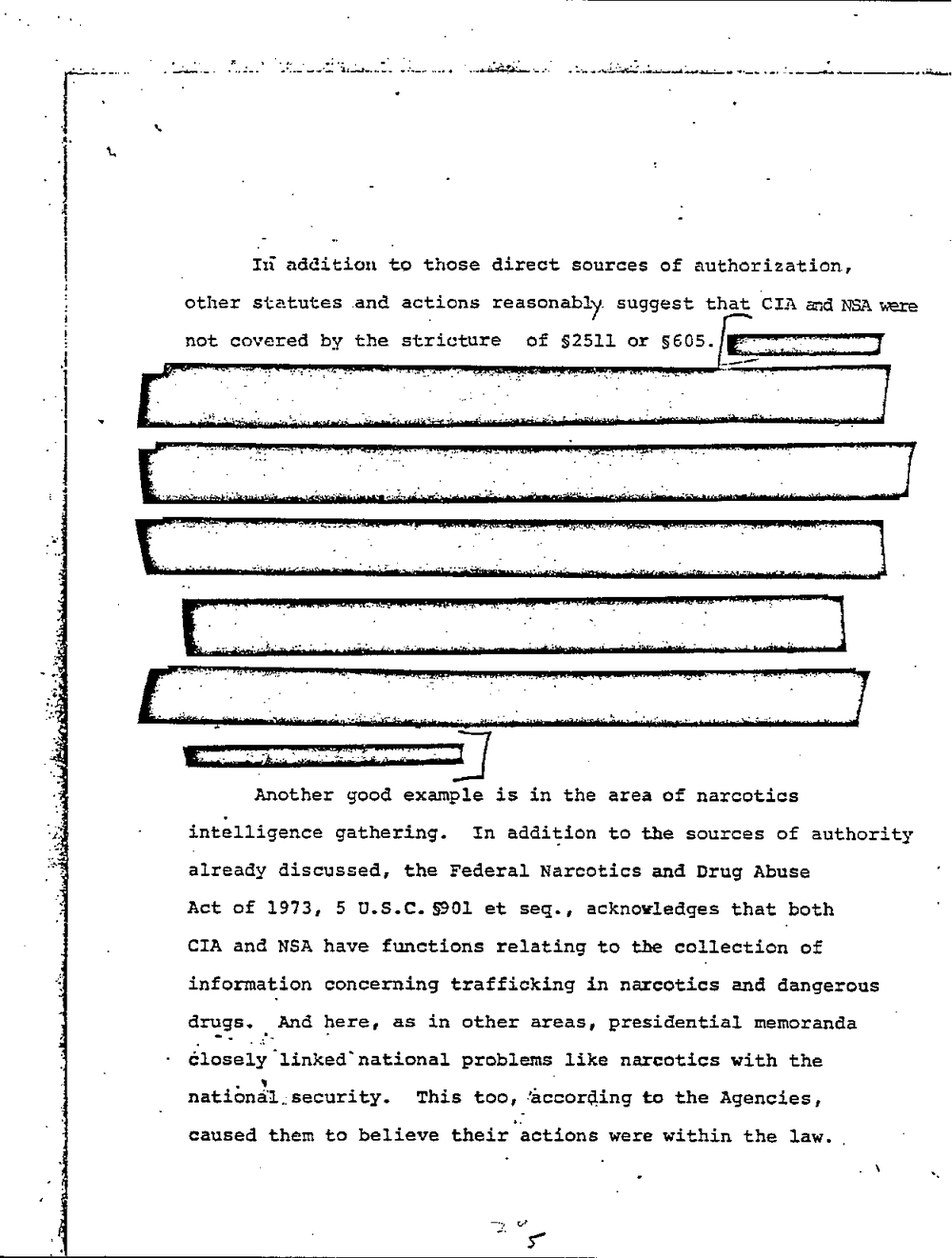
- 3.-. a .. -3. . m. w_
35.;
Id addition to those direct sources of authorization,
other statutes and actions reasonably. suggest that CIA and NSA were
not covered by the stricture of 52511 or 5605.
Another good example is in the area of narcotics
intelligence gathering. In addition to the sources of authority
already discussed, the Federal Narcotics and Drug Abuse
Act of 1973, 5 et seq., acknowledges that both
CIA and NBA have functions relating to the collection of
information concerning trafficking in narcotics and dangerous_
drugs.. And here, as in other areas, presidential memoranda
dlosel?'linked?national problems like narcotics with the
national security. This to the Agencies,
caused them to believe their actions were within the law._
- 3.-. a .. -3. . m. w_
35.;
Id addition to those direct sources of authorization,
other statutes and actions reasonably. suggest that CIA and NSA were
not covered by the stricture of 52511 or 5605.
Another good example is in the area of narcotics
intelligence gathering. In addition to the sources of authority
already discussed, the Federal Narcotics and Drug Abuse
Act of 1973, 5 et seq., acknowledges that both
CIA and NBA have functions relating to the collection of
information concerning trafficking in narcotics and dangerous_
drugs.. And here, as in other areas, presidential memoranda
dlosel?'linked?national problems like narcotics with the
national security. This to the Agencies,
caused them to believe their actions were within the law._
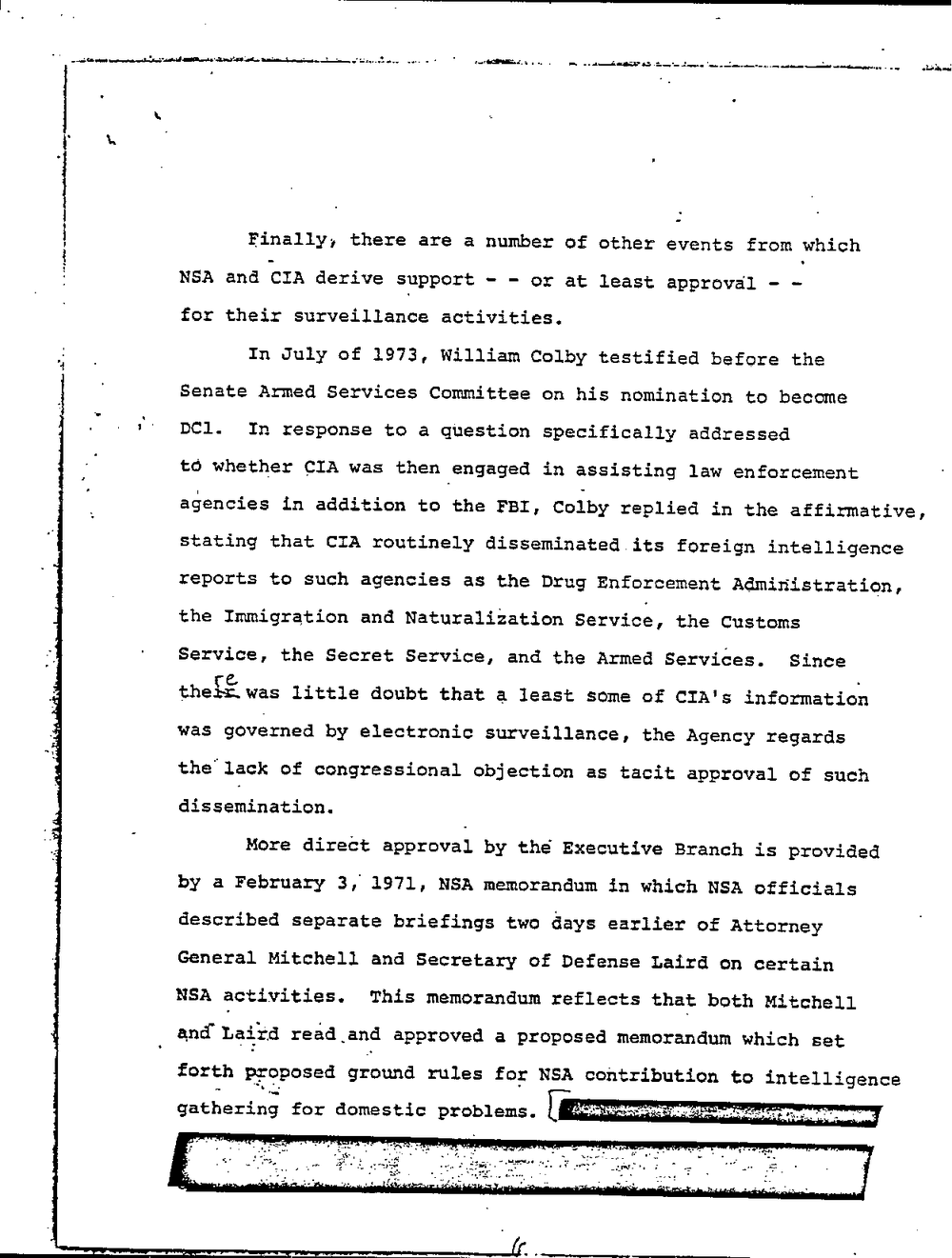
.
.
.
. .
LL: '11 I
9-. I A -.-
Finally, there are a number of other events from which
NSA and CIA derive support - -=or at least approval
for their surveillance activities.
In July of 1973, William Colby testified before the
Senate Armed Services Committee on his nomination to become
In response to a ghestion specifically addressed
to whether CIA was then engaged in assisting law enforcement
agencies in addition to the FBI, Colby replied in the affirmative,
stating that CIA routinely disseminated its foreign intelligence
reports to such agencies as the Drug Enforcement Administration,
the Immigration and Naturalization Service, the Customs
Service, the Secret Service, and the Armed Services. Since
thegglwas little doubt that a least some of CIA's information
was governed by electronic surveillance, the Agency regards
the lack of congressional objection as tacit approval of such
dissemination.
More direct approval by the Executive Branch is provided
by a February 3, 1971, NSA memorandum in which NSA officials
described separate briefings two days earlier of Attorney
General Mitchell and Secretary of Defense Laird on certain
NSA activities. This memorandum reflects that both Mitchell
and'Laird read,and approved a proposed memorandum which set
forth proposed ground rules for NSA contribution to intelligence
gathering for domestic problems.
.
.
.
. .
LL: '11 I
9-. I A -.-
Finally, there are a number of other events from which
NSA and CIA derive support - -=or at least approval
for their surveillance activities.
In July of 1973, William Colby testified before the
Senate Armed Services Committee on his nomination to become
In response to a ghestion specifically addressed
to whether CIA was then engaged in assisting law enforcement
agencies in addition to the FBI, Colby replied in the affirmative,
stating that CIA routinely disseminated its foreign intelligence
reports to such agencies as the Drug Enforcement Administration,
the Immigration and Naturalization Service, the Customs
Service, the Secret Service, and the Armed Services. Since
thegglwas little doubt that a least some of CIA's information
was governed by electronic surveillance, the Agency regards
the lack of congressional objection as tacit approval of such
dissemination.
More direct approval by the Executive Branch is provided
by a February 3, 1971, NSA memorandum in which NSA officials
described separate briefings two days earlier of Attorney
General Mitchell and Secretary of Defense Laird on certain
NSA activities. This memorandum reflects that both Mitchell
and'Laird read,and approved a proposed memorandum which set
forth proposed ground rules for NSA contribution to intelligence
gathering for domestic problems.
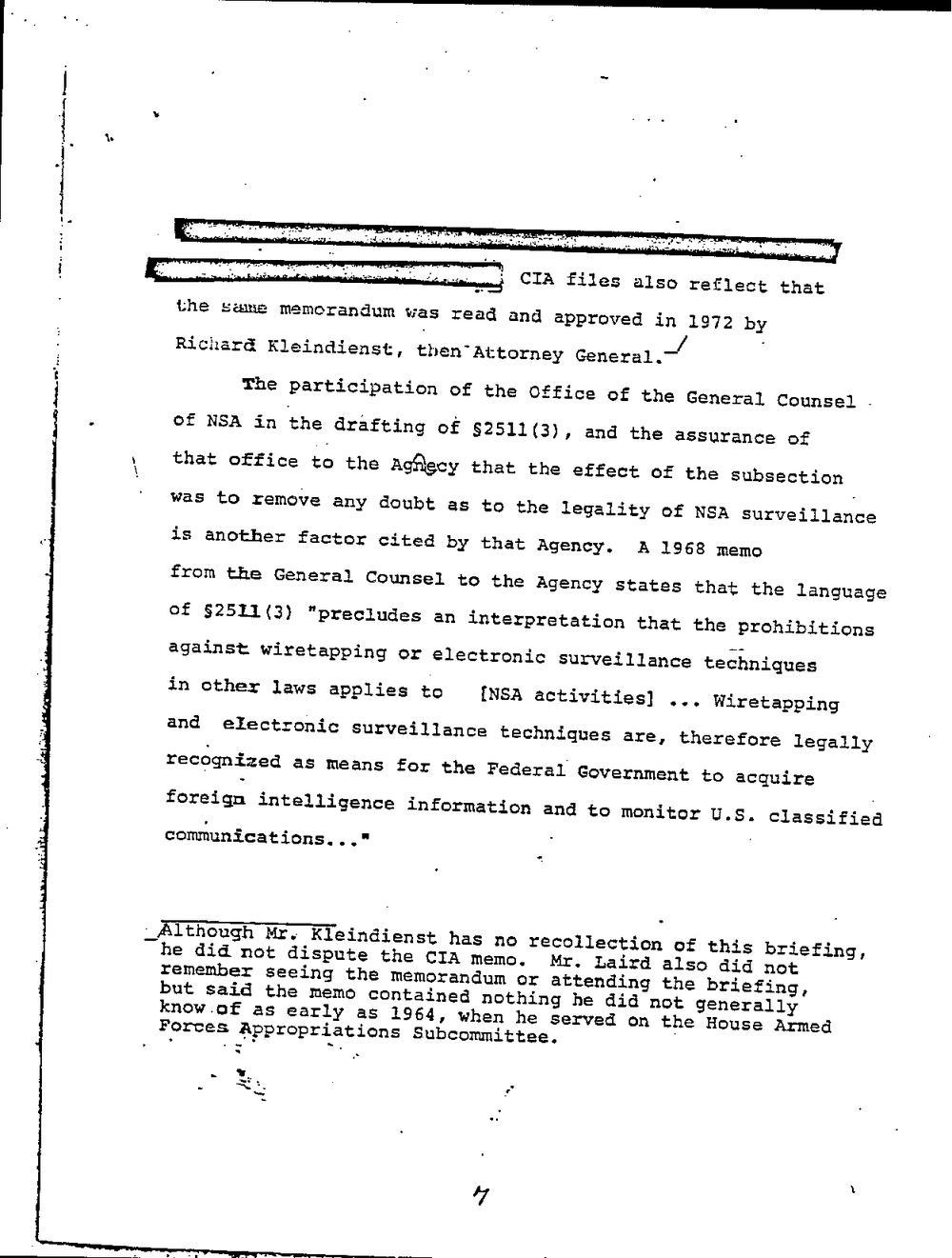
LL.-
CIA files also reflect that
the same memorandum was read and approved in 1972 by
Richard Kleindienst, then'Attorney General.'/ -
The participation of the Office of the General Counsel -
of NBA in the drafting of 525119), and the assurance of
that office_to the AQ?gcy that the effect of the subsection
was to remove any doubt as to the legality of NSA surveillance
is another factor cited by that Agency. A 1968 memo
from the General Counsel to the Agency states that the language
of 52511(3) "precludes an interpretation that the prohibitions
against wiretapping or electronic surveillance techniques
in other laws applies to activities] Wiretapping
and electronic surveillance techniques are, therefore legally
recognized as means for the Federal Government to acquire
foreign intelligence information and to monitor U.S. classified
_JA1though Mr; Kleindienst has no recollection of this briefing,
he did.not dispute the CIA memo. Mr. Laird also did not
remember seeing the memorandum or attending the briefing,
know.of as early as 1964, when he served on the House Armed
Forces appropriations Subcommittee.
LL.-
CIA files also reflect that
the same memorandum was read and approved in 1972 by
Richard Kleindienst, then'Attorney General.'/ -
The participation of the Office of the General Counsel -
of NBA in the drafting of 525119), and the assurance of
that office_to the AQ?gcy that the effect of the subsection
was to remove any doubt as to the legality of NSA surveillance
is another factor cited by that Agency. A 1968 memo
from the General Counsel to the Agency states that the language
of 52511(3) "precludes an interpretation that the prohibitions
against wiretapping or electronic surveillance techniques
in other laws applies to activities] Wiretapping
and electronic surveillance techniques are, therefore legally
recognized as means for the Federal Government to acquire
foreign intelligence information and to monitor U.S. classified
_JA1though Mr; Kleindienst has no recollection of this briefing,
he did.not dispute the CIA memo. Mr. Laird also did not
remember seeing the memorandum or attending the briefing,
know.of as early as 1964, when he served on the House Armed
Forces appropriations Subcommittee.
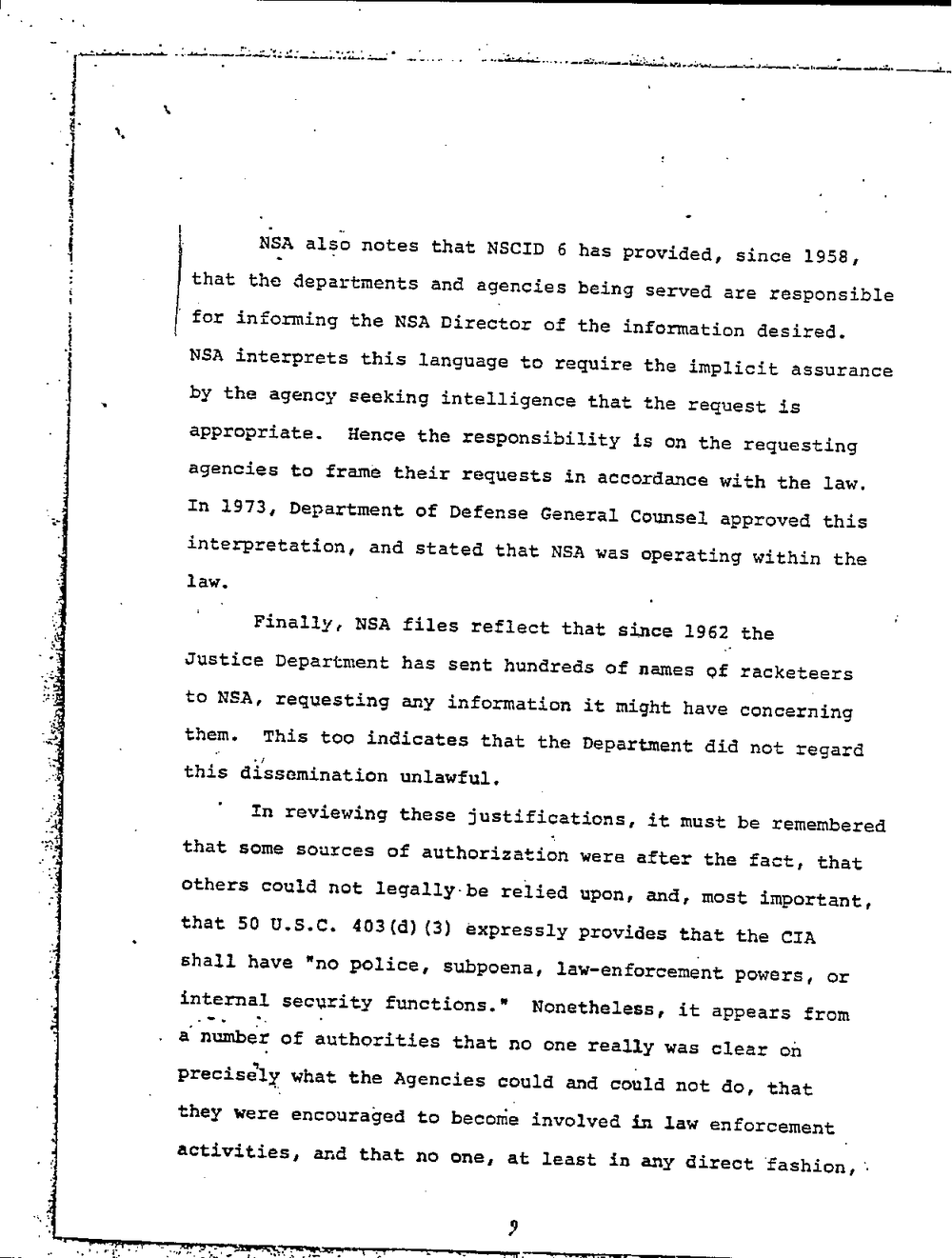
nt?tcu
. ..
. . -.-- 1.0-. . -
- ?mld?
a
.-
L5
RDA also notes that NSCID 6 has provided, since 1958,
that the departments and agencies being served are responsible
?for informing the NSA Director of the information desired.
NSA interprets this language to require the implicit assurance
by the agency seeking intelligence that the request is
appropriate. Hence the responsibility is on the requesting
agencies to frame their requests in accordance with the law.
In 1973, Department of Defense General Counsel approved this
interpretation, and stated that NSA was operating within the
law.
Finally, NSA files reflect that since 1962 the
Justice Department has sent hundreds of names of racketeers
to NSA, requesting any information it might have concerning
them. This too indicates that the Department did not regard
this dissemination unlawful.
In reviewing these justifications, it must be remembered
that some sources of authorization were after the fact, that
others could not legally-be relied upon, and, most important,
that 50 U.S.C. 403(d)(3) expressly provides that the CIA
shall have "no police, subpoena, law-enforcement powers, or
internal security functions.? Nonetheless, it appears from
a number of authorities that no one really was clear on
precis?ly what the Agencies could and could not do, that
they were encouraged to become involved in law enforcement
activities, and that no one, at least in any direct fashion,1
on"? - mm, . .- xr?
nt?tcu
. ..
. . -.-- 1.0-. . -
- ?mld?
a
.-
L5
RDA also notes that NSCID 6 has provided, since 1958,
that the departments and agencies being served are responsible
?for informing the NSA Director of the information desired.
NSA interprets this language to require the implicit assurance
by the agency seeking intelligence that the request is
appropriate. Hence the responsibility is on the requesting
agencies to frame their requests in accordance with the law.
In 1973, Department of Defense General Counsel approved this
interpretation, and stated that NSA was operating within the
law.
Finally, NSA files reflect that since 1962 the
Justice Department has sent hundreds of names of racketeers
to NSA, requesting any information it might have concerning
them. This too indicates that the Department did not regard
this dissemination unlawful.
In reviewing these justifications, it must be remembered
that some sources of authorization were after the fact, that
others could not legally-be relied upon, and, most important,
that 50 U.S.C. 403(d)(3) expressly provides that the CIA
shall have "no police, subpoena, law-enforcement powers, or
internal security functions.? Nonetheless, it appears from
a number of authorities that no one really was clear on
precis?ly what the Agencies could and could not do, that
they were encouraged to become involved in law enforcement
activities, and that no one, at least in any direct fashion,1
on"? - mm, . .- xr?
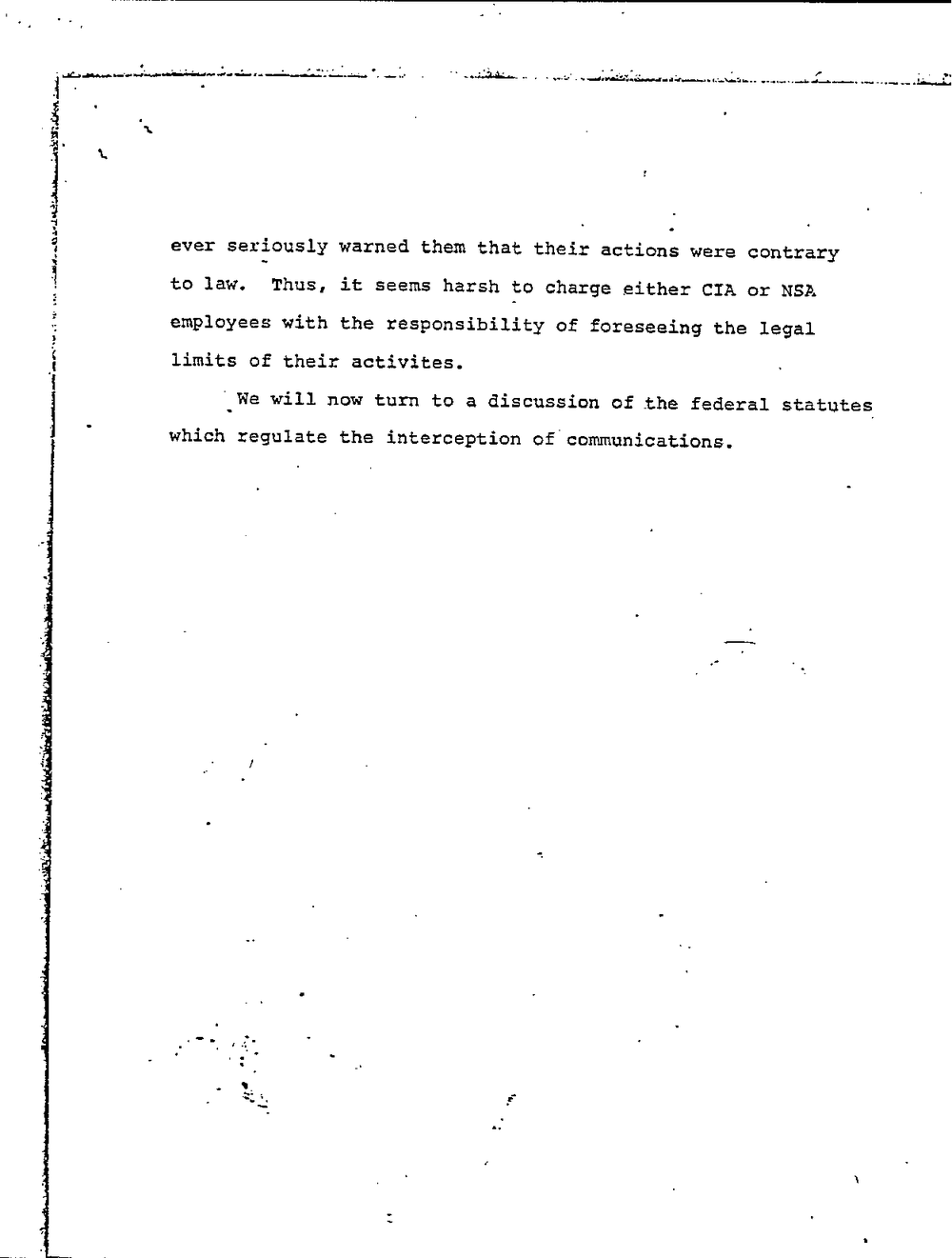
. . . I . .
- .
I":l .
I.
ever seriously warned them that their actions were contrary
. . M4- -uL-abs?m-?t??
to law. Thus, it seems harsh to charge either CIA or NSA
employees with the responsibility of foreseeing the legal
limits of their activites.
.
all. unh'
We will now turn to a discussion of the federal statutes
which regulate the interception of communications.
. . . I . .
- .
I":l .
I.
ever seriously warned them that their actions were contrary
. . M4- -uL-abs?m-?t??
to law. Thus, it seems harsh to charge either CIA or NSA
employees with the responsibility of foreseeing the legal
limits of their activites.
.
all. unh'
We will now turn to a discussion of the federal statutes
which regulate the interception of communications.
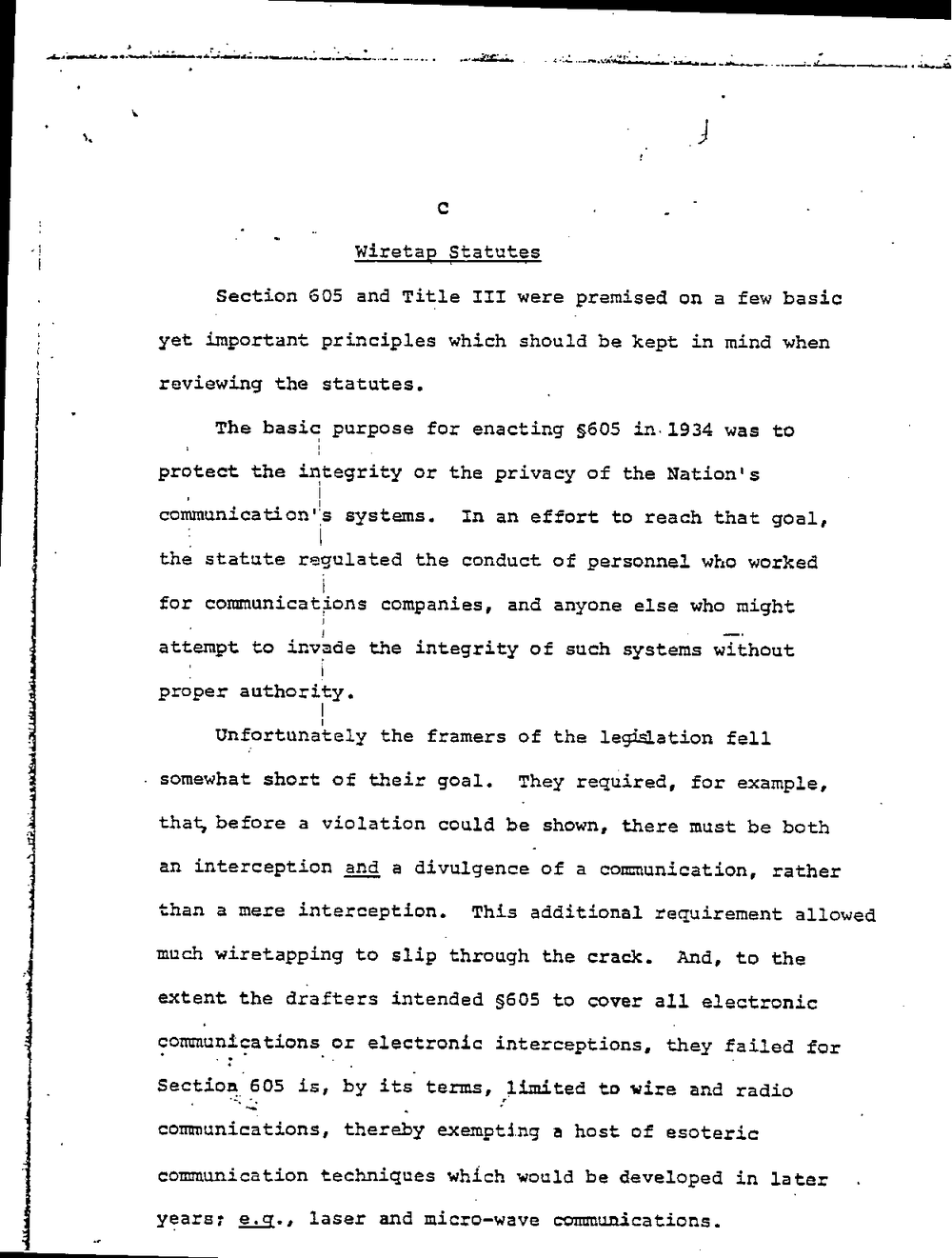
.51? .- .. . ?Hume\i?p sham?L? mm; ?lm-tkh?un -
k'I-l 22.4.
-4
Jll?4._
.
Wiretap statutes
Section 605 and Title were premised on a few basic
yet important principles which should be kept in mind when
reviewing the statutes.
The basic purpose for enacting ?605 in 1934 was to
protect the integrity or the privacy of the Nation's
i
communication'% systems. In an effort to reach that goal,
the statute regulated the conduct of personnel who worked
for communicatgons companies, and anyone else who might
attempt to invade the integrity of such systems without
proper authori%y.
Unfortunately the framers of the legk?ation fell
. somewhat short of their goal. They required, for example,
that?before a violation could be shown, there must be both
an interception and a divulgence of a communication, rather
than a mere interception. This additional requirement allowed
much wiretapping to slipthrough the crack. And, to the
extent the drafters intended ?605 to cover all electronic
communications or electronic interceptions, they tailed for
Section 505 is, hy its terms, limited to wire and radio
communications, therehy exempting a host of esoteric
communication techniques which would be develOped in later
years: laser and micro-wave communications.
.51? .- .. . ?Hume\i?p sham?L? mm; ?lm-tkh?un -
k'I-l 22.4.
-4
Jll?4._
.
Wiretap statutes
Section 605 and Title were premised on a few basic
yet important principles which should be kept in mind when
reviewing the statutes.
The basic purpose for enacting ?605 in 1934 was to
protect the integrity or the privacy of the Nation's
i
communication'% systems. In an effort to reach that goal,
the statute regulated the conduct of personnel who worked
for communicatgons companies, and anyone else who might
attempt to invade the integrity of such systems without
proper authori%y.
Unfortunately the framers of the legk?ation fell
. somewhat short of their goal. They required, for example,
that?before a violation could be shown, there must be both
an interception and a divulgence of a communication, rather
than a mere interception. This additional requirement allowed
much wiretapping to slipthrough the crack. And, to the
extent the drafters intended ?605 to cover all electronic
communications or electronic interceptions, they tailed for
Section 505 is, hy its terms, limited to wire and radio
communications, therehy exempting a host of esoteric
communication techniques which would be develOped in later
years: laser and micro-wave communications.
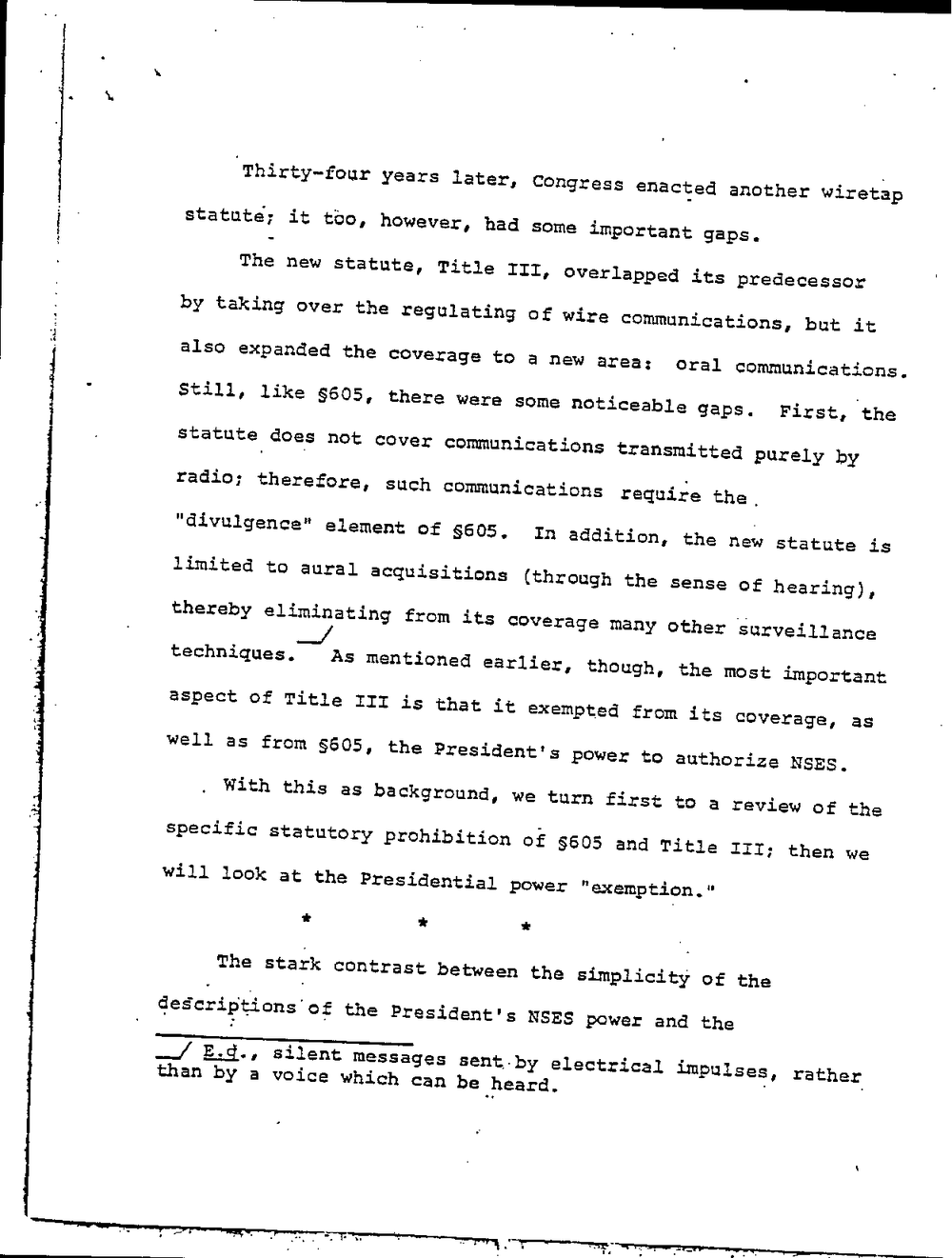
[Thirty-four years later, Congress enacted another wiretap
i a statute; it too, however, had some important gaps.
The new statute, Title overlapped its predecessor
by taking over the regulating of wire communications, but it
.
- .
also expanded the coverage to a new area: oral communications.
Still, like ?605, there were some noticeable gaps. First, the
statute does not cover communications transmitted purely by
a radio; therefore, such communications require the.
"divulgence" element of 5605. In addition, the new statute is
limited to aural acquisitions (through the sense of hearing),
I I
thereby eliminating from its coverage many other surveillance
techniques. As mentioned earlier, though, the most important
aspect of Title is that it exempted from its coverage, as
well as from ?605, the President's power to authorize NSES.
1.1.1. in:
With this as background, we turn first to a review of the
-1 L314
specific statutory prohibition of $605 and Title then we
3 will look at the Presidential power "exemption."
1' i
The stark contrast between the simplicity of the
descriptions'of the President's NSES power and the
h?V silent messages sent by electrical impulses, rather
than by a voice which can be heard.
[Thirty-four years later, Congress enacted another wiretap
i a statute; it too, however, had some important gaps.
The new statute, Title overlapped its predecessor
by taking over the regulating of wire communications, but it
.
- .
also expanded the coverage to a new area: oral communications.
Still, like ?605, there were some noticeable gaps. First, the
statute does not cover communications transmitted purely by
a radio; therefore, such communications require the.
"divulgence" element of 5605. In addition, the new statute is
limited to aural acquisitions (through the sense of hearing),
I I
thereby eliminating from its coverage many other surveillance
techniques. As mentioned earlier, though, the most important
aspect of Title is that it exempted from its coverage, as
well as from ?605, the President's power to authorize NSES.
1.1.1. in:
With this as background, we turn first to a review of the
-1 L314
specific statutory prohibition of $605 and Title then we
3 will look at the Presidential power "exemption."
1' i
The stark contrast between the simplicity of the
descriptions'of the President's NSES power and the
h?V silent messages sent by electrical impulses, rather
than by a voice which can be heard.
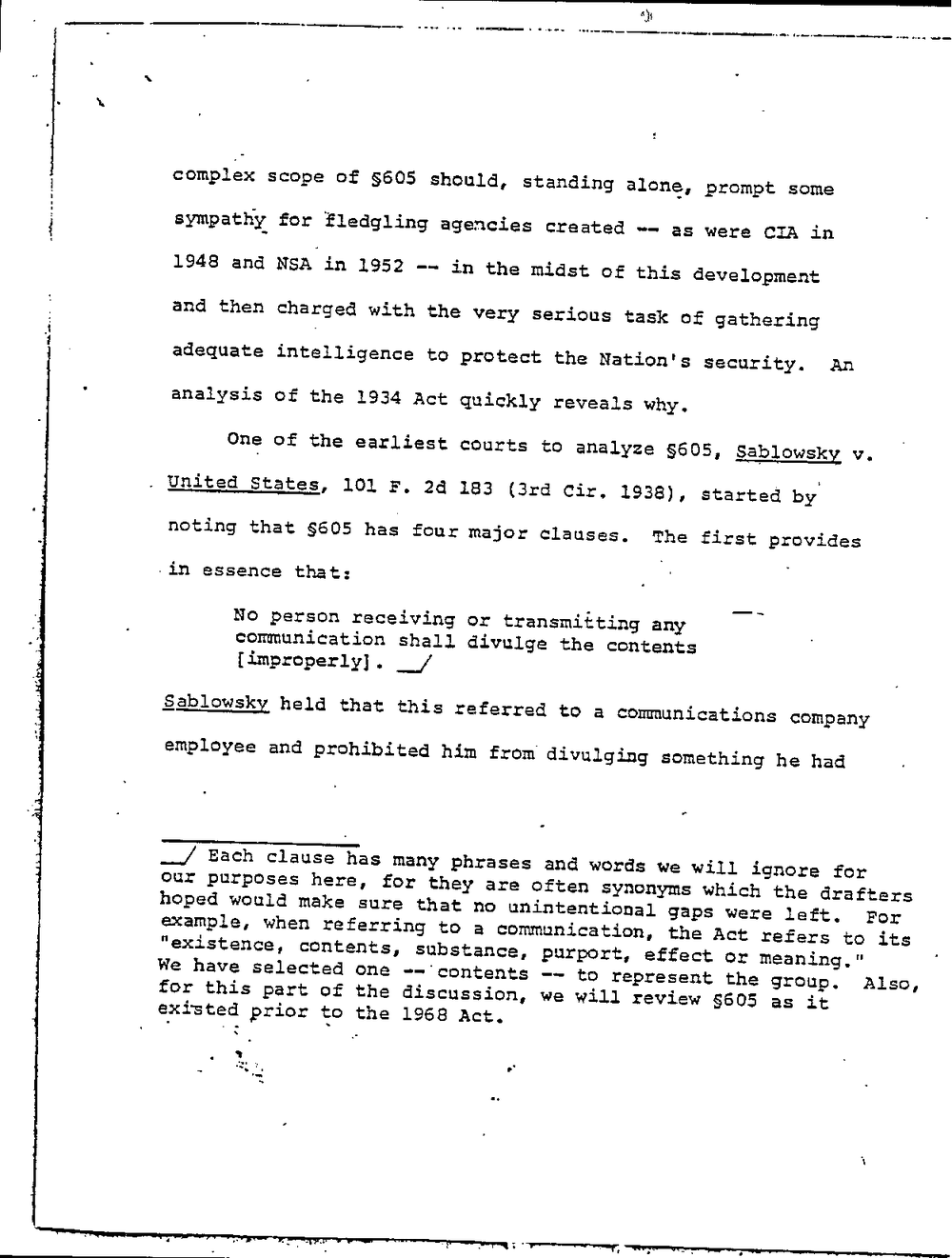
.ma. nun?h-
.-
I
l' 1M4. .
.m?u'a .4
??U-th ?r
complex sc0pe of 5605 should, standing alone, prompt some
sympathy for fledgling agencies created -- as were CIA in
1948 and 1952 -- in the midst of this development
and then charged with the very serious task of gathering
adequate intelligence to protect the Nation's security. An
analysis of the 1934 Act quickly reveals why.
One of the earliest courts to analyze ?605, Sahlowsky v.
. United States, 101 F. 2d 183 (3rd Cir. 1938), started by.
noting that ?605 has four major clauses. The first provides
.in essence that:
No person receiving or transmitting any
communication shall divulge the contents
[imprOperly].
?ablowsky held that this referred to a communications company
employee and prohibited him from divulging something he had
a
Each clause has many phrases and words we will ignore for
our purposes here, for they are often synonyms which the drafters
hOped would make sure that no unintentional gaps were left. For
example, when referring to a communication, the Act refers to its
"existence, contents, substance, purport, effect or meaning."
We have selected one -- contents -- to represent the group. Also,
for this part of the discussion, we will review 5605 as it
existed prior to the 1968 Act.
.
.
-.
t? warvrw?w r?w
.
.ma. nun?h-
.-
I
l' 1M4. .
.m?u'a .4
??U-th ?r
complex sc0pe of 5605 should, standing alone, prompt some
sympathy for fledgling agencies created -- as were CIA in
1948 and 1952 -- in the midst of this development
and then charged with the very serious task of gathering
adequate intelligence to protect the Nation's security. An
analysis of the 1934 Act quickly reveals why.
One of the earliest courts to analyze ?605, Sahlowsky v.
. United States, 101 F. 2d 183 (3rd Cir. 1938), started by.
noting that ?605 has four major clauses. The first provides
.in essence that:
No person receiving or transmitting any
communication shall divulge the contents
[imprOperly].
?ablowsky held that this referred to a communications company
employee and prohibited him from divulging something he had
a
Each clause has many phrases and words we will ignore for
our purposes here, for they are often synonyms which the drafters
hOped would make sure that no unintentional gaps were left. For
example, when referring to a communication, the Act refers to its
"existence, contents, substance, purport, effect or meaning."
We have selected one -- contents -- to represent the group. Also,
for this part of the discussion, we will review 5605 as it
existed prior to the 1968 Act.
.
.
-.
t? warvrw?w r?w
.
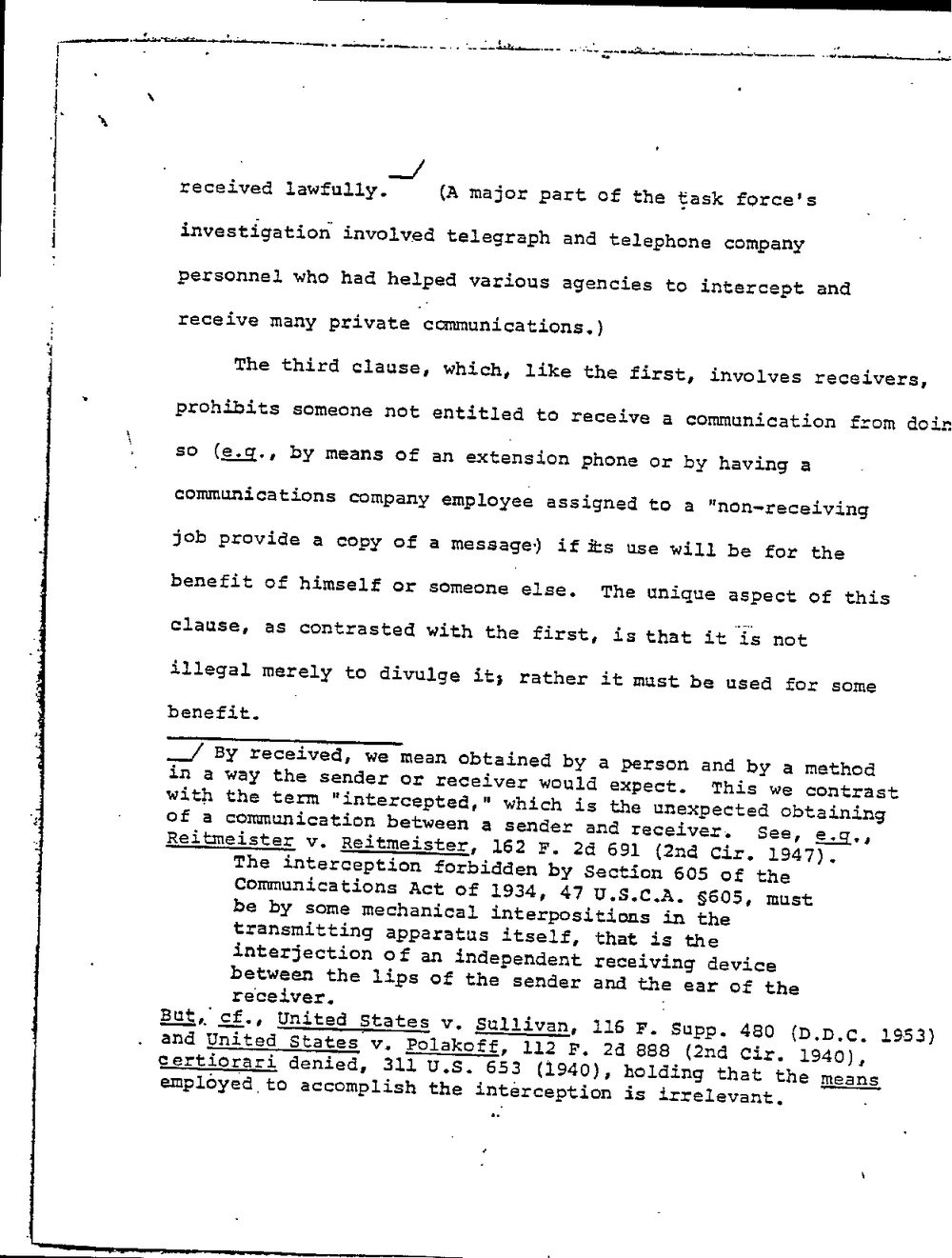
?4 ?m
.
til; ??Li .
on?received lawfully. (A major part of the task force's
investigation involved telegraph and telephone company
personnel who had helped various agencies to intercept and
receive many private communications.)
The third clause, which, like the first, involves receivers,
prohibits someone not entitled to receive a communication from doin
so (egg,, by means of an extension phone or by having a
communications company employee assigned to a "non-receiving
job provide a copy of a messageo if:ts use will be for the
benefit of himself or someone else. The unique aspect of this
clause, as contrasted with the first, is that it is not
illegal merely to divulge it; rather it must be used for some
benefit.
By received, we mean obtained by a person and by a method
in a way the sender or receiver would expect. This we contrast
with the term "intercepted," which is the unexpected obtaining
of a communication between a sender and receiver. See, e.
Reitmeister v. Reitmeister, 162 F. 2d 691 (2nd Cir. 1947).
The interception forbidden by Section 605 of the
Communications Act of 1934, 47 U.S.C.A. ?605, must
be by some mechanical interpositions in the
transmitting apparatus itself, that is the
interjection of an independent receiving device
betWeen the lips of the sender and the ear of the
receiver. 3
United States v. Sullivan, 116 F. Supp. 480 (D.D.C. 1953)
and United States v. Polakoff, 112 F. 2d 888 (2nd Cir. 1940),
certiorari denied, 311 v.5. 653 (1940), holding that the means
employed to accomplish the interception is irrelevant.
?4 ?m
.
til; ??Li .
on?received lawfully. (A major part of the task force's
investigation involved telegraph and telephone company
personnel who had helped various agencies to intercept and
receive many private communications.)
The third clause, which, like the first, involves receivers,
prohibits someone not entitled to receive a communication from doin
so (egg,, by means of an extension phone or by having a
communications company employee assigned to a "non-receiving
job provide a copy of a messageo if:ts use will be for the
benefit of himself or someone else. The unique aspect of this
clause, as contrasted with the first, is that it is not
illegal merely to divulge it; rather it must be used for some
benefit.
By received, we mean obtained by a person and by a method
in a way the sender or receiver would expect. This we contrast
with the term "intercepted," which is the unexpected obtaining
of a communication between a sender and receiver. See, e.
Reitmeister v. Reitmeister, 162 F. 2d 691 (2nd Cir. 1947).
The interception forbidden by Section 605 of the
Communications Act of 1934, 47 U.S.C.A. ?605, must
be by some mechanical interpositions in the
transmitting apparatus itself, that is the
interjection of an independent receiving device
betWeen the lips of the sender and the ear of the
receiver. 3
United States v. Sullivan, 116 F. Supp. 480 (D.D.C. 1953)
and United States v. Polakoff, 112 F. 2d 888 (2nd Cir. 1940),
certiorari denied, 311 v.5. 653 (1940), holding that the means
employed to accomplish the interception is irrelevant.
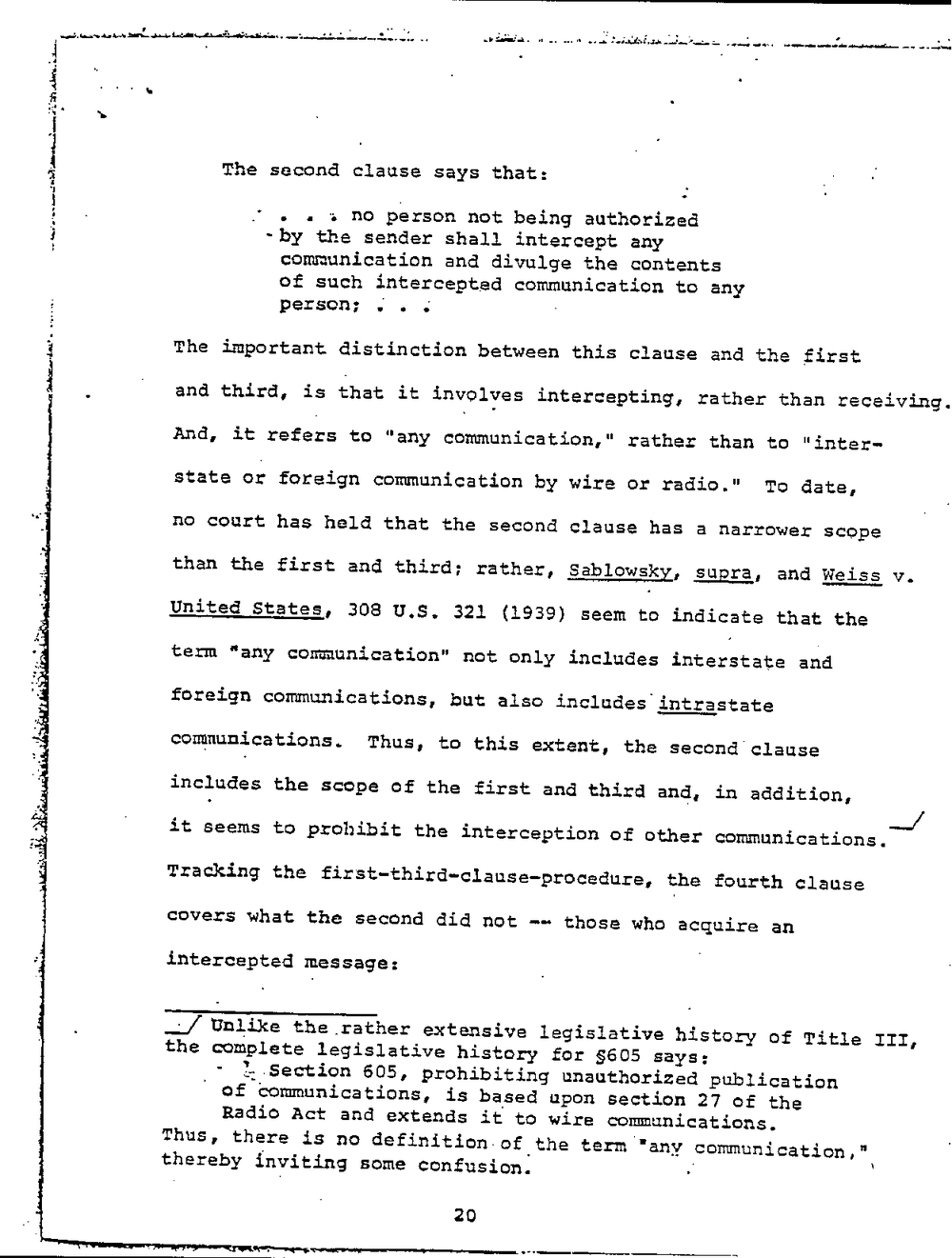
Mid-M's I-u- n.
[nh?g-bh-The second clause says that:
. . . 3 no person not being authorized
-by the sender shall intercept any
communication and divulge the contents
of such intercepted communication to any
person: .
The important distinction between this clause and the first
and third, is that it involyes intercepting, rather than receiving.
And, it refers to ?any communication," rather than to "inter-
state or foreign communication by wire or radio." To date,
no court has held that the second clause has a narrower scope
than the first and third; rather, Sablowsky, supra, and Egigg v.
United States, 308 U.S. 321 (1939) seem to indicate that the
term "any communication" not only includes interstate and
foreign communications, but also includes intrastate
communications. Thus, to this extent, the second clause
includes the scope of the first and third and, in addition,
it seems to prohibit the interception of other communications.??/
Tracking the first-third?clause-procedure, the fourth clause
covers what the second did not -- those who acquire an
intercepted message:
the rather extensive legislative history of Title
the complete legislative histOry for 5605 says:
- ?.Section 605, prohibiting unauthorized publication
of communications, is based upon section 27 of the
Radio Act and extends it to wire communications.
Thus, there is no definition of the term 'any communication,"
thereby inviting some confusion.
20
'rr 7
Mid-M's I-u- n.
[nh?g-bh-The second clause says that:
. . . 3 no person not being authorized
-by the sender shall intercept any
communication and divulge the contents
of such intercepted communication to any
person: .
The important distinction between this clause and the first
and third, is that it involyes intercepting, rather than receiving.
And, it refers to ?any communication," rather than to "inter-
state or foreign communication by wire or radio." To date,
no court has held that the second clause has a narrower scope
than the first and third; rather, Sablowsky, supra, and Egigg v.
United States, 308 U.S. 321 (1939) seem to indicate that the
term "any communication" not only includes interstate and
foreign communications, but also includes intrastate
communications. Thus, to this extent, the second clause
includes the scope of the first and third and, in addition,
it seems to prohibit the interception of other communications.??/
Tracking the first-third?clause-procedure, the fourth clause
covers what the second did not -- those who acquire an
intercepted message:
the rather extensive legislative history of Title
the complete legislative histOry for 5605 says:
- ?.Section 605, prohibiting unauthorized publication
of communications, is based upon section 27 of the
Radio Act and extends it to wire communications.
Thus, there is no definition of the term 'any communication,"
thereby inviting some confusion.
20
'rr 7
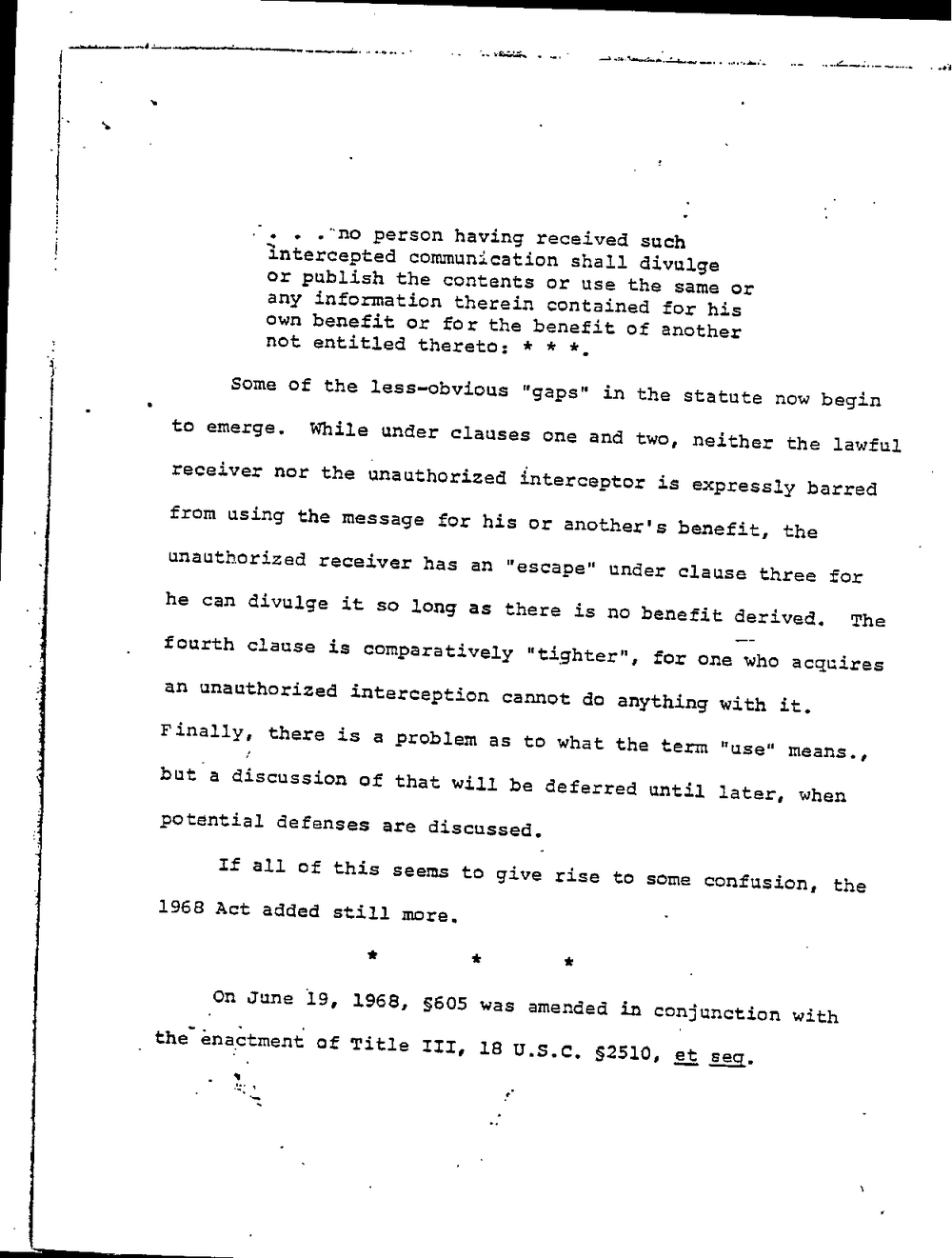
A ullLL-u
A?vii-3LT}. . . .rl
. ."no person having received such
intercepted communication shall divulge
or publish the contents or use the same or
any information therein contained for his
own benefit or for the benefit of another
not entitled thereto:
Some of the less?obvious "gaps" in the statute now begin
to emerge. While under clauses one and two, neither the lawful
receiver nor the unauthorized interceptor is expressly barred
from using the message for his or another's benefit, the
unauthorized receiver has an "escape" under clause three for
he can divulge it so long as there is no benefit derived. The
fourth clause is comparatively "tighter", for one who acquires
an unauthorized interception cannot do anything with it.
Finally, there is a problem as to what the term "use" means.,
but a discussion of that will be deferred until later, when
potential defenses are discussed.
If all of this seems to give rise to some confusion, the
1968 Act added still more.
i 1'
On June 19, 1968, $605 was amended in conjunction with
the- enactment of Title 18 v.3.c. 52510, seg.
I
?r
-
A ullLL-u
A?vii-3LT}. . . .rl
. ."no person having received such
intercepted communication shall divulge
or publish the contents or use the same or
any information therein contained for his
own benefit or for the benefit of another
not entitled thereto:
Some of the less?obvious "gaps" in the statute now begin
to emerge. While under clauses one and two, neither the lawful
receiver nor the unauthorized interceptor is expressly barred
from using the message for his or another's benefit, the
unauthorized receiver has an "escape" under clause three for
he can divulge it so long as there is no benefit derived. The
fourth clause is comparatively "tighter", for one who acquires
an unauthorized interception cannot do anything with it.
Finally, there is a problem as to what the term "use" means.,
but a discussion of that will be deferred until later, when
potential defenses are discussed.
If all of this seems to give rise to some confusion, the
1968 Act added still more.
i 1'
On June 19, 1968, $605 was amended in conjunction with
the- enactment of Title 18 v.3.c. 52510, seg.
I
?r
-
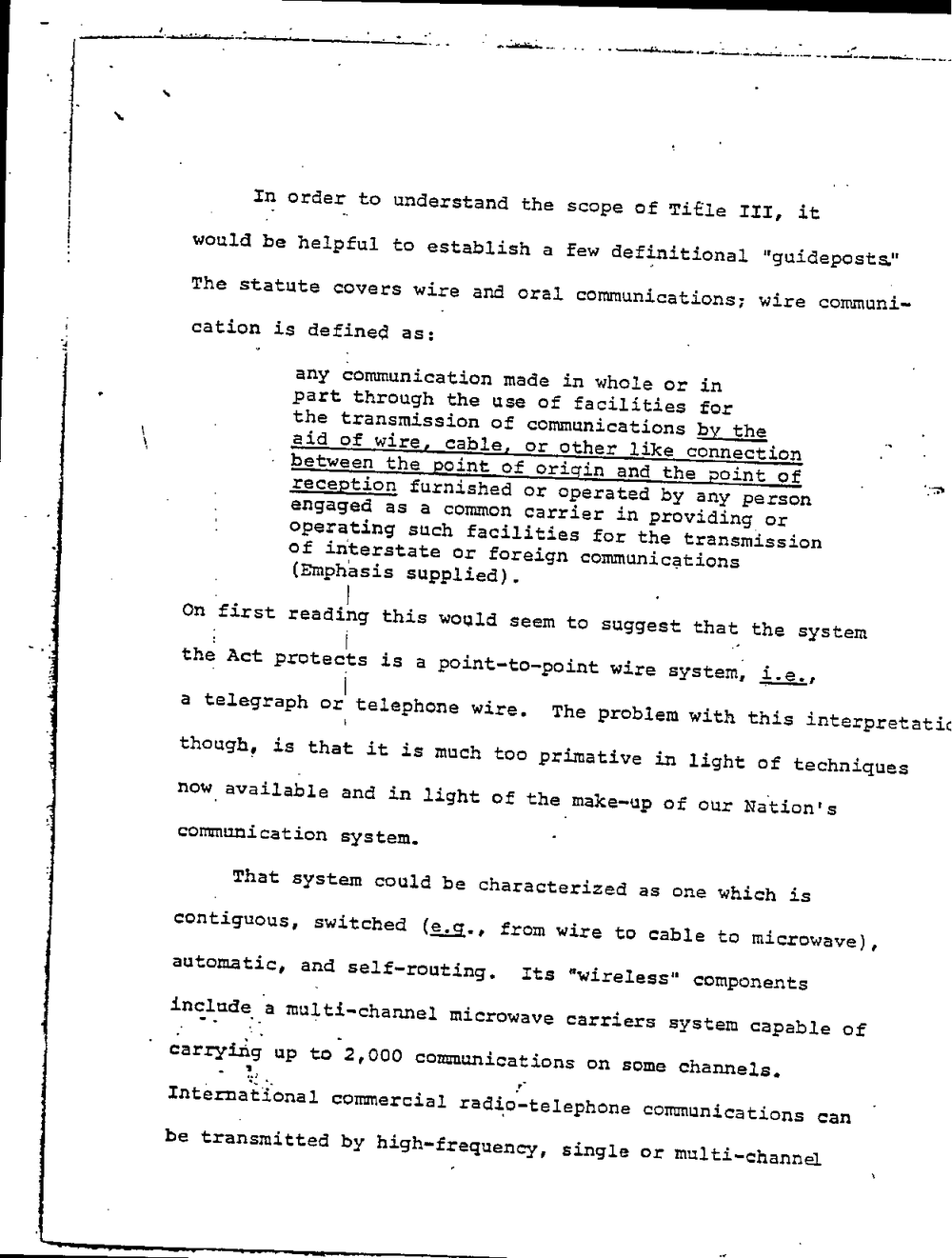
?(in Wl?order to understand the scope of Title it
would be helpful to establish a few definitional "guideposta"
The statute covers wire and oral communications; wire communi-
cation is defined as:.
any communication made in whole or in
part through the use of facilities for
the transmission of communications by the
aid of wire, cable, or other like connection
between the point of origin and the point of
reception furnished or Operated by any person
engaged as a common carrier in providing or
operating such facilities for the transmission
of interstate or foreign communications
(Emphasis supplied).
On first reading this would seem to suggest that the system
the Act protects is a point?to-point wire system;
a telegraph or telephone wire. The problem with this interpretatic
though, is that it is much too primative in light of techniques
communication system.
That system could be characterized as one which is
contiguous, switched (egg., from wire to cable to microwave),
automatic, and self-routing. Its "wireless" components
include a multi-channel microwave carriers system capable of
carryin up to 2,000 communications on some channels.
a
International commercial radio?telephone communications can
be transmitted by high-frequency, single or multi-channel
?(in Wl?order to understand the scope of Title it
would be helpful to establish a few definitional "guideposta"
The statute covers wire and oral communications; wire communi-
cation is defined as:.
any communication made in whole or in
part through the use of facilities for
the transmission of communications by the
aid of wire, cable, or other like connection
between the point of origin and the point of
reception furnished or Operated by any person
engaged as a common carrier in providing or
operating such facilities for the transmission
of interstate or foreign communications
(Emphasis supplied).
On first reading this would seem to suggest that the system
the Act protects is a point?to-point wire system;
a telegraph or telephone wire. The problem with this interpretatic
though, is that it is much too primative in light of techniques
communication system.
That system could be characterized as one which is
contiguous, switched (egg., from wire to cable to microwave),
automatic, and self-routing. Its "wireless" components
include a multi-channel microwave carriers system capable of
carryin up to 2,000 communications on some channels.
a
International commercial radio?telephone communications can
be transmitted by high-frequency, single or multi-channel
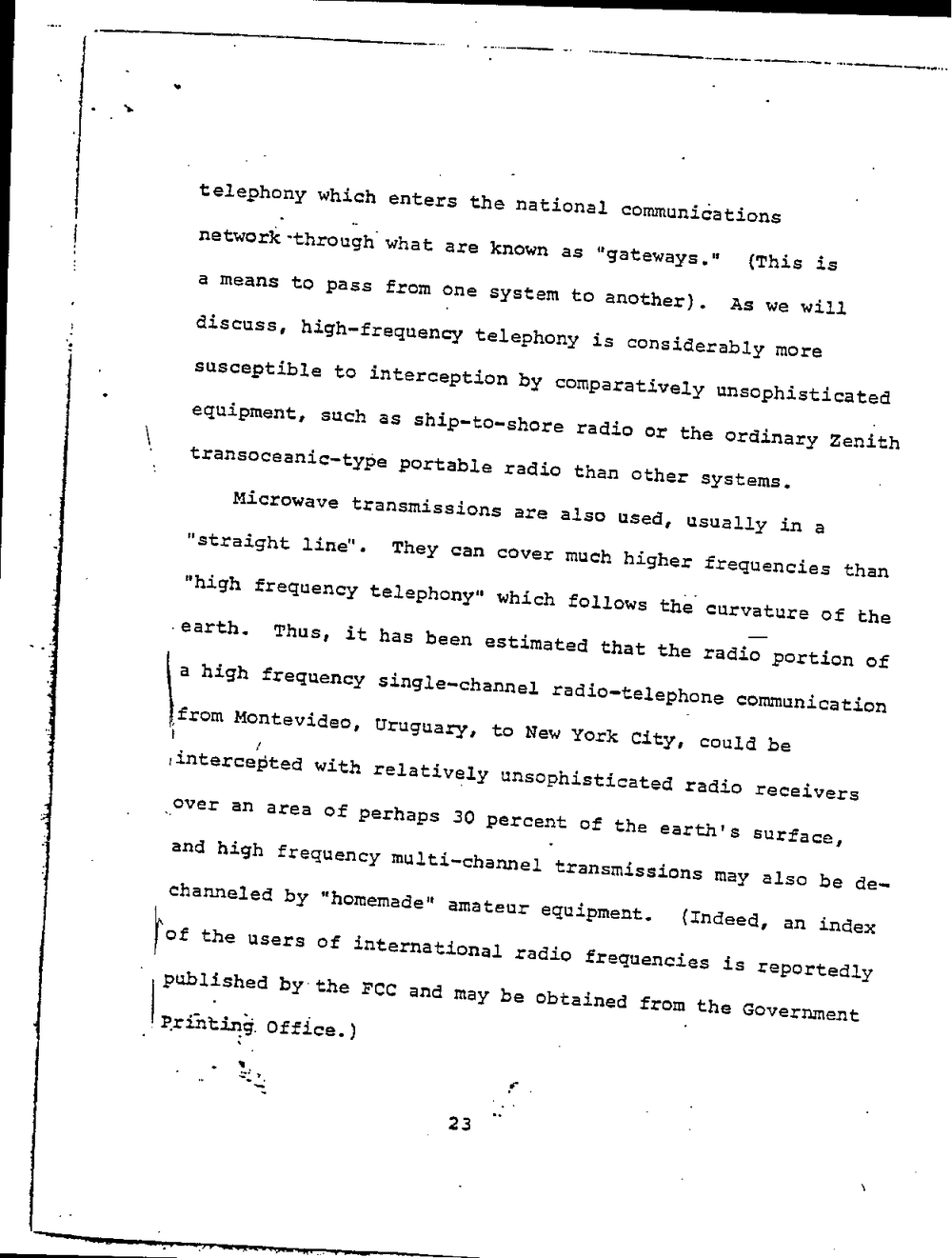
.
?x 1. lug.
.as'
L'd??l
telephony which enters the national communications
what are known as "gateways." (This is
a means to pass from one system to another). As we will
discuss, high-frequency telephony is considerably more
susceptible to interception by comparatively unsophisticated
equipment, such as ship-to-shore radio or the ordinary Zenith
transoceanic-type portable radio than other systems.
Microwave transmissions are also used, usually in a
"straight line". They can cover much higher frequencies than
"high frequency telephony" which follows the curvature of the
.earth. Thus, it has been estimated that the radio portion of
a high frequency single-channel radio-telephone communication
from Montevideo, Uruguary, to New York City, could be
23
.
?x 1. lug.
.as'
L'd??l
telephony which enters the national communications
what are known as "gateways." (This is
a means to pass from one system to another). As we will
discuss, high-frequency telephony is considerably more
susceptible to interception by comparatively unsophisticated
equipment, such as ship-to-shore radio or the ordinary Zenith
transoceanic-type portable radio than other systems.
Microwave transmissions are also used, usually in a
"straight line". They can cover much higher frequencies than
"high frequency telephony" which follows the curvature of the
.earth. Thus, it has been estimated that the radio portion of
a high frequency single-channel radio-telephone communication
from Montevideo, Uruguary, to New York City, could be
23
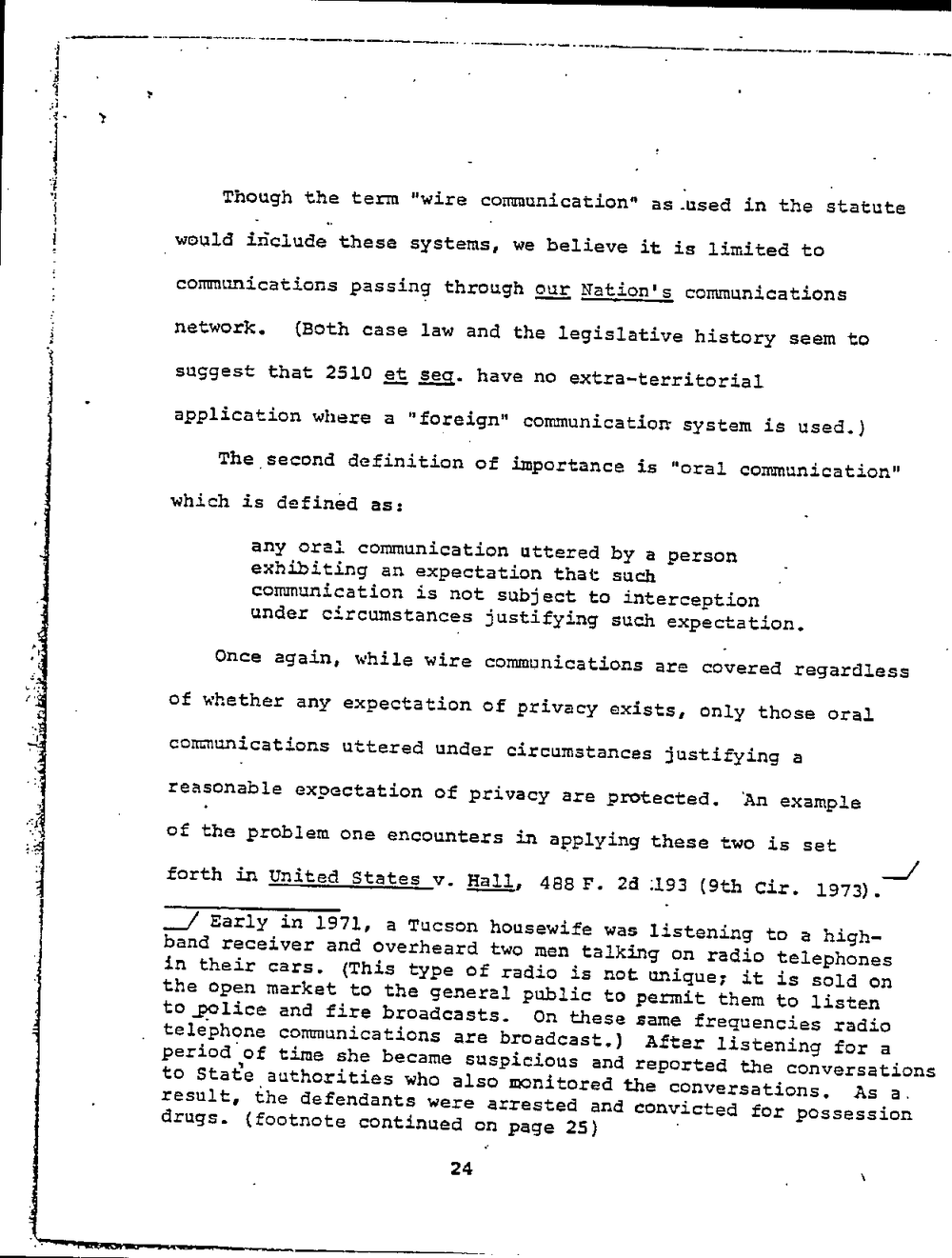
,akin.
Lu ini?mia?a
.
HALL
??31.44. ?u
Though the term "wire communication" as_used in the statute
would include these systems, we believe it is limited to
communications passing through communications
network. (Both case law and the legislative history seem to
suggest that 2510 33 Egg. have no extra?territorial
application where a "foreign" communication system is used.)
The_second definition of importance is "oral communication"
which is defined as:
any oral communication uttered by a person
exhibiting an expectation that such
communication is not subject to interception
under circumstances justifying such expectation.
Once again, while wire communications are covered regardless
of whether any expectation of privacy exists, only those oral
communications uttered under circumstances justifying a
reasonable expectation of privacy are protected. An example
of the problem one encounters in applying these two is set
forth in United States v. Hall, 488 F. 28:193 (9th Cir. 1973).
in 1971, a Tucson housewife was listening to a high-
band receiver and overheard two men talking on radio telephones
in their cars. (This type of radio is not unique: it is sold on
the Open market to the general public to permit them to listen
to_police and fire broadcasts. On these same frequencies radio
telephone communications are broadcast.) After listening for a
period?of time she became suspicious and reported the conversations
to State_authorities who also monitored the conversations. As a.
result, the defendants were arrested and convicted for possession
drugs. (footnote continued on page 25)
24
,akin.
Lu ini?mia?a
.
HALL
??31.44. ?u
Though the term "wire communication" as_used in the statute
would include these systems, we believe it is limited to
communications passing through communications
network. (Both case law and the legislative history seem to
suggest that 2510 33 Egg. have no extra?territorial
application where a "foreign" communication system is used.)
The_second definition of importance is "oral communication"
which is defined as:
any oral communication uttered by a person
exhibiting an expectation that such
communication is not subject to interception
under circumstances justifying such expectation.
Once again, while wire communications are covered regardless
of whether any expectation of privacy exists, only those oral
communications uttered under circumstances justifying a
reasonable expectation of privacy are protected. An example
of the problem one encounters in applying these two is set
forth in United States v. Hall, 488 F. 28:193 (9th Cir. 1973).
in 1971, a Tucson housewife was listening to a high-
band receiver and overheard two men talking on radio telephones
in their cars. (This type of radio is not unique: it is sold on
the Open market to the general public to permit them to listen
to_police and fire broadcasts. On these same frequencies radio
telephone communications are broadcast.) After listening for a
period?of time she became suspicious and reported the conversations
to State_authorities who also monitored the conversations. As a.
result, the defendants were arrested and convicted for possession
drugs. (footnote continued on page 25)
24
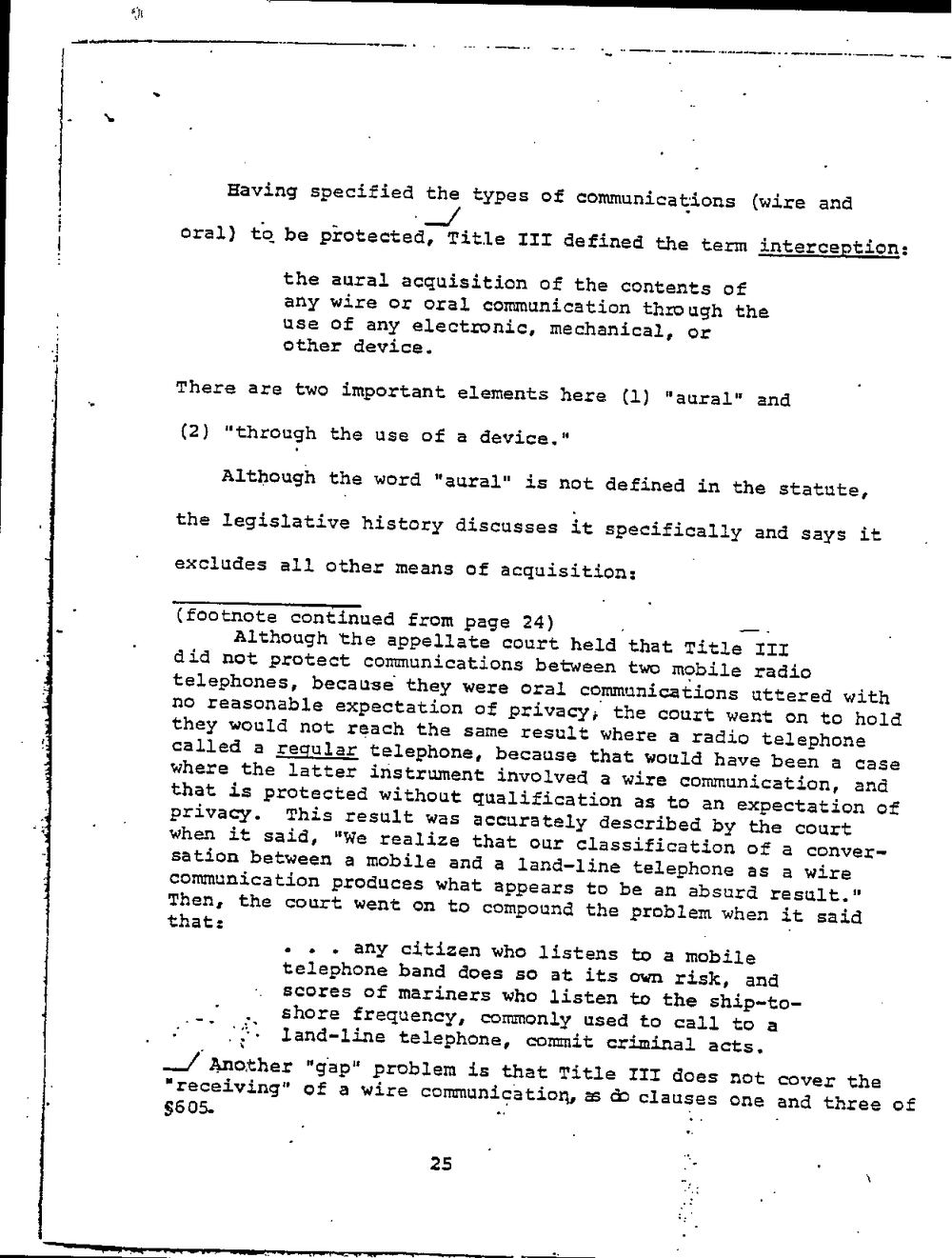
I. I
- LAQXILL -
- Jr.
Jim-.1.)
Having specified the types of communications (wire and
oral) to be protected, Title defined the term interception:
the aural acquisition of the contents of
any wire or oral communication through the
use of any electronic, mechanical, or
other device.
There are two important elements here (1) "aural" and
(2) "through the use of a device."
Although the word "aural" is not defined in the statute,
the legislative history discusses it specifically and says it
excludes all other means of acquisition:
(footnote continued from page 24)
Although the appellate court held that Title
did not protect communications between two mobile radio
telephones, because they were oral co unications uttered with
no reasonable expectation of privacy, the court went on to hold
they would not reach the same result where a radio telephone
called a regular telephone, because that would have been a case
where the latter instrument involved a wire communication, and
that is protected without qualification as to an expectation of
privacy. This result was accurately described by the court
when it said, "We realize that our classification of a conver-
sation between a mobile and a land-line telephone as a wire
communication produces what appears to be an absurd result."
Then, the court went on to compound the problem when it said
that: - I
. . . any citizen who listens to a mobile
telephone band does so at its own risk, and
. scores of mariners who listen to the ship-to?
shore frequency, commonly used to call to a
- land?line telephone, commit criminal acts.
Another "gap" problem is that Title does not cover the
I'receiving" of a wire communication, as Cb clauses one and three of
5605.
25
v-v-v?w-
I. I
- LAQXILL -
- Jr.
Jim-.1.)
Having specified the types of communications (wire and
oral) to be protected, Title defined the term interception:
the aural acquisition of the contents of
any wire or oral communication through the
use of any electronic, mechanical, or
other device.
There are two important elements here (1) "aural" and
(2) "through the use of a device."
Although the word "aural" is not defined in the statute,
the legislative history discusses it specifically and says it
excludes all other means of acquisition:
(footnote continued from page 24)
Although the appellate court held that Title
did not protect communications between two mobile radio
telephones, because they were oral co unications uttered with
no reasonable expectation of privacy, the court went on to hold
they would not reach the same result where a radio telephone
called a regular telephone, because that would have been a case
where the latter instrument involved a wire communication, and
that is protected without qualification as to an expectation of
privacy. This result was accurately described by the court
when it said, "We realize that our classification of a conver-
sation between a mobile and a land-line telephone as a wire
communication produces what appears to be an absurd result."
Then, the court went on to compound the problem when it said
that: - I
. . . any citizen who listens to a mobile
telephone band does so at its own risk, and
. scores of mariners who listen to the ship-to?
shore frequency, commonly used to call to a
- land?line telephone, commit criminal acts.
Another "gap" problem is that Title does not cover the
I'receiving" of a wire communication, as Cb clauses one and three of
5605.
25
v-v-v?w-
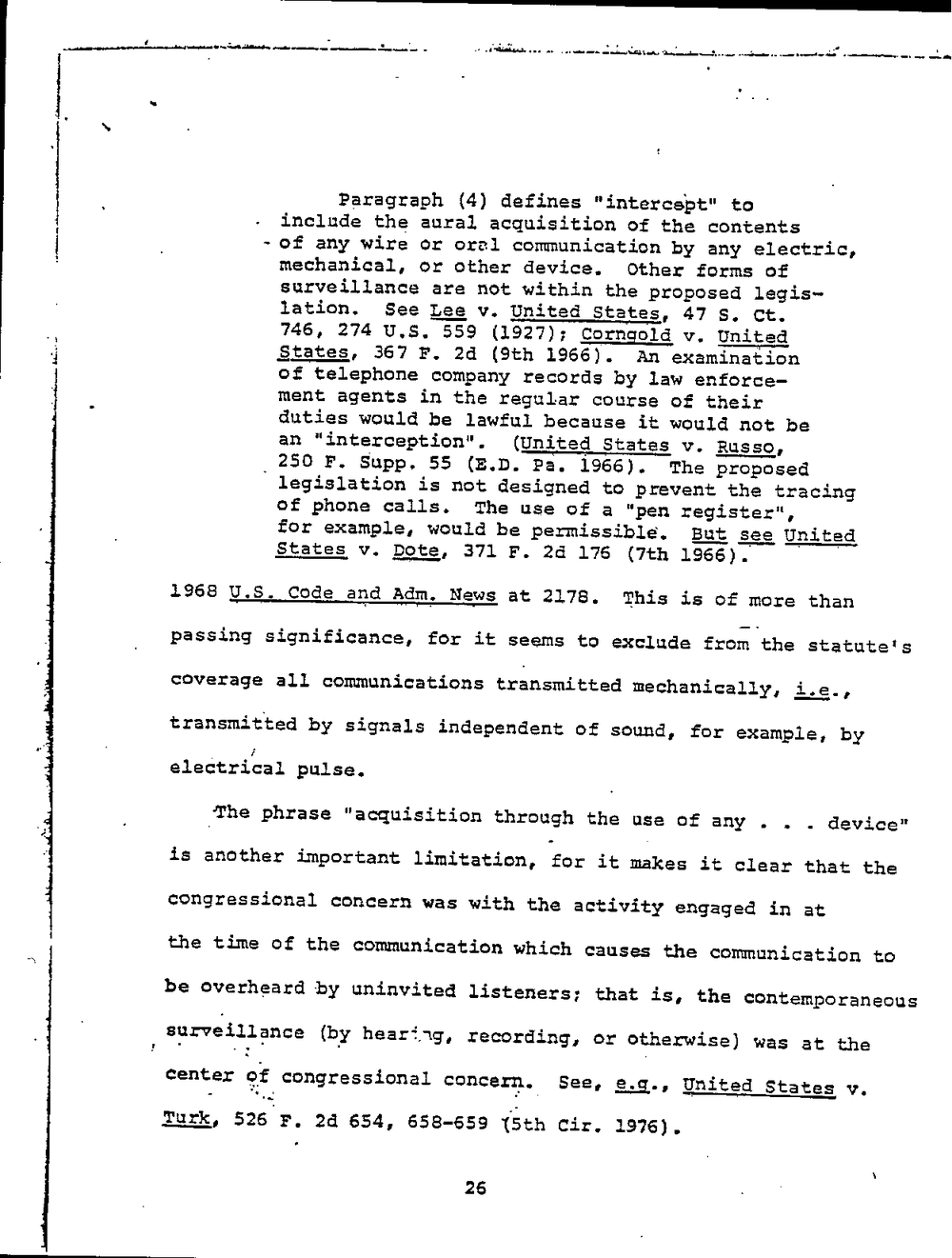
Paragraph (4) defines "intercept" to
include the aural acquisition of the contents
~rof any wire or oral communication by any electric,
mechanical, or other device. Other forms of
surveillance are not within the proposed legis-
lation. See Leg v. United States, 47 S. Ct.
746, 274 U.S. 559 (1927): Corngold v. United
?tates, 367 F. 2d (9th 1966). An examination
of telephone company records by law enforce-
ment agents in the regular course of their
duties would be lawful because it would not be
an "interception". (United states v. Russo,
. 250 F. Supp. 55 (E.D. Pa. 1966). The proposed
legislation is not designed to prevent the tracing
of phone calls. The use of a "pen register",
for example, would be permissible. But see United
States v. Dote, 371 a. 2d 176 (7th 1966).'
1968 q.s. Code and Adm. News at 2l78. This is of more than
passing significance, for it seems to exclude from the statute's
coverage all communications transmitted mechanically, iyg.,
transmitted by signals independent of sound, for example, by
electribal pulse.
?The phrase "acquisition through the use of any . . . device"
is another important limitation, tor it makes it clear that the
congressional concern was with the activity engaged in at
the time of the communication which causes the_communication to
be overheard by uninvited listeners: that is, the contemporaneous
surveillance (by hearing, recording, or otherwise) was at the
center of congressional concern. See, United States v.
-
9
Turk, 525 F. 2d 654, 658-659 13th Cir. 1976).
26
Paragraph (4) defines "intercept" to
include the aural acquisition of the contents
~rof any wire or oral communication by any electric,
mechanical, or other device. Other forms of
surveillance are not within the proposed legis-
lation. See Leg v. United States, 47 S. Ct.
746, 274 U.S. 559 (1927): Corngold v. United
?tates, 367 F. 2d (9th 1966). An examination
of telephone company records by law enforce-
ment agents in the regular course of their
duties would be lawful because it would not be
an "interception". (United states v. Russo,
. 250 F. Supp. 55 (E.D. Pa. 1966). The proposed
legislation is not designed to prevent the tracing
of phone calls. The use of a "pen register",
for example, would be permissible. But see United
States v. Dote, 371 a. 2d 176 (7th 1966).'
1968 q.s. Code and Adm. News at 2l78. This is of more than
passing significance, for it seems to exclude from the statute's
coverage all communications transmitted mechanically, iyg.,
transmitted by signals independent of sound, for example, by
electribal pulse.
?The phrase "acquisition through the use of any . . . device"
is another important limitation, tor it makes it clear that the
congressional concern was with the activity engaged in at
the time of the communication which causes the_communication to
be overheard by uninvited listeners: that is, the contemporaneous
surveillance (by hearing, recording, or otherwise) was at the
center of congressional concern. See, United States v.
-
9
Turk, 525 F. 2d 654, 658-659 13th Cir. 1976).
26
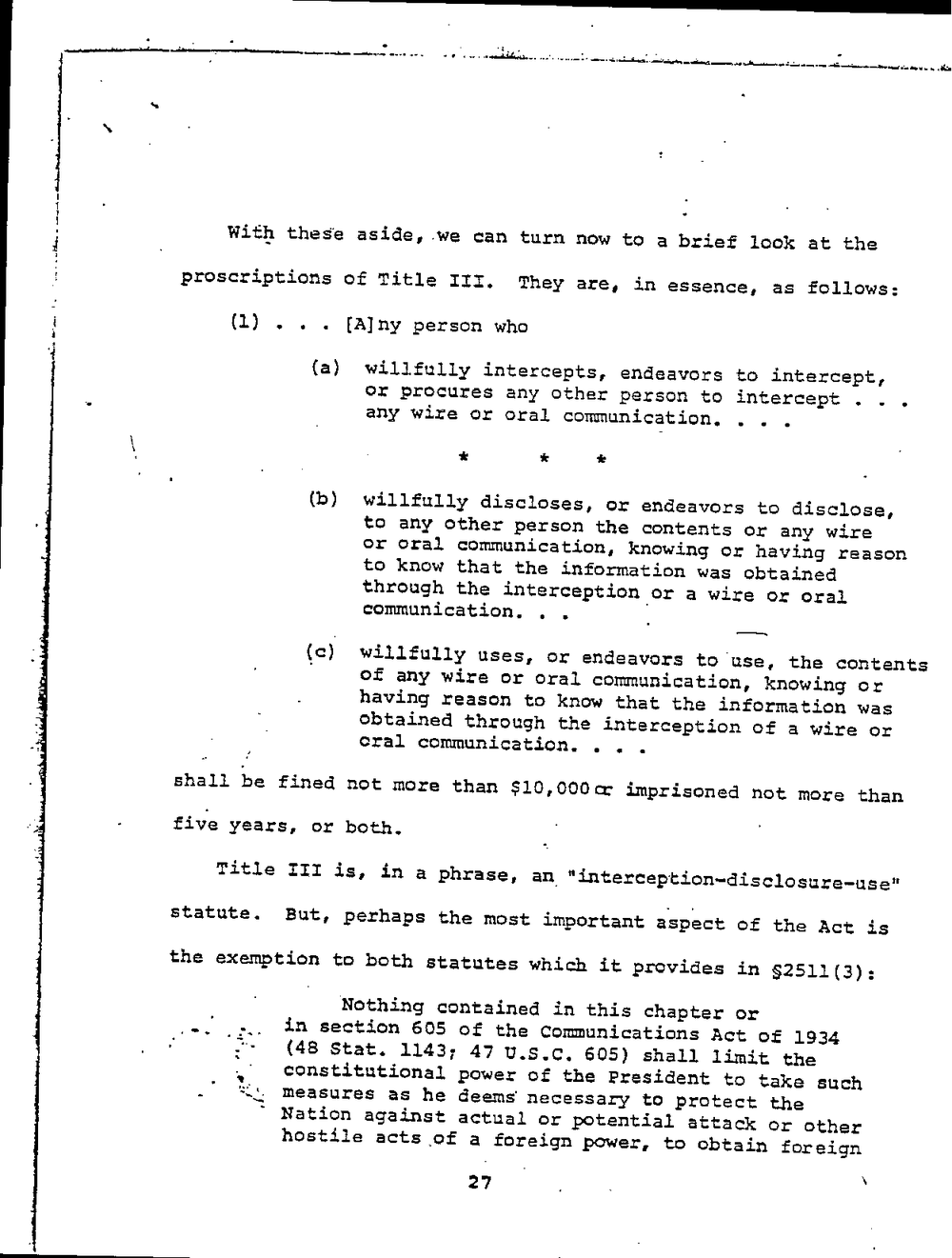
.
?Him
1-4.
nanan ?131
.4'1'11 uku.? A
LJI
J.
With these aside,.we can turn now to a brief look at the
proscriptions of Title They are, in essence, as follows:
(1) . . . [Alny person who
willfully intercepts, endeavors to intercept,
or procures any other person to intercept . . .
any wire or oral communication. . . .
i
willfully discloses, or endeavors to disclose,
to any other person the contents or any wire
or oral communication, knowing or having reason
to know that the information was obtained
through the interception or a Wire or oral
communication. . .
willfully uses, or endeavors to use, the contents
of any wire or oral communication, knowing or
having reason to know that the information was
obtained through the interception of a wire or
oral communication. . . .
shall be fined not more than $10,000cr imprisoned not more than
five years, or both.
Title is, in a phrase,
statute. But, perhaps the most important aspect of the Act is
the exemption to both statutes which it provides in ?2Sll(3):
Nothing contained in this chapter or
I in section 605 of the Communications Act of 1934
3- (48 Stat. 1143; 47 U.S.C. 605) shall limit the
constitutional power of the President to take such
measures as he deems necessary to protect the
Nation against actual or potential attack or other
hostile acts of a foreign power, to obtain foreign
I
I
II.
27
.
?Him
1-4.
nanan ?131
.4'1'11 uku.? A
LJI
J.
With these aside,.we can turn now to a brief look at the
proscriptions of Title They are, in essence, as follows:
(1) . . . [Alny person who
willfully intercepts, endeavors to intercept,
or procures any other person to intercept . . .
any wire or oral communication. . . .
i
willfully discloses, or endeavors to disclose,
to any other person the contents or any wire
or oral communication, knowing or having reason
to know that the information was obtained
through the interception or a Wire or oral
communication. . .
willfully uses, or endeavors to use, the contents
of any wire or oral communication, knowing or
having reason to know that the information was
obtained through the interception of a wire or
oral communication. . . .
shall be fined not more than $10,000cr imprisoned not more than
five years, or both.
Title is, in a phrase,
statute. But, perhaps the most important aspect of the Act is
the exemption to both statutes which it provides in ?2Sll(3):
Nothing contained in this chapter or
I in section 605 of the Communications Act of 1934
3- (48 Stat. 1143; 47 U.S.C. 605) shall limit the
constitutional power of the President to take such
measures as he deems necessary to protect the
Nation against actual or potential attack or other
hostile acts of a foreign power, to obtain foreign
I
I
II.
27
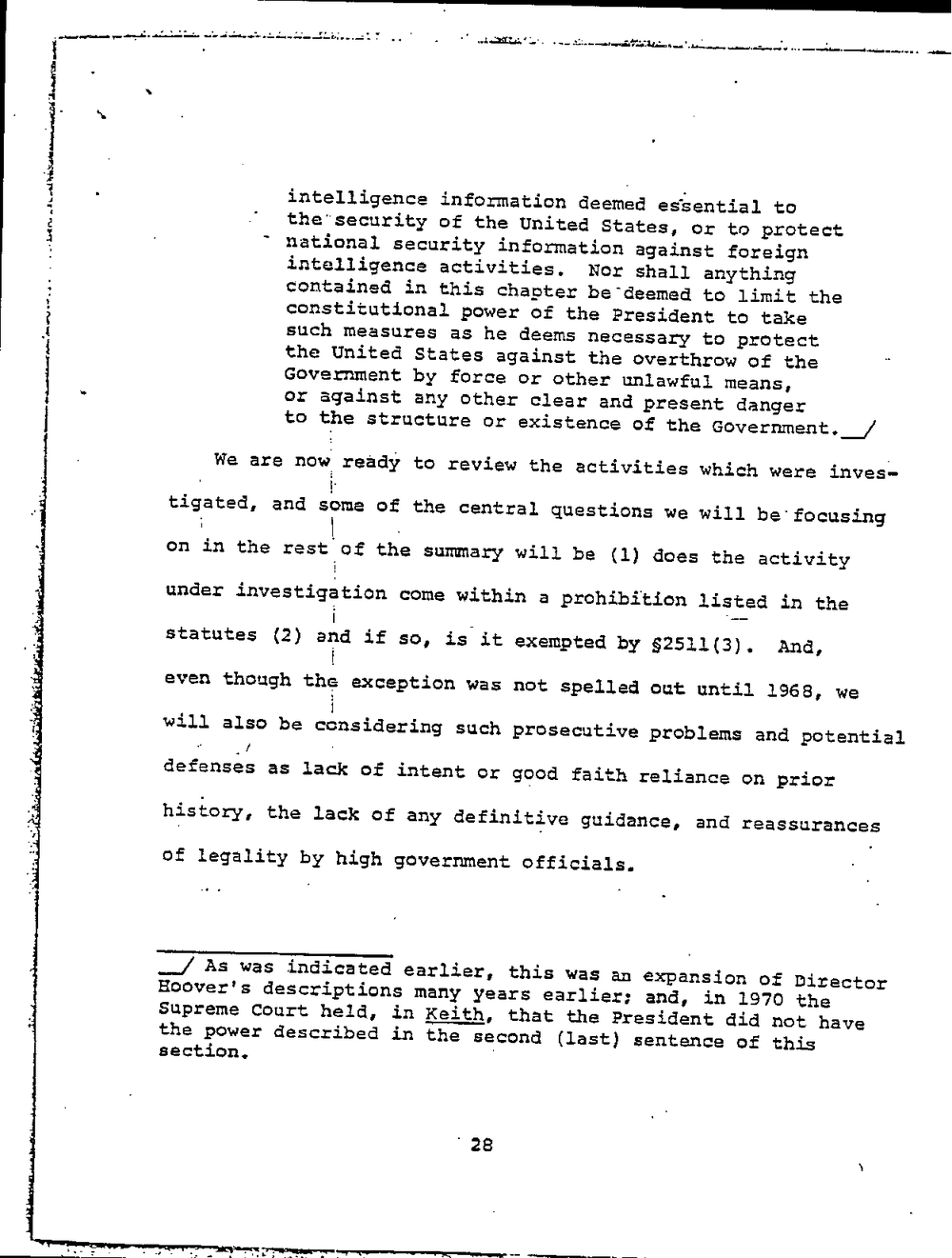
if?
.. . .. -.- .4?Ih?w-gI?H-hho?IC n. . qt.?
.
intelligence information deemed essential to
the security of the United States, or to protect
national security information against foreign
intelligence activities. Nor shall anything
contained in this chapter be?deemed to limit the
constitutional power of the President to take
such measures as he deems necessary to protect
the United States against the overthrow of the
Government by force or other unlawful means,
i or against any other clear and present danger
I to the structure or existence of the Government.__are now ready to review the activities which were invese
i
tigated, and some of the central questions we will be focusing
-
1 .
on in the rest of the summary will be (1) does the activity
under investigation come within a prohibition listed in the
'o
.
statutes (2) and if so, is it exempted by ?2511(3). And,
I
even though the exception was not spelled out until 1968, we
I
will also be considering such prosecutive problems and potential
.
defenses as lack of intent or good faith reliance on prior
history, the lack of any definitive guidance, and reassurances
of legality by high government officials.
n.
As was indicated earlier, this was an expansion of Director
Hoover's descriptions many years earlier: and, in 1970 the
Supreme Court held, in Keith, that the President did not have
the power described in the second (last) sentence of this
section.
.115?;
'28
-h?t?h
wwv?? ?wi? -w ?7 .v ?r wr?u??
.T. 1" . .
if?
.. . .. -.- .4?Ih?w-gI?H-hho?IC n. . qt.?
.
intelligence information deemed essential to
the security of the United States, or to protect
national security information against foreign
intelligence activities. Nor shall anything
contained in this chapter be?deemed to limit the
constitutional power of the President to take
such measures as he deems necessary to protect
the United States against the overthrow of the
Government by force or other unlawful means,
i or against any other clear and present danger
I to the structure or existence of the Government.__are now ready to review the activities which were invese
i
tigated, and some of the central questions we will be focusing
-
1 .
on in the rest of the summary will be (1) does the activity
under investigation come within a prohibition listed in the
'o
.
statutes (2) and if so, is it exempted by ?2511(3). And,
I
even though the exception was not spelled out until 1968, we
I
will also be considering such prosecutive problems and potential
.
defenses as lack of intent or good faith reliance on prior
history, the lack of any definitive guidance, and reassurances
of legality by high government officials.
n.
As was indicated earlier, this was an expansion of Director
Hoover's descriptions many years earlier: and, in 1970 the
Supreme Court held, in Keith, that the President did not have
the power described in the second (last) sentence of this
section.
.115?;
'28
-h?t?h
wwv?? ?wi? -w ?7 .v ?r wr?u??
.T. 1" . .
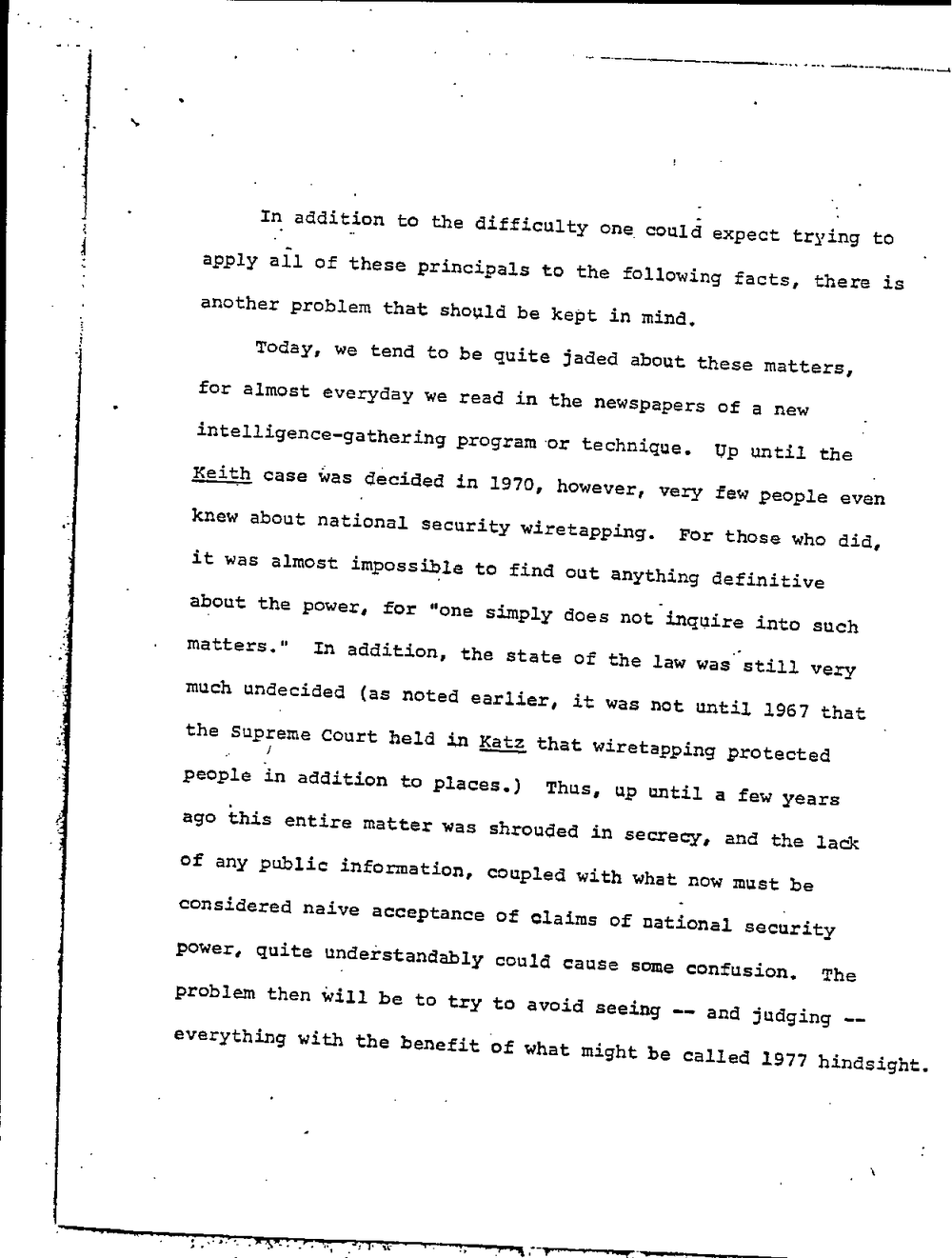
A
In addition to the difficulty one could expect trying to
apply all of these principals to the following facts, there is
another problem that should be kept in mind.
i Today, we tend to be quite jaded about these matters,
for almost everyday we read in the newspapers of a new
intelligence-gathering program or technique. Up until the?
igeigh case was decided in 1970, however, very few people even
knew about national security wiretapping. For those who did,
it was almost impossible to find out anything definitive
about the power, for "one simply does not inquire into such
matters." In addition, the state of the law was still very
much undecided (as noted earlier, it was not until 1967 that
the Supreme Court held in Katz that wiretapping protected
.
people in addition to places.) Thus, up until a few years
ago this entire matter was shrouded in secrecy, and the ladk
It? l'L'kL
of any public information, coupled with what now must be
1 considered naive acceptance of claims of national security
power, quite understandably could cause some confusion. The
problem then will be to try to avoid seeing -- and judging --
everything with the benefit of what might be called 1977 hindsight.
A
In addition to the difficulty one could expect trying to
apply all of these principals to the following facts, there is
another problem that should be kept in mind.
i Today, we tend to be quite jaded about these matters,
for almost everyday we read in the newspapers of a new
intelligence-gathering program or technique. Up until the?
igeigh case was decided in 1970, however, very few people even
knew about national security wiretapping. For those who did,
it was almost impossible to find out anything definitive
about the power, for "one simply does not inquire into such
matters." In addition, the state of the law was still very
much undecided (as noted earlier, it was not until 1967 that
the Supreme Court held in Katz that wiretapping protected
.
people in addition to places.) Thus, up until a few years
ago this entire matter was shrouded in secrecy, and the ladk
It? l'L'kL
of any public information, coupled with what now must be
1 considered naive acceptance of claims of national security
power, quite understandably could cause some confusion. The
problem then will be to try to avoid seeing -- and judging --
everything with the benefit of what might be called 1977 hindsight.
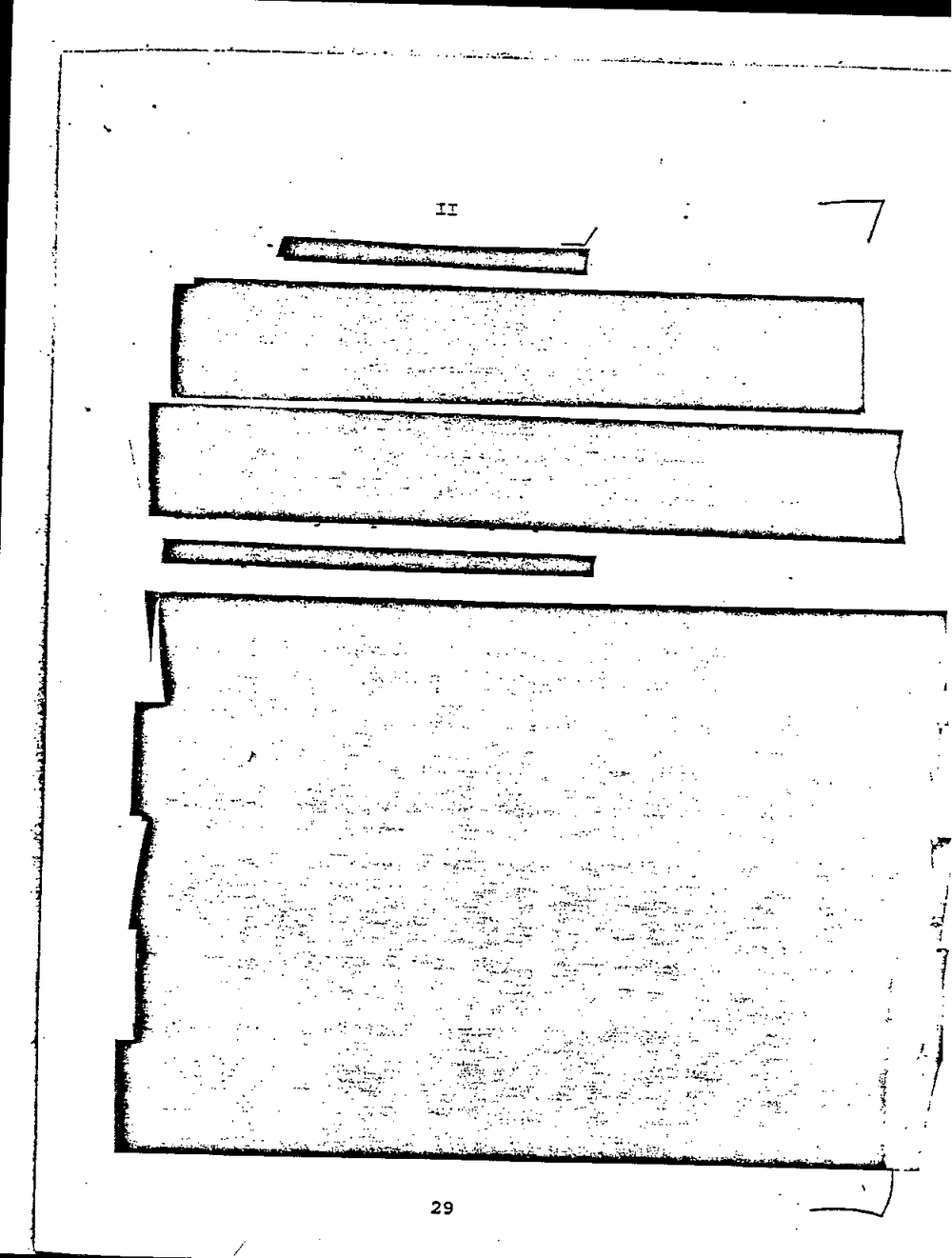
-. I.
:0 -po4 5 . .
. un- v?ux\fqu:lu
-. I.
:0 -po4 5 . .
. un- v?ux\fqu:lu
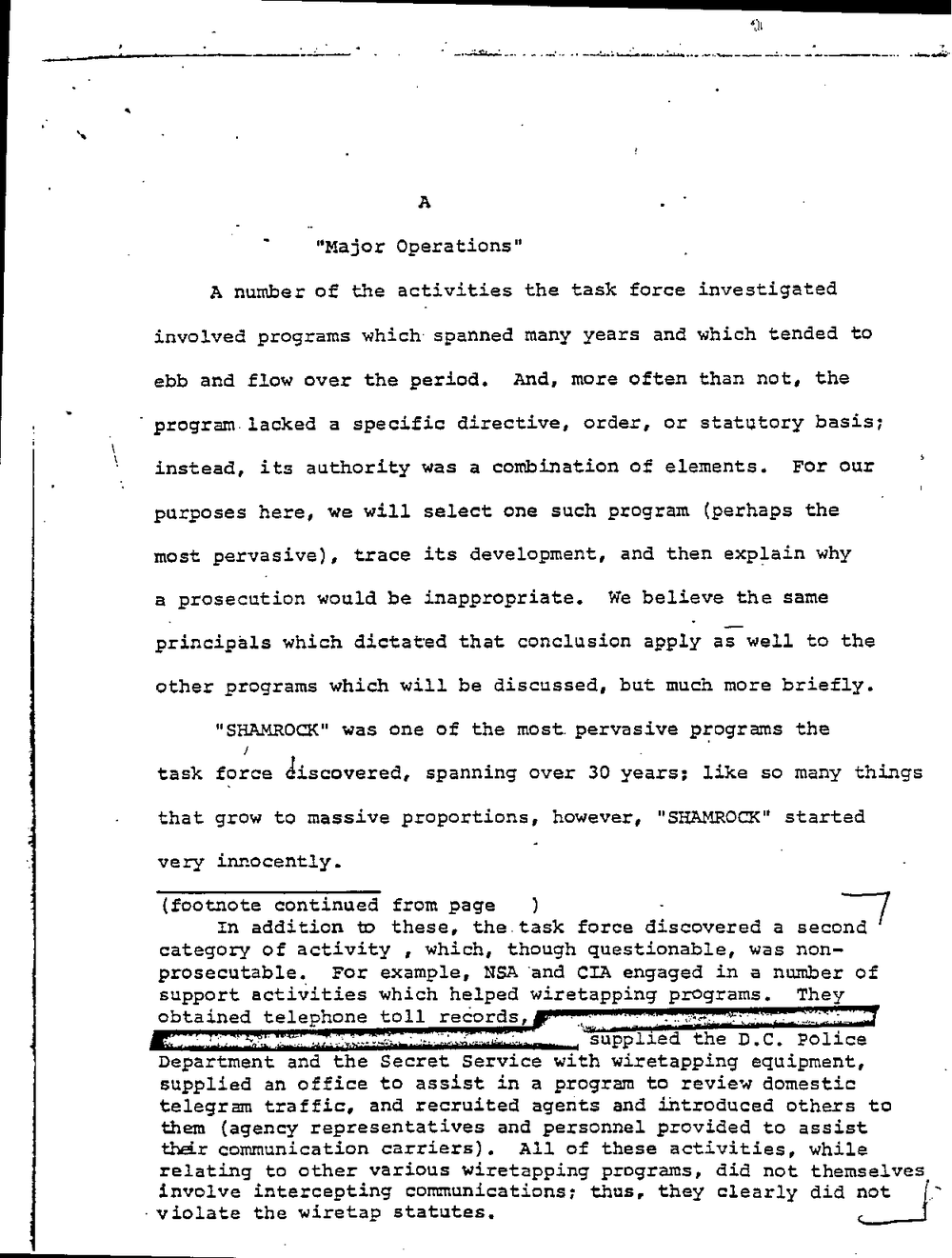
sl"II?I?n?-u-u - .- -A ohJ?
A .
""Major Operations"
A number of the activities the task force investigated
involved programs which-spanned many years and which tended to
ebb and flow over the period. And, more often than not, the
program lacked a specific directive, order, or statutory basis:
instead, its authority was a combination of elements. For our
purposes here, we will select one such program (perhaps the
most pervasive), trace its development, and then explain why
a prosecution would be inappropriate. We believe the same
principals which dictated that conclusion apply as-well to the
other programs which will be discussed, but much more briefly.
was one of the most.pervasive prograns the
.
task force iiscovered, spanning over 30 years; like so many things
that grow to massive proportions, however, started
-3 very innocently.
3 (footnote continued from page - 7
In addition t3 these, the task force discovered a second
category of activity which, though questionable, was non-
prosecutable. For example, NSA'and CIA engaged in a number of
support activities which helped wiretapping programs. They
obtained telephone toll records,
supplied the D.C. Police
Department and the Secret Service with wiretapping equipment,
supplied an office to assist in a program to review domestic
telegram traffic, and recruited agents and introduced others to
them (agency representatives and personnel provided to assist
4 ??rir communication carriers). All of these activities, while
relating to other various wiretapping programs, did not themselves
involve intercepting communications: thus, they clearly did not 3
-violate the wiretap statutes.
sl"II?I?n?-u-u - .- -A ohJ?
A .
""Major Operations"
A number of the activities the task force investigated
involved programs which-spanned many years and which tended to
ebb and flow over the period. And, more often than not, the
program lacked a specific directive, order, or statutory basis:
instead, its authority was a combination of elements. For our
purposes here, we will select one such program (perhaps the
most pervasive), trace its development, and then explain why
a prosecution would be inappropriate. We believe the same
principals which dictated that conclusion apply as-well to the
other programs which will be discussed, but much more briefly.
was one of the most.pervasive prograns the
.
task force iiscovered, spanning over 30 years; like so many things
that grow to massive proportions, however, started
-3 very innocently.
3 (footnote continued from page - 7
In addition t3 these, the task force discovered a second
category of activity which, though questionable, was non-
prosecutable. For example, NSA'and CIA engaged in a number of
support activities which helped wiretapping programs. They
obtained telephone toll records,
supplied the D.C. Police
Department and the Secret Service with wiretapping equipment,
supplied an office to assist in a program to review domestic
telegram traffic, and recruited agents and introduced others to
them (agency representatives and personnel provided to assist
4 ??rir communication carriers). All of these activities, while
relating to other various wiretapping programs, did not themselves
involve intercepting communications: thus, they clearly did not 3
-violate the wiretap statutes.
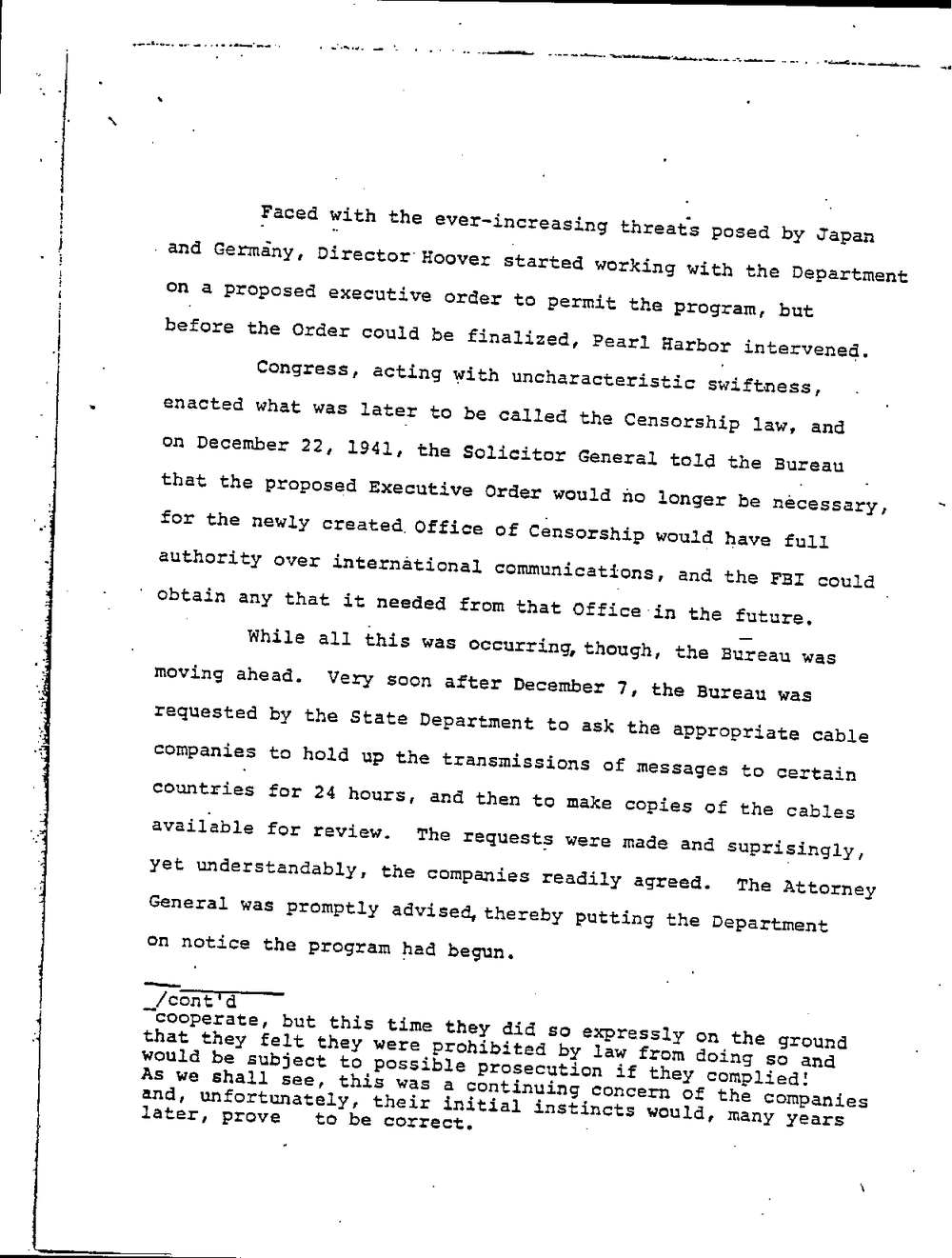
.
I -.
. ..
ALA .LK hull?aujwu.unn . 1,4,
.
.and GermanyFaced with the ever-increasing threats posed by Japan
Director Hoover started working with the Department
on a proposed executive order to permit the program, but
before the Order could be finalized, Pearl Harbor intervened.
Congress, acting with uncharacteristic swiftness,
enacted what was later to be called the Censorship law, and
on December 22, 1941, the Solicitor General told the Bureau
that the proposed Executive Order would no longer be necessary,
for the newly created Office of Censorship would have full
authority over international communications, and the FBI could?
obtain any that it needed from that Office in the future.
While all this was occurring;though, the Bureau was
moving ahead. Very soon after December 7, the Bureau was
requested by the State Department to ask the appropriate cable
companies to hold up the transmissions of messages to certain
countries for 24 hours, and then to make copies of the cables
available for review. The requests were made and suprisingly,
yet understandably, the companies readily agreed. The Attorney
General was advised,thereby putting the Department
on notice the program had begun.
/cont'd
"cooperate, but this time they did so expressly on the ground
that they felt they were prohibited by law from doing so and
would be subject to possible prosecution if they complied'
As we shall see, this was a continuing concern of the companies
and, unfortunately, their initial instincts would
later, prove to be correct. -
.
I -.
. ..
ALA .LK hull?aujwu.unn . 1,4,
.
.and GermanyFaced with the ever-increasing threats posed by Japan
Director Hoover started working with the Department
on a proposed executive order to permit the program, but
before the Order could be finalized, Pearl Harbor intervened.
Congress, acting with uncharacteristic swiftness,
enacted what was later to be called the Censorship law, and
on December 22, 1941, the Solicitor General told the Bureau
that the proposed Executive Order would no longer be necessary,
for the newly created Office of Censorship would have full
authority over international communications, and the FBI could?
obtain any that it needed from that Office in the future.
While all this was occurring;though, the Bureau was
moving ahead. Very soon after December 7, the Bureau was
requested by the State Department to ask the appropriate cable
companies to hold up the transmissions of messages to certain
countries for 24 hours, and then to make copies of the cables
available for review. The requests were made and suprisingly,
yet understandably, the companies readily agreed. The Attorney
General was advised,thereby putting the Department
on notice the program had begun.
/cont'd
"cooperate, but this time they did so expressly on the ground
that they felt they were prohibited by law from doing so and
would be subject to possible prosecution if they complied'
As we shall see, this was a continuing concern of the companies
and, unfortunately, their initial instincts would
later, prove to be correct. -
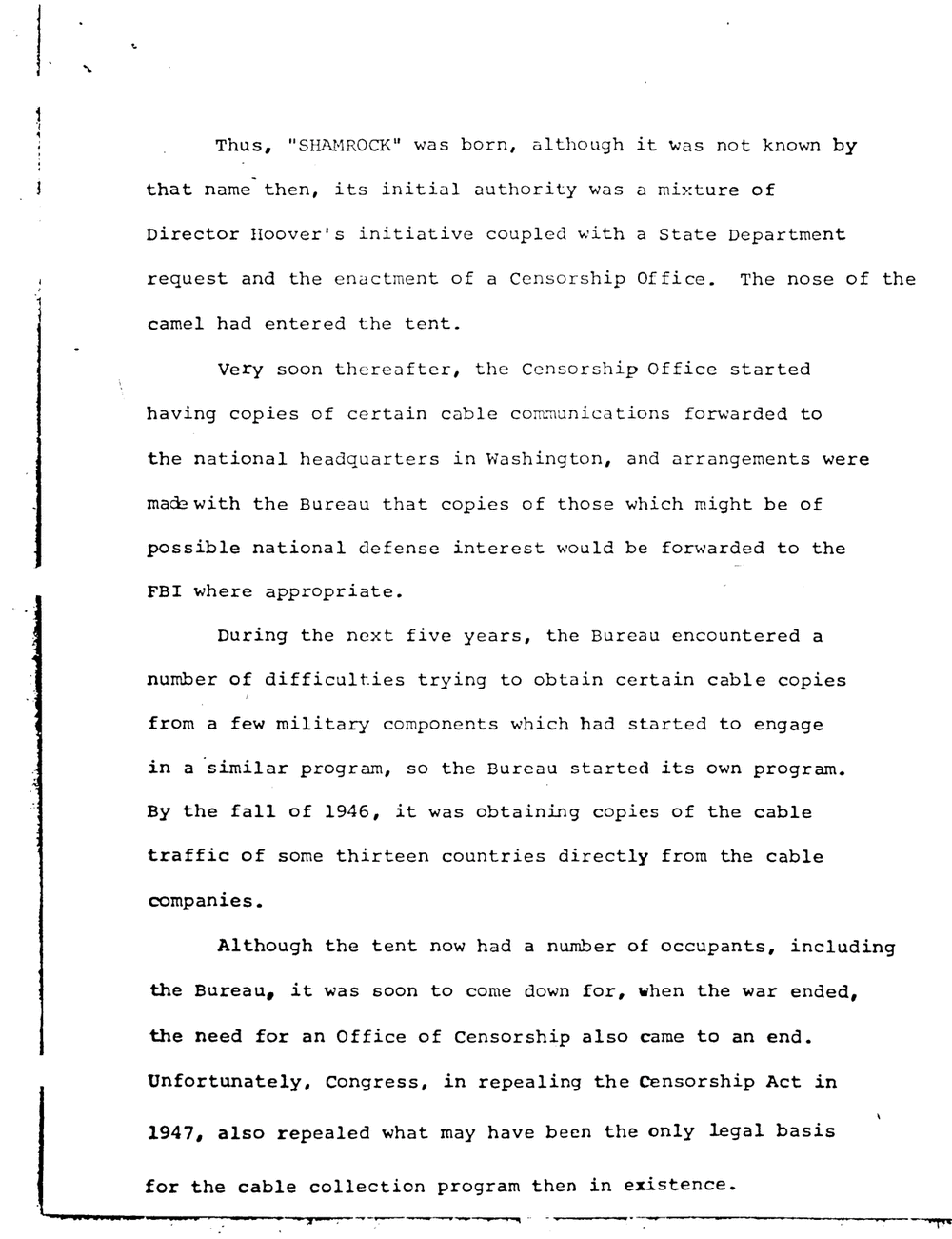
Thus, was born, although it was not known by
that name then, its initial authority was a mixture of
Director Hoover's initiative coupled with a State Department
request and the enactment of a Censorship Office. The nose of the
camel had entered the tent.
Very soon thereafter, the Censorship Office started
having copies of certain cable communications forwarded to
the national headquarters in Washington, and arrangements were
madawith the Bureau that COpies of those which might be of
possible national defense interest would be forwarded to the
FBI where apprOpriate.
During the next five years, the Bureau encountered a
number of difficulties trying to obtain certain cable COpies
from a few military components which had started to engage
in a similar program, so the Bureau started its own program.
By the fall of 1946, it was obtaining c0pies of the cable
traffic of some thirteen countries directly from the cable
companies.
Although the tent now had a number of occupants, including
the Bureau, it was soon to come down for, when the war ended,
the need for an Office of Censorship also came to an end.
Unfortunately, Congress, in repealing the Censorship Act in
1947, also repealed what may have been the only legal basis
for the cable collection program then in existence.
7w -vv?w
-v
Thus, was born, although it was not known by
that name then, its initial authority was a mixture of
Director Hoover's initiative coupled with a State Department
request and the enactment of a Censorship Office. The nose of the
camel had entered the tent.
Very soon thereafter, the Censorship Office started
having copies of certain cable communications forwarded to
the national headquarters in Washington, and arrangements were
madawith the Bureau that COpies of those which might be of
possible national defense interest would be forwarded to the
FBI where apprOpriate.
During the next five years, the Bureau encountered a
number of difficulties trying to obtain certain cable COpies
from a few military components which had started to engage
in a similar program, so the Bureau started its own program.
By the fall of 1946, it was obtaining c0pies of the cable
traffic of some thirteen countries directly from the cable
companies.
Although the tent now had a number of occupants, including
the Bureau, it was soon to come down for, when the war ended,
the need for an Office of Censorship also came to an end.
Unfortunately, Congress, in repealing the Censorship Act in
1947, also repealed what may have been the only legal basis
for the cable collection program then in existence.
7w -vv?w
-v
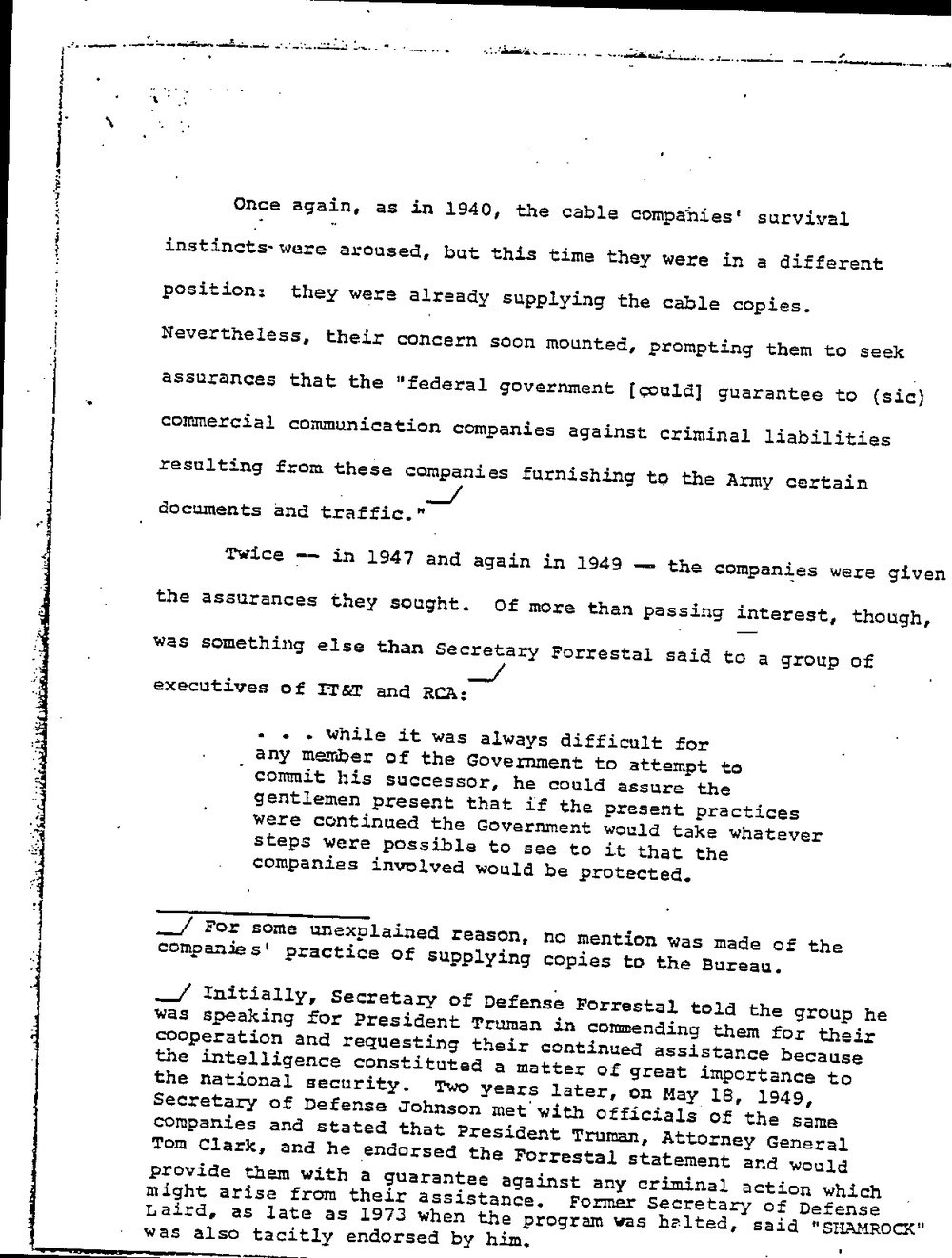
e1.- . . .. . ?Haitian. -. m?t
-. nub??
. I
.
?1
1-m?4
. gala-l .- Hui-r
A
141:
Ina?LL!me A
Once again. as in 1940, the cable companies' survival
instincts-were aroused, but this time they were in a different
position: they were already supplying the cable copies.
Nevertheless, their concern soon mounted, prompting them to seek
assurances that the "federal government [could] guarantee to (sic)
commercial communication companies against criminal liabilities
resulting from these companies furnishing to the Army certain
documents and traffic."
Twice r? in 1947 and again in 1949 the companies were given
the assurances they sought. Of more than passing interest, though,
was something else than Secretary Forrestal said to a group of
executives of and RCA: I
. . . while it was always difficult for
any member of the Government to attempt to
commit his successor, he could assure the
gentlemen present that if the present practices
were continued the Government would take whatever
steps were possible to see to it that the
companies involved would be protected.
For some unexplained reason, no mention was made of the
companies' practice of supplying cOpies to the Bureau.
Initially, Secretary of Defense Forrestal told the group he
was speaking for President Truman in commending them for their
the national security. Two years later, on May 18, 1949,
Secretary of Defense Johnson met with officials of the same
companies and stated that President Truman, Attorney General
Tom Clark, and he_endorsed the Forrestal statement and would
provide them with a guarantee against any criminal action which
might arise from their assistance. Former Secretary of Defense
Laird, as late as 1973 when the program was halted, said
was also tacitly endorsed by him. .
e1.- . . .. . ?Haitian. -. m?t
-. nub??
. I
.
?1
1-m?4
. gala-l .- Hui-r
A
141:
Ina?LL!me A
Once again. as in 1940, the cable companies' survival
instincts-were aroused, but this time they were in a different
position: they were already supplying the cable copies.
Nevertheless, their concern soon mounted, prompting them to seek
assurances that the "federal government [could] guarantee to (sic)
commercial communication companies against criminal liabilities
resulting from these companies furnishing to the Army certain
documents and traffic."
Twice r? in 1947 and again in 1949 the companies were given
the assurances they sought. Of more than passing interest, though,
was something else than Secretary Forrestal said to a group of
executives of and RCA: I
. . . while it was always difficult for
any member of the Government to attempt to
commit his successor, he could assure the
gentlemen present that if the present practices
were continued the Government would take whatever
steps were possible to see to it that the
companies involved would be protected.
For some unexplained reason, no mention was made of the
companies' practice of supplying cOpies to the Bureau.
Initially, Secretary of Defense Forrestal told the group he
was speaking for President Truman in commending them for their
the national security. Two years later, on May 18, 1949,
Secretary of Defense Johnson met with officials of the same
companies and stated that President Truman, Attorney General
Tom Clark, and he_endorsed the Forrestal statement and would
provide them with a guarantee against any criminal action which
might arise from their assistance. Former Secretary of Defense
Laird, as late as 1973 when the program was halted, said
was also tacitly endorsed by him. .
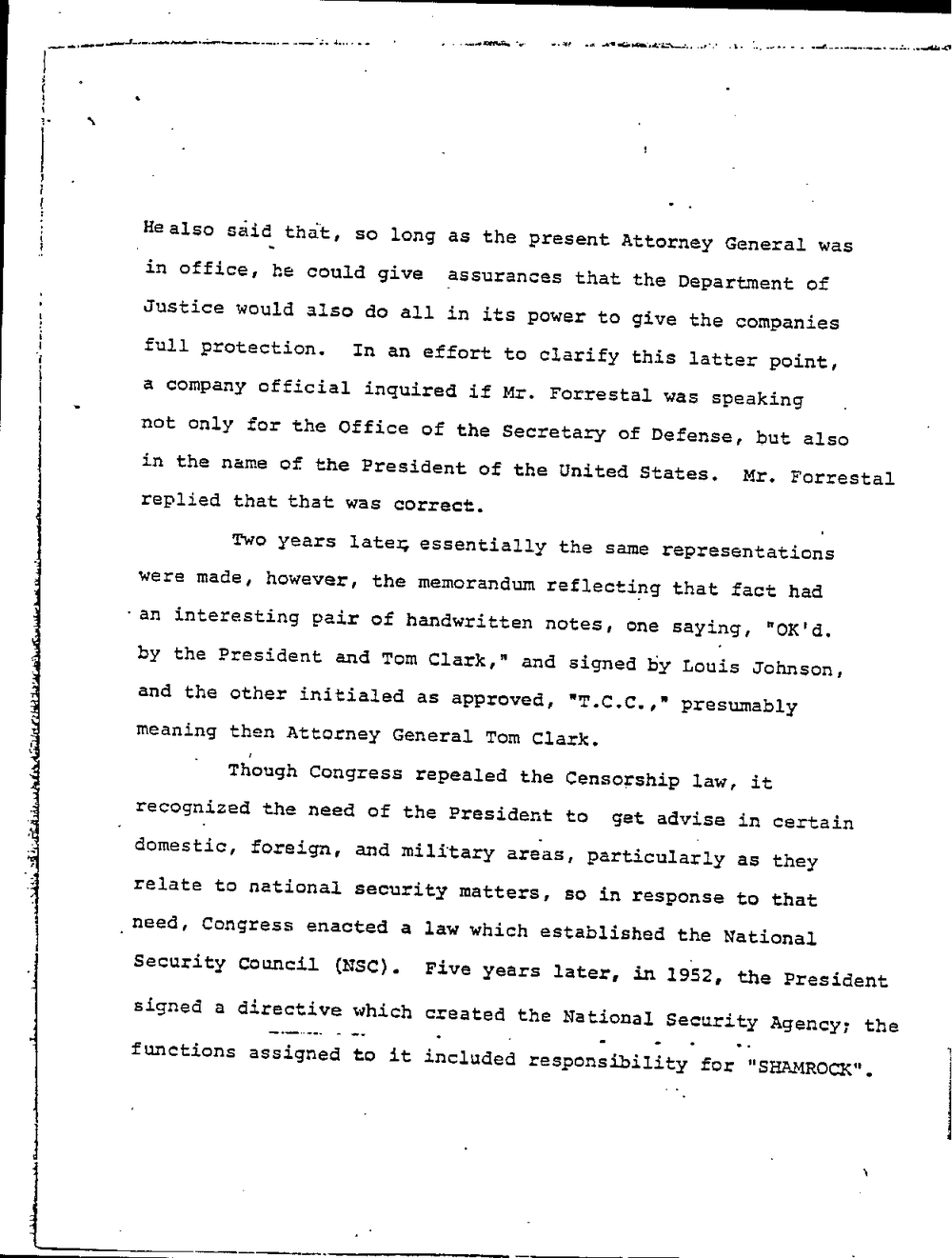
. may -a .1. ..-.. . .
.- u- .
.-.. .u n-an?v.
I
Healso said that, so long as the present Attorney General was
in office, he could give assurances that the Department of
Justice would also do all in its power to give the companies
full protection. In an effort to clarify this latter point,
a. -pns?
a company official inquired if Mr. Forrestal was speaking
not only for the Office of the Secretary of Defense, but also
in the name of the President of the United States. Mr. Forrestal
replied that that was correct.
Two years later essentially the same representations
were made, however, the memorandum reflecting that fact had
-an interesting pair of handwritten notes, one saying,
by the President and Tom Clark," and signed by Louis Johnson,
and the other initialed as approved, presumably
meaning then Attorney General Tom Clark.
Though Congress repealed the Censorship law, it
recognized the need of the President to get advise in certain
domestic, foreign, and military areas, particularly as they
. I o- n_ I
\djiymdlAJlnh?? Hat?mn"?hmnuluwuahum -
relate to national security matters, so in response to that
L-
Aneed, Congress enacted a law which established the National
5 Security Council (NSC). Five years later, in 1952, the President
signed a directive which created the National Security Agency; the
. - - .
functions assigned to it included responsibility for
A. .J
. may -a .1. ..-.. . .
.- u- .
.-.. .u n-an?v.
I
Healso said that, so long as the present Attorney General was
in office, he could give assurances that the Department of
Justice would also do all in its power to give the companies
full protection. In an effort to clarify this latter point,
a. -pns?
a company official inquired if Mr. Forrestal was speaking
not only for the Office of the Secretary of Defense, but also
in the name of the President of the United States. Mr. Forrestal
replied that that was correct.
Two years later essentially the same representations
were made, however, the memorandum reflecting that fact had
-an interesting pair of handwritten notes, one saying,
by the President and Tom Clark," and signed by Louis Johnson,
and the other initialed as approved, presumably
meaning then Attorney General Tom Clark.
Though Congress repealed the Censorship law, it
recognized the need of the President to get advise in certain
domestic, foreign, and military areas, particularly as they
. I o- n_ I
\djiymdlAJlnh?? Hat?mn"?hmnuluwuahum -
relate to national security matters, so in response to that
L-
Aneed, Congress enacted a law which established the National
5 Security Council (NSC). Five years later, in 1952, the President
signed a directive which created the National Security Agency; the
. - - .
functions assigned to it included responsibility for
A. .J
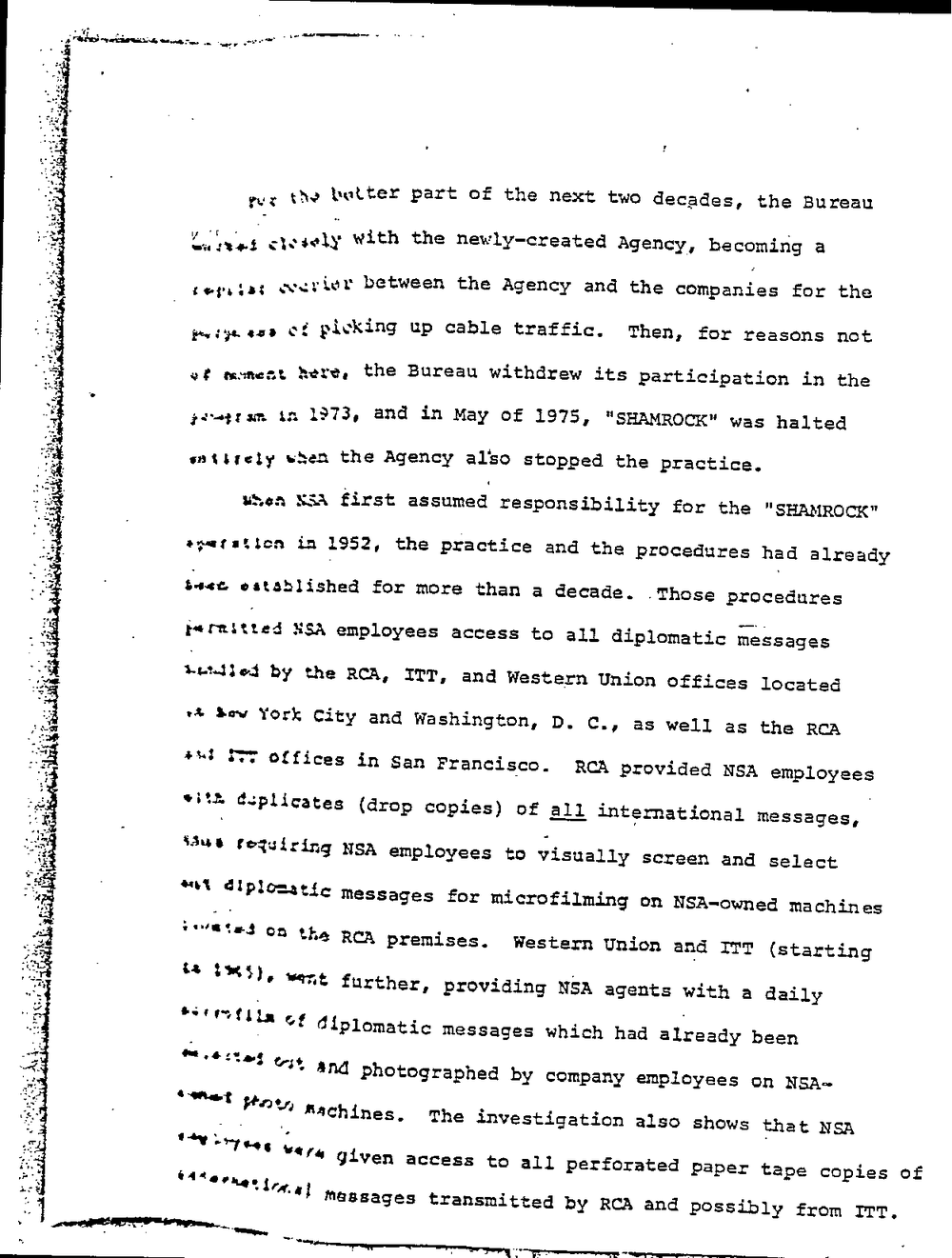
.
?0.n
better part of the next two decades, the Bureau
LI
with the newly?created Agency, becoming a
:14? .-
.H S. ?Hwy between the Agency and the companies for the
{?Ff'io
of Picking up cable traffic. Then, for reasons not
a, ?men; here, the Bureau withdrew its participation in the
?muse. 1973. and in May Of 1975, was halted
.ng;;?1y seen the Agency also stopped the practice.
3333 3591 first assumed responsibility for the
wet-Hon in 1952, the practice and the procedures had already
{use enablished for more than a decade. .Those procedures
iumsucd SSA employees access to all diplomatic messages
34.14393 by the RCA, ITT, and Western Union offices located
.1. 5w Tor]: City and Washington, D. C., as well as the RCA
n4 Offices in San Francisco. RCA provided NSA employees
with. d?plicates (drOp copies) of all intemational messages,
?Wiring NSA employees to visually screen and select
?Plastic messages for microfilming on LISA?owned machines
nun-d on the RCA premises. Western Union and ITT (starting
?4 NIH), 1am: further, providing NSA agents with a daily
Hot-sun a! diplomatic messages which had already been
0,19.
and photographed by company employees on 151515.:-
.
machines. The investigation also shows that NSA
17"" given access to all perforated paper tape cepies of
messages transmitted by RCA and possibly from ITT.
.-
f?n?v 1
F. r-I
.
?0.n
better part of the next two decades, the Bureau
LI
with the newly?created Agency, becoming a
:14? .-
.H S. ?Hwy between the Agency and the companies for the
{?Ff'io
of Picking up cable traffic. Then, for reasons not
a, ?men; here, the Bureau withdrew its participation in the
?muse. 1973. and in May Of 1975, was halted
.ng;;?1y seen the Agency also stopped the practice.
3333 3591 first assumed responsibility for the
wet-Hon in 1952, the practice and the procedures had already
{use enablished for more than a decade. .Those procedures
iumsucd SSA employees access to all diplomatic messages
34.14393 by the RCA, ITT, and Western Union offices located
.1. 5w Tor]: City and Washington, D. C., as well as the RCA
n4 Offices in San Francisco. RCA provided NSA employees
with. d?plicates (drOp copies) of all intemational messages,
?Wiring NSA employees to visually screen and select
?Plastic messages for microfilming on LISA?owned machines
nun-d on the RCA premises. Western Union and ITT (starting
?4 NIH), 1am: further, providing NSA agents with a daily
Hot-sun a! diplomatic messages which had already been
0,19.
and photographed by company employees on 151515.:-
.
machines. The investigation also shows that NSA
17"" given access to all perforated paper tape cepies of
messages transmitted by RCA and possibly from ITT.
.-
f?n?v 1
F. r-I
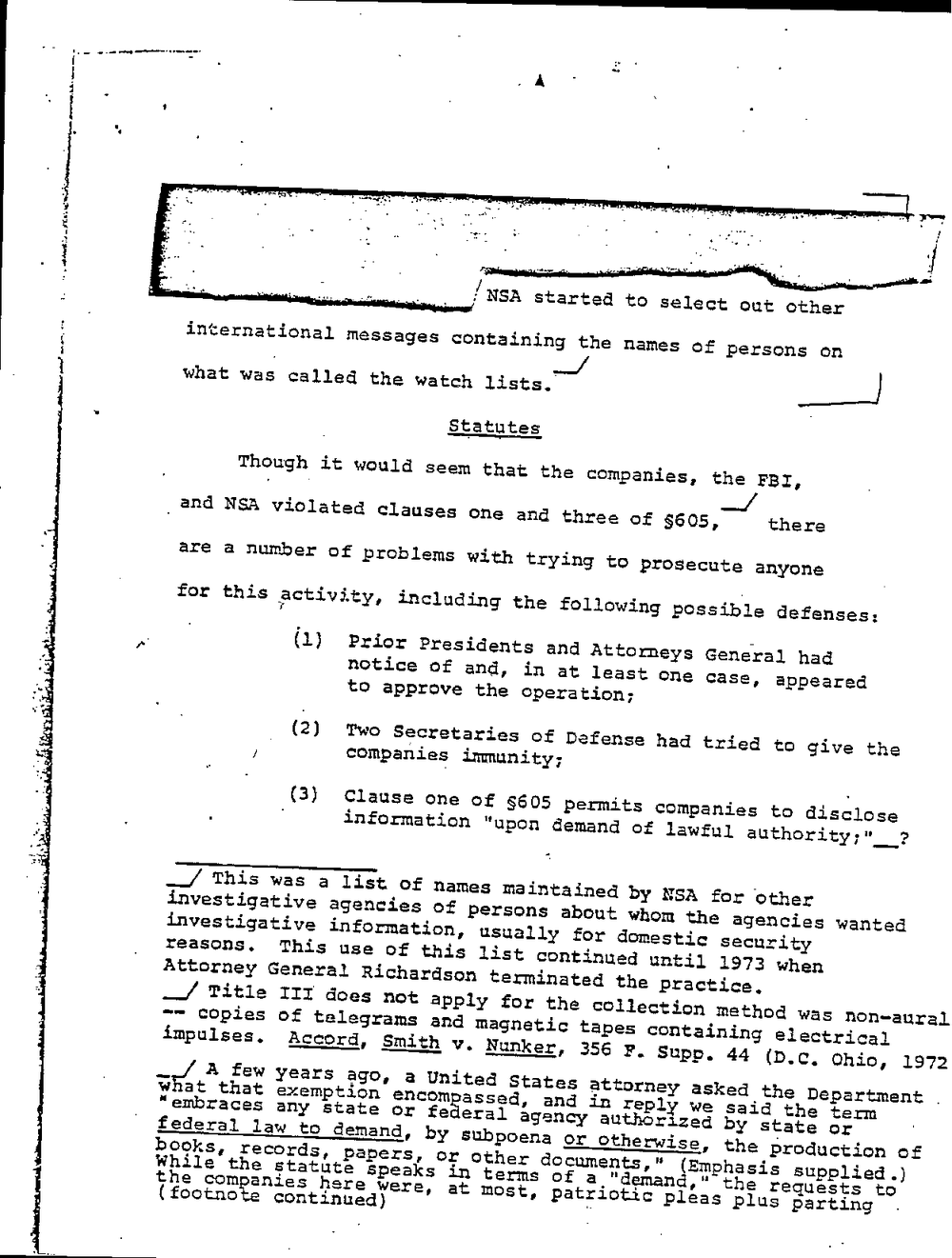
started to select out other
international messages containing the names of persons on
.
what was called the watch lists.
I statutes
_l
Though it would seem that the companies, the FBI,
1 :and NSA violated clauses one and three of ?605, there
for this_?ctivity, including the following possible defenses:
a A. I (1) Prior Presidents and Attorneys General had
notice of and, in at least one case, appeared
3 to approve the operation:
(2) Two Secretaries of Defense had tried to give the
companies immunity:
(3) Clause one of ?605 permits companies to disclose
information "upon demand of lawful
.
a
. r-
This was a list of names maintained by NSA for other
investigative agencies of persons about whom the agencies wanted
investigative information, usually for domestic security
reasons. This use of this list continued until 1973 when
Attorney General Richardson terminated the practice.
Title does not apply for the collection method was non-aural
-- copies of telegrams and magnetic tapes containing electrical
impulses. Accord, Smith v. Nunker, 356 F. Supp. 44 (D.C. Ohio, 1972
A few years ago, a United States attorney asked the Department .
at that exemption encomgassed, and in reply we said the term
?embraces any state or fe
1 federal law to demand, by subpoena or otherwise, the production of
1 books, records, papers, or other documents," (Emphasis supplied.)
While the statute speaks in terms of the requests to
com anies here were, at most, patriotic pleas plus parting
(footno continued)
started to select out other
international messages containing the names of persons on
.
what was called the watch lists.
I statutes
_l
Though it would seem that the companies, the FBI,
1 :and NSA violated clauses one and three of ?605, there
for this_?ctivity, including the following possible defenses:
a A. I (1) Prior Presidents and Attorneys General had
notice of and, in at least one case, appeared
3 to approve the operation:
(2) Two Secretaries of Defense had tried to give the
companies immunity:
(3) Clause one of ?605 permits companies to disclose
information "upon demand of lawful
.
a
. r-
This was a list of names maintained by NSA for other
investigative agencies of persons about whom the agencies wanted
investigative information, usually for domestic security
reasons. This use of this list continued until 1973 when
Attorney General Richardson terminated the practice.
Title does not apply for the collection method was non-aural
-- copies of telegrams and magnetic tapes containing electrical
impulses. Accord, Smith v. Nunker, 356 F. Supp. 44 (D.C. Ohio, 1972
A few years ago, a United States attorney asked the Department .
at that exemption encomgassed, and in reply we said the term
?embraces any state or fe
1 federal law to demand, by subpoena or otherwise, the production of
1 books, records, papers, or other documents," (Emphasis supplied.)
While the statute speaks in terms of the requests to
com anies here were, at most, patriotic pleas plus parting
(footno continued)
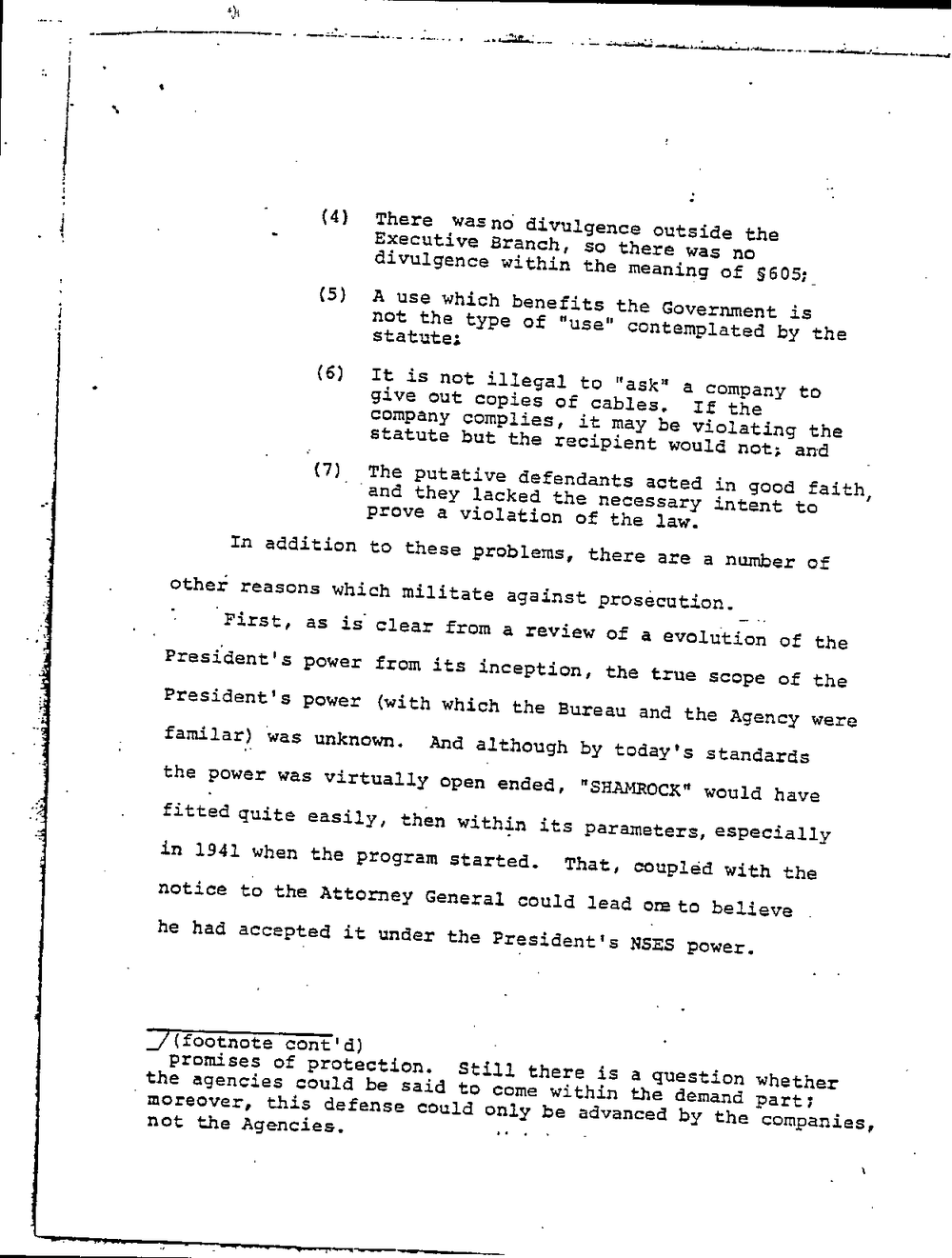
ul-
nuU-h-M ..
.
(4) There ?waSno divulgence outside the
Executive Branch, so there was no
divulgence within the meaning of $605;_
. I
I
(5) A use which benefits the Government is
i not the type of "use" contemplated by the
5 statute;
(6) It is not illegal to "ask" a company to
. give out copies of cables. If the
company complies, it may be violating the
statute but the recipient would not; and
(7) The putative defendants acted in good faith,
"and they lacked the necessary intent to
prove a violation of the law.
In addition to these problems, there are a number of
other reasons which militate against prosecution.
'First, as is clear from a review of a evolution of the
. .
-.
"11.7?1li
President's power from its inception, the true scope of the
President's power (with which the Bureau and the Agency were
familar) was unknown. And although by today's standards
the power was virtually open ended, would have
fittedlquite easily, then within its parameters,eSPECiallY
in 1941 when the program started. That, coupled with the
I I
. .
1 LAMA
notice to the Attorney General could lead onato believe
he had accepted it under the President's NSES power.
_/(footnote cont'd)
promises of protection. Still there is a question whether
the agencies could be said to come within the demand part:
moreover, this defense could only be advanced by the companies,
not the Agencies. .-- -
--
ul-
nuU-h-M ..
.
(4) There ?waSno divulgence outside the
Executive Branch, so there was no
divulgence within the meaning of $605;_
. I
I
(5) A use which benefits the Government is
i not the type of "use" contemplated by the
5 statute;
(6) It is not illegal to "ask" a company to
. give out copies of cables. If the
company complies, it may be violating the
statute but the recipient would not; and
(7) The putative defendants acted in good faith,
"and they lacked the necessary intent to
prove a violation of the law.
In addition to these problems, there are a number of
other reasons which militate against prosecution.
'First, as is clear from a review of a evolution of the
. .
-.
"11.7?1li
President's power from its inception, the true scope of the
President's power (with which the Bureau and the Agency were
familar) was unknown. And although by today's standards
the power was virtually open ended, would have
fittedlquite easily, then within its parameters,eSPECiallY
in 1941 when the program started. That, coupled with the
I I
. .
1 LAMA
notice to the Attorney General could lead onato believe
he had accepted it under the President's NSES power.
_/(footnote cont'd)
promises of protection. Still there is a question whether
the agencies could be said to come within the demand part:
moreover, this defense could only be advanced by the companies,
not the Agencies. .-- -
--
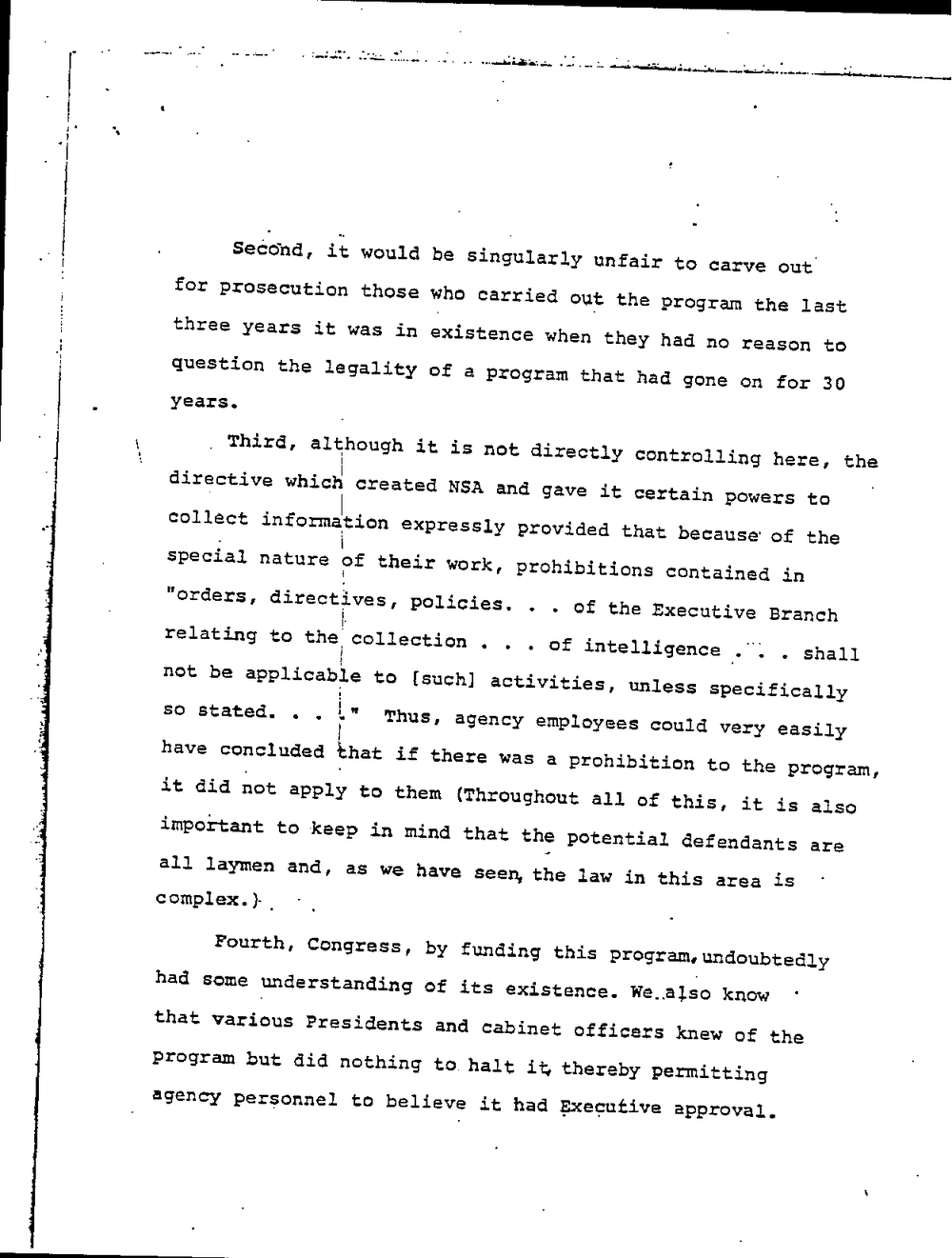
Second, it would be singularly unfair to carve out.
for prosecution those who carried out the program the last
three years it was in existence when they had no reason to
question the legality of a program that had gone on for 30
years.
Third, although it is not directly controlling here, the
directive whicg created NSA and gave it certain powers to
collect information expressly provided that because?of the
- I
special nature of their work, prohibitions contained in
5
I
A
?11
"orders, directives, policies. . . of the Executive Branch
I
.n
relating to the?collection . . . of intelligence . . . shall
.
not be applicable to [such] activities, unless specifically
so stated. . . Thus, agency employees could very easily
have concluded that if there was a prohibition to the program,
it did not apply to them (Throughout all of this, it is also
important to keep in mind that the potential defendants are
. . . a.
v!
all laymen and, as we have seen,the law in this area is
complex.}_
LL14
Fourth, Congress, by funding this program,undoubtedly
had some understanding of its existence. Weualso know
that various Presidents and cabinet officers knew of the
program but did nothing to halt it thereby permitting
agency personnel to believe it had Executive approval.
Second, it would be singularly unfair to carve out.
for prosecution those who carried out the program the last
three years it was in existence when they had no reason to
question the legality of a program that had gone on for 30
years.
Third, although it is not directly controlling here, the
directive whicg created NSA and gave it certain powers to
collect information expressly provided that because?of the
- I
special nature of their work, prohibitions contained in
5
I
A
?11
"orders, directives, policies. . . of the Executive Branch
I
.n
relating to the?collection . . . of intelligence . . . shall
.
not be applicable to [such] activities, unless specifically
so stated. . . Thus, agency employees could very easily
have concluded that if there was a prohibition to the program,
it did not apply to them (Throughout all of this, it is also
important to keep in mind that the potential defendants are
. . . a.
v!
all laymen and, as we have seen,the law in this area is
complex.}_
LL14
Fourth, Congress, by funding this program,undoubtedly
had some understanding of its existence. Weualso know
that various Presidents and cabinet officers knew of the
program but did nothing to halt it thereby permitting
agency personnel to believe it had Executive approval.
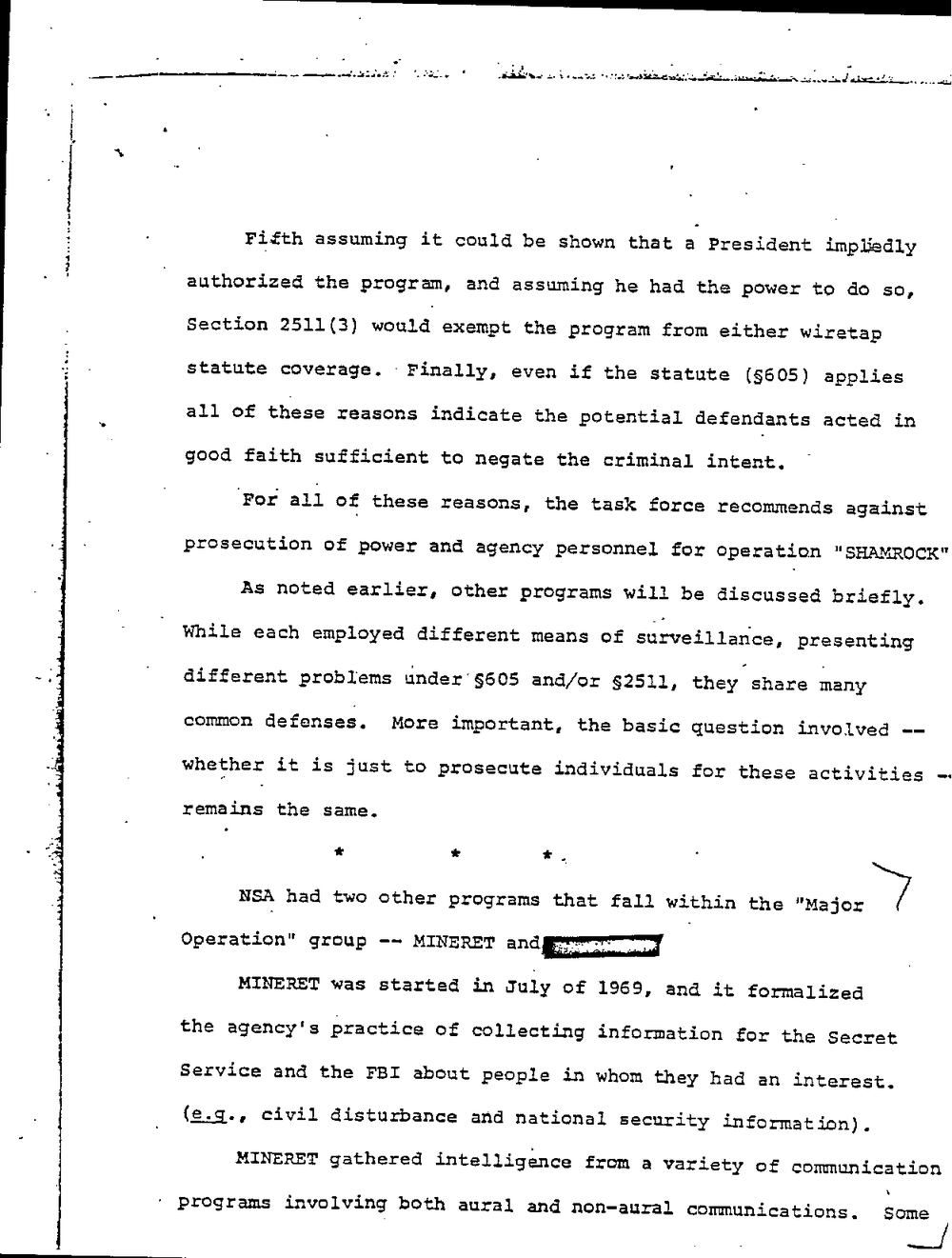
-
?nu.-.. 1..: Usvg - ?i-Hn-Q?Inh
Fifth assuming it could be shown that a President imp?edly
authorized the program, and assuming he had the power to do so,
Section 2511(3) would exempt the program from either wiretap
statute coverage. ?Finally, even if the statute (?605) applies
all of these reasons indicate the potential defendants acted in
good faith sufficient to negate the criminal intent.
'For all of these reasons, the task force recommends against
prosecution of power and agency personnel for Operation
As noted earlier, other programs will be discussed briefly.
While each employed different means of surveillance, presenting
different problems under'?605 and/or ?2511, they share many
common defenses. More important, the basic question involved
whether it is just to prosecute individuals for these activities --
remains the same.
. at1
N83 had two other programs that fall within the "Major \77
Operation" group -- MINERET and I
MINERET was started in July of 1969, and it formalized
the agency's practice of collecting information for the Secret
Service and the FBI about people in whom they had an interest.
civil disturbance and national security information).
HINERET gathered intelligence from a variety of communication
programs involving both aural and non-aural communications. Some
-
?nu.-.. 1..: Usvg - ?i-Hn-Q?Inh
Fifth assuming it could be shown that a President imp?edly
authorized the program, and assuming he had the power to do so,
Section 2511(3) would exempt the program from either wiretap
statute coverage. ?Finally, even if the statute (?605) applies
all of these reasons indicate the potential defendants acted in
good faith sufficient to negate the criminal intent.
'For all of these reasons, the task force recommends against
prosecution of power and agency personnel for Operation
As noted earlier, other programs will be discussed briefly.
While each employed different means of surveillance, presenting
different problems under'?605 and/or ?2511, they share many
common defenses. More important, the basic question involved
whether it is just to prosecute individuals for these activities --
remains the same.
. at1
N83 had two other programs that fall within the "Major \77
Operation" group -- MINERET and I
MINERET was started in July of 1969, and it formalized
the agency's practice of collecting information for the Secret
Service and the FBI about people in whom they had an interest.
civil disturbance and national security information).
HINERET gathered intelligence from a variety of communication
programs involving both aural and non-aural communications. Some
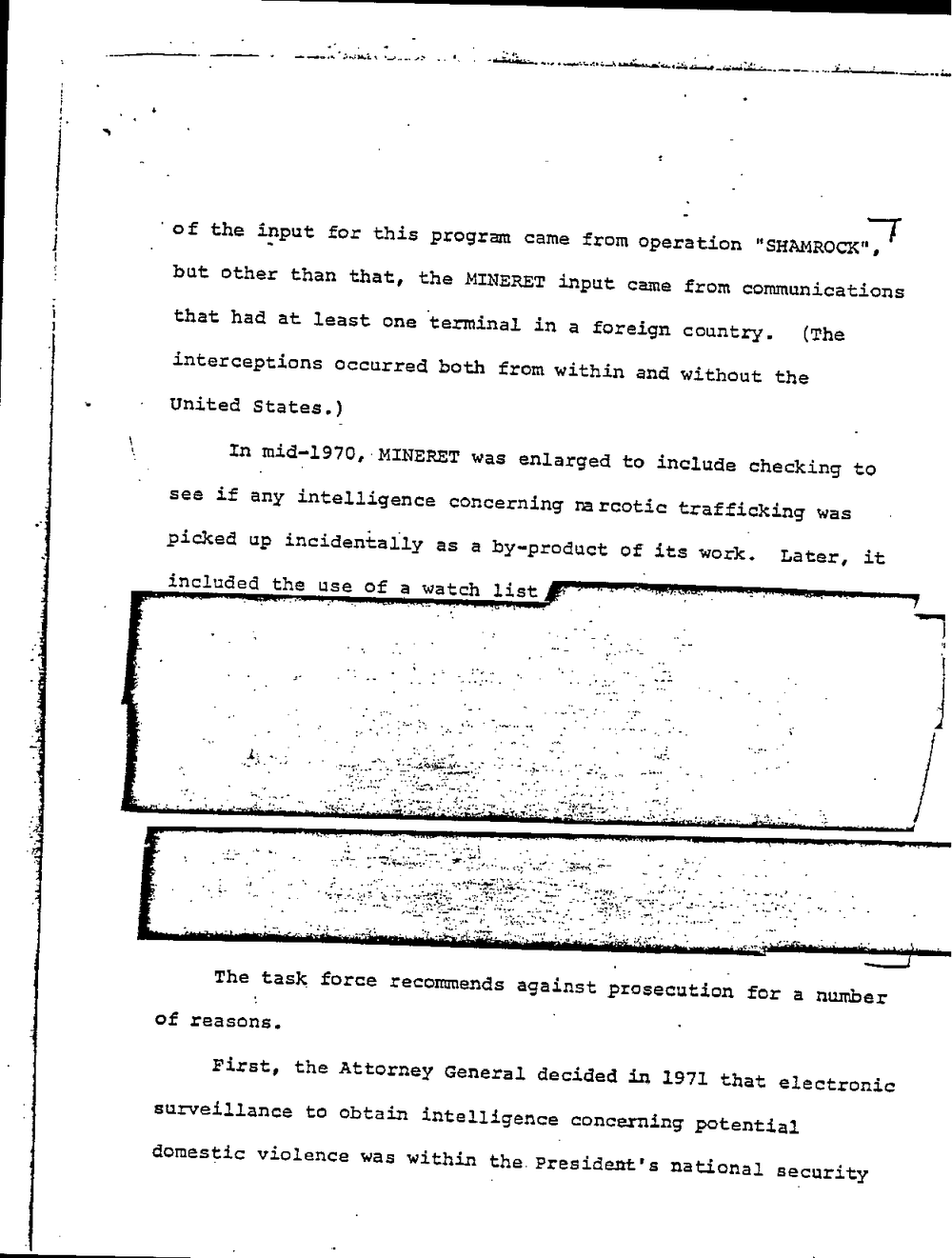
.
J. t. 4.14nJan?s?a -. J9 .. . - uuzh-?li??the input for this program came from Operation
but other than that, the MINERET input came from communications
that had at least one terminal in a foreign country. (The
interceptions occurred both from within and without the
United States.)
In was enlarged to include checking to
see if any intelligence concerning narcotic trafficking was
picked up incidentally as a by-product of its work. Later, it
included the use of a watch list --
The task force recommends against prosecution for a number
of reasons.
First, the Attorney General decided in 1971 that electronic
surveillance to obtain intelligence concerning potential
domestic violence was within the.President's national security
.
J. t. 4.14nJan?s?a -. J9 .. . - uuzh-?li??the input for this program came from Operation
but other than that, the MINERET input came from communications
that had at least one terminal in a foreign country. (The
interceptions occurred both from within and without the
United States.)
In was enlarged to include checking to
see if any intelligence concerning narcotic trafficking was
picked up incidentally as a by-product of its work. Later, it
included the use of a watch list --
The task force recommends against prosecution for a number
of reasons.
First, the Attorney General decided in 1971 that electronic
surveillance to obtain intelligence concerning potential
domestic violence was within the.President's national security
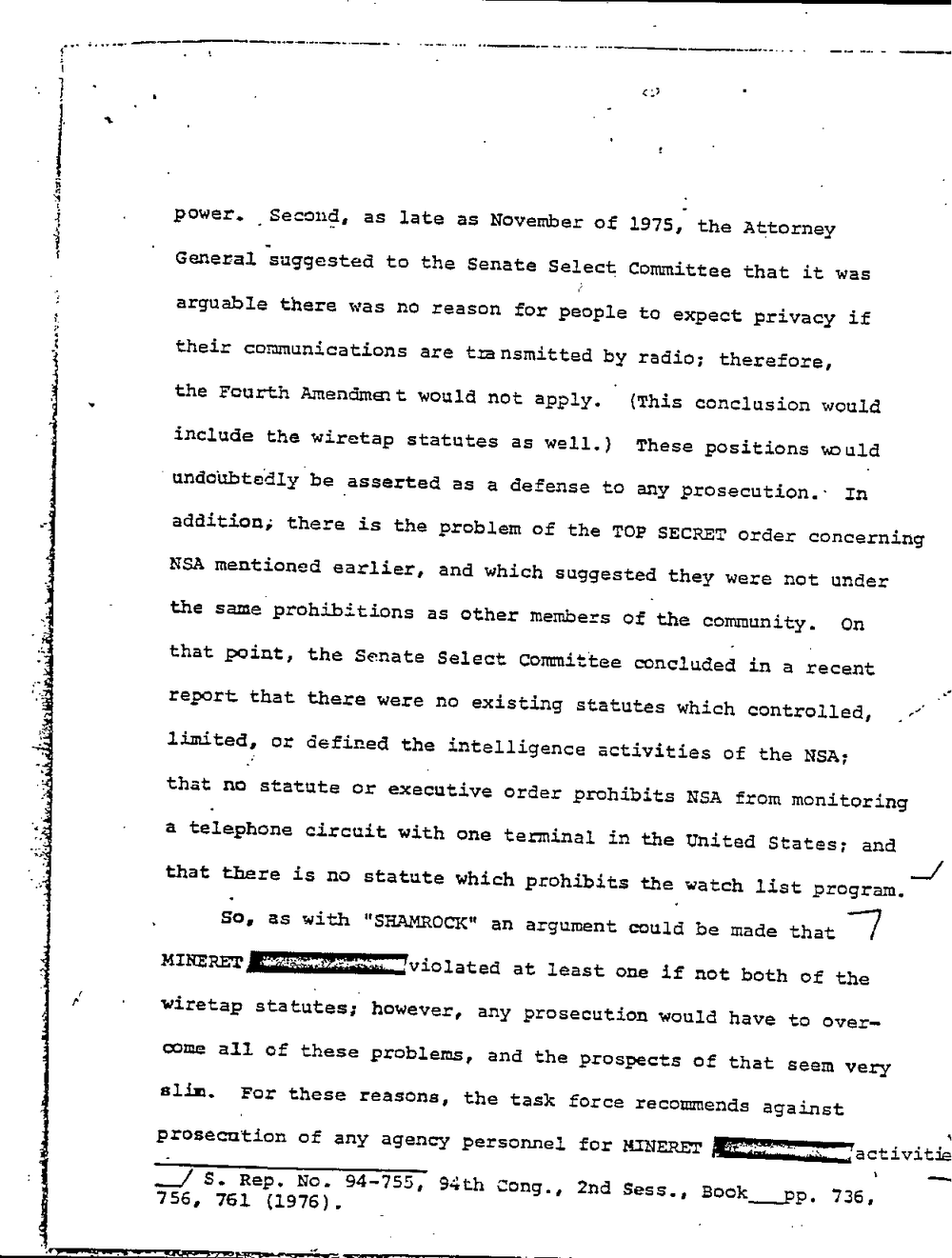
. . .
- ..-- c.0? - . -n?u .4
power. _Second, as late as November of 1975, the Attorney
.. .. u-A.
I
n,
General suggested to the Senate Select Committee that it was
arguable there was no reason for people to expect privacy if
their communications are transmitted by radio: therefore,
the Fourth Amendment would not apply. (This conclusion would
include the wiretap statutes as well.) These positions would
'undoubtedly be asserted as a defense to any prosecution.' In
'1
addition; there is the problem of the TOP SECRET order concerning
4..
NSA mentioned earlier, and which suggested they were not under
the same prohibitions as other members of the community. On
that point, the Senate Select Committee concluded in a recent
report that there were no existing statutes which controlled,
limited, or defined the intelligence activities of the
I *3 .
that no statute or executive order prohibits NSA from monitoring
a telephone circuit with one terminal in the United States: and
that there is no statute which prohibits the watch list program.
So, as with an argument could be made that
violated at least one if not both of the
wiretap statutes; however, any prosecution would have to over?
an
35
come all of these problems, and the prospects of that seem very
slim. For these reasons, the task force recommends against
prosecution of any agency personnel for HINERET mastivitie
a?cim.
S. Rep. No. 94-755, 94th Cong., 2nd Sess., Book pp. 736,
756, 761 (1976).
. .t
. . .
- ..-- c.0? - . -n?u .4
power. _Second, as late as November of 1975, the Attorney
.. .. u-A.
I
n,
General suggested to the Senate Select Committee that it was
arguable there was no reason for people to expect privacy if
their communications are transmitted by radio: therefore,
the Fourth Amendment would not apply. (This conclusion would
include the wiretap statutes as well.) These positions would
'undoubtedly be asserted as a defense to any prosecution.' In
'1
addition; there is the problem of the TOP SECRET order concerning
4..
NSA mentioned earlier, and which suggested they were not under
the same prohibitions as other members of the community. On
that point, the Senate Select Committee concluded in a recent
report that there were no existing statutes which controlled,
limited, or defined the intelligence activities of the
I *3 .
that no statute or executive order prohibits NSA from monitoring
a telephone circuit with one terminal in the United States: and
that there is no statute which prohibits the watch list program.
So, as with an argument could be made that
violated at least one if not both of the
wiretap statutes; however, any prosecution would have to over?
an
35
come all of these problems, and the prospects of that seem very
slim. For these reasons, the task force recommends against
prosecution of any agency personnel for HINERET mastivitie
a?cim.
S. Rep. No. 94-755, 94th Cong., 2nd Sess., Book pp. 736,
756, 761 (1976).
. .t
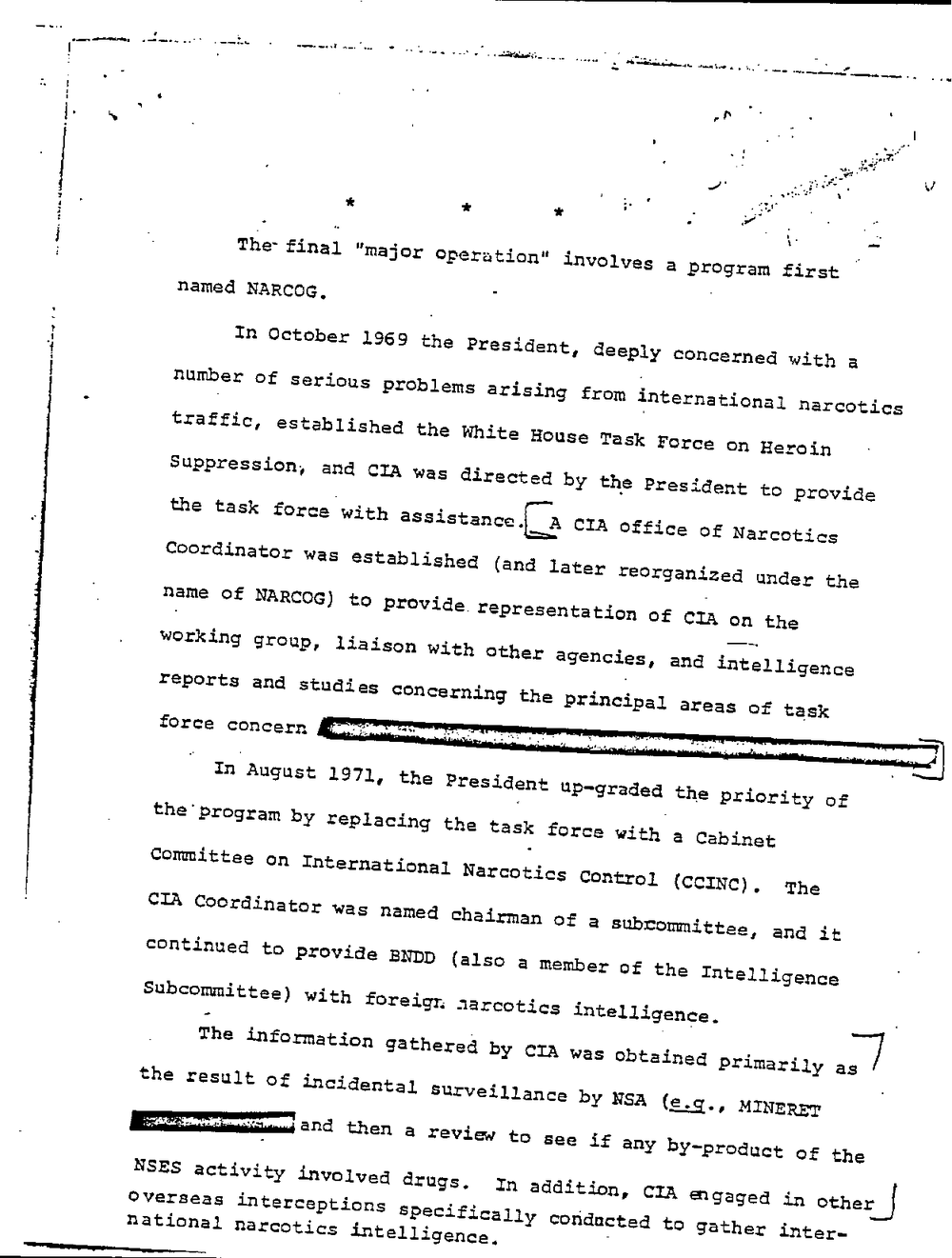
- . . . Jul.-. .
-
I .Vl
1,.a
i 1 The'final "major Operation" involves a program first
named NARCOG.
In October 1969 the President, deeply concerned with a
a
number of serious problems arising from international narcotics
traffic, established the White House Task Force on Heroin
Suppression, and CIA was directed by the President to provide
the task force with assistanco{;;? CIA office of Narcotics
Coordinator was established (and later reorganized under the
5 1 name of NARCOG) to provide representation of CIA on the
working group, liaison with other agencies, and intelligence
reports and studies concerning the principal areas of task
1
force concern w:
CIA Coordinator was named chairman of a subcommittee, and it
continued to provide BNDD (also a member of the Intelligence
Subcommittee) with foreign narcotics intelligence.
The information gathered by CIA was obtained primarily as
Wand then a review to see if any by-product of the
N838 activity involved drugs. In addition, CIA algaged in other?j
overseas interceptions specifically conducted to gather inter?
national narcotics intelligence
- . . . Jul.-. .
-
I .Vl
1,.a
i 1 The'final "major Operation" involves a program first
named NARCOG.
In October 1969 the President, deeply concerned with a
a
number of serious problems arising from international narcotics
traffic, established the White House Task Force on Heroin
Suppression, and CIA was directed by the President to provide
the task force with assistanco{;;? CIA office of Narcotics
Coordinator was established (and later reorganized under the
5 1 name of NARCOG) to provide representation of CIA on the
working group, liaison with other agencies, and intelligence
reports and studies concerning the principal areas of task
1
force concern w:
CIA Coordinator was named chairman of a subcommittee, and it
continued to provide BNDD (also a member of the Intelligence
Subcommittee) with foreign narcotics intelligence.
The information gathered by CIA was obtained primarily as
Wand then a review to see if any by-product of the
N838 activity involved drugs. In addition, CIA algaged in other?j
overseas interceptions specifically conducted to gather inter?
national narcotics intelligence
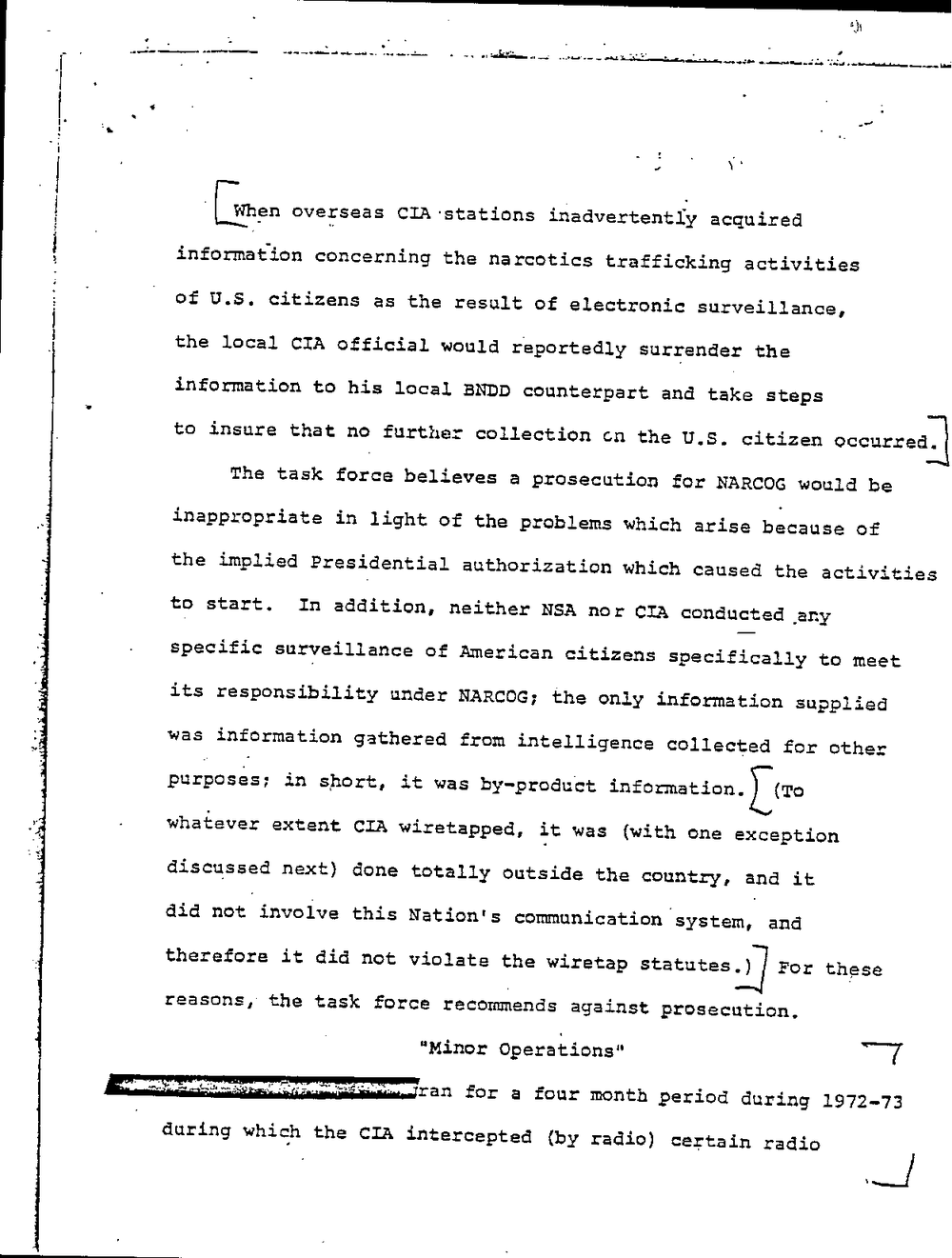
. .
A.) .-
LL Lini'?'?
-
I
- I
. p.
overseas CIA stations inadvertently acquired
information concerning the narcotics trafficking activities
of U.S. citizens as the result of electronic surveillance,
the local CIA official would reportedly surrender the
information to his local BNDD counterpart and take steps
to insure that no further collection on the U.S. citizen occurred:]
The task force believes a prosecution for NARCOG would be
inapproPriate in light of the problems which arise because of
the implied Presidential authorization which caused the activities
to start. In addition, neither NSA nor CIA conducted,any
specific surveillance of American citizens specifically to meet
its responsibility under the only information supplied
was information gathered from intelligence collected for other
purposes; in short, it was by-product information.2:kTo
whatever extent CIA wiretapped, it was {with one exception
discussed next) done totally outside the country, and it
did not involve this Nation's communication system; and
therefore it did not violate the wiretap statutesLi] For these
reasons, the task force recomnends against prosecution.
"Minor Operations"
ran for a four month period during 1972?73
during which the CIA intercepted (by radio) certain radio
. .
A.) .-
LL Lini'?'?
-
I
- I
. p.
overseas CIA stations inadvertently acquired
information concerning the narcotics trafficking activities
of U.S. citizens as the result of electronic surveillance,
the local CIA official would reportedly surrender the
information to his local BNDD counterpart and take steps
to insure that no further collection on the U.S. citizen occurred:]
The task force believes a prosecution for NARCOG would be
inapproPriate in light of the problems which arise because of
the implied Presidential authorization which caused the activities
to start. In addition, neither NSA nor CIA conducted,any
specific surveillance of American citizens specifically to meet
its responsibility under the only information supplied
was information gathered from intelligence collected for other
purposes; in short, it was by-product information.2:kTo
whatever extent CIA wiretapped, it was {with one exception
discussed next) done totally outside the country, and it
did not involve this Nation's communication system; and
therefore it did not violate the wiretap statutesLi] For these
reasons, the task force recomnends against prosecution.
"Minor Operations"
ran for a four month period during 1972?73
during which the CIA intercepted (by radio) certain radio
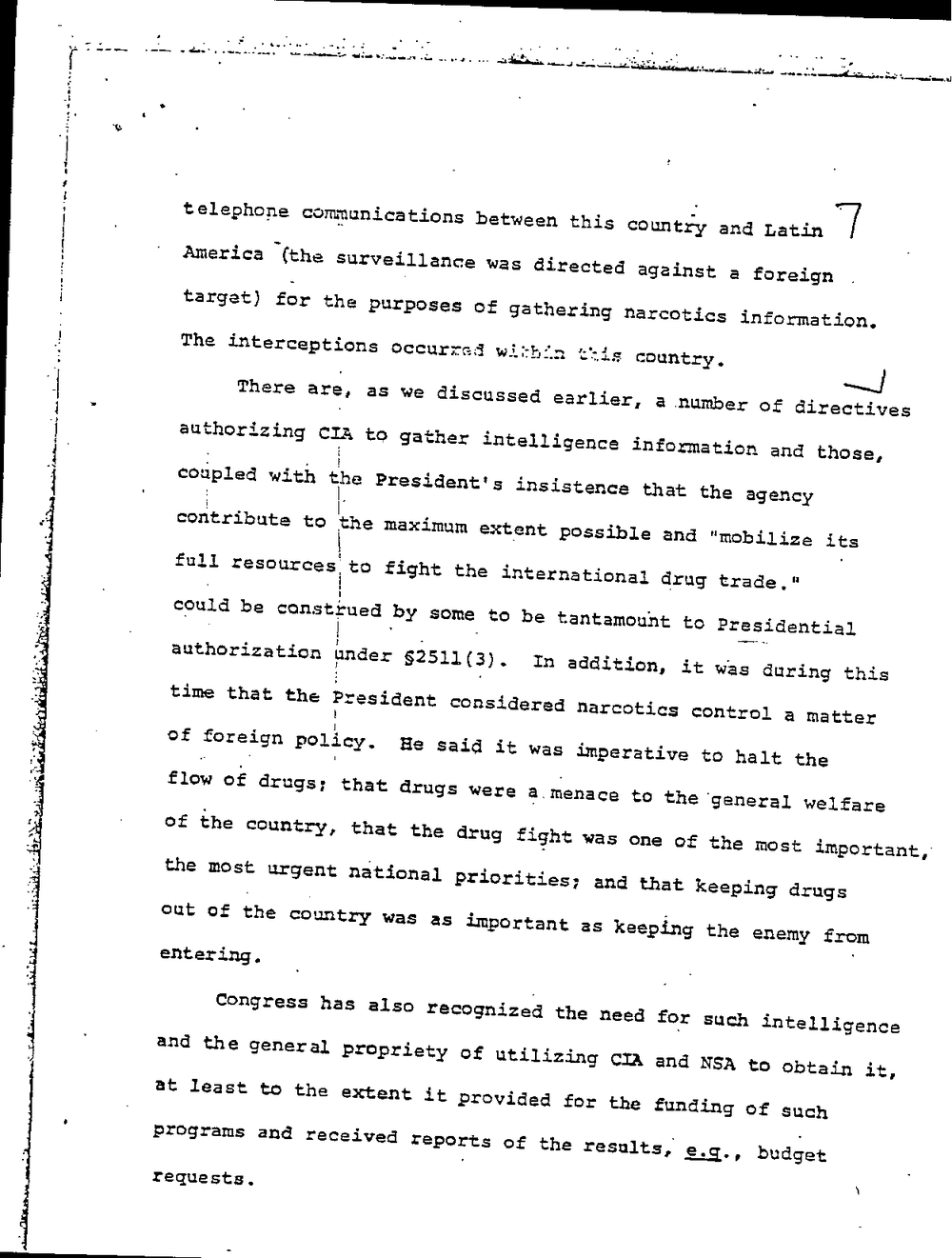
telephone communications between this country and Latin ?7
I.-
-
America Ythe surveillance was directed against a foreign
target) for the purposes of gathering narcotics information.
There are, as we discussed earlier, a number of directives
The interceptions occurred within this country.
authorizing clA to gather intelligence information and those,
coupled with ?he President's insistence that the agency
1 .
contribute to Ehe maximum extent possible and "mobilize its
full resourcesgto fight the international drug trade."
could be constiued by some to be tantamount to Presidential
authorization hnder In addition, it was during this
time that the #resident considered narcotics control a matter
of foreign policy. He said it was imperative to halt the
flan of drugs; that drugs were a.menace to the'general welfare
of the country, that the drug fight was one of the most important.
the most urgent national priorities: and that keeping drugs
out of the country was as important as keeping the enemy from
entering.
congress has also rec0gnized the need for such intelligence
and the general prOpriety of utilizing CIA and NSA to obtain it,
at least to the extent it provided for the fUnding of such
programs and received reports of the results. a. ., budget
requests.
telephone communications between this country and Latin ?7
I.-
-
America Ythe surveillance was directed against a foreign
target) for the purposes of gathering narcotics information.
There are, as we discussed earlier, a number of directives
The interceptions occurred within this country.
authorizing clA to gather intelligence information and those,
coupled with ?he President's insistence that the agency
1 .
contribute to Ehe maximum extent possible and "mobilize its
full resourcesgto fight the international drug trade."
could be constiued by some to be tantamount to Presidential
authorization hnder In addition, it was during this
time that the #resident considered narcotics control a matter
of foreign policy. He said it was imperative to halt the
flan of drugs; that drugs were a.menace to the'general welfare
of the country, that the drug fight was one of the most important.
the most urgent national priorities: and that keeping drugs
out of the country was as important as keeping the enemy from
entering.
congress has also rec0gnized the need for such intelligence
and the general prOpriety of utilizing CIA and NSA to obtain it,
at least to the extent it provided for the fUnding of such
programs and received reports of the results. a. ., budget
requests.
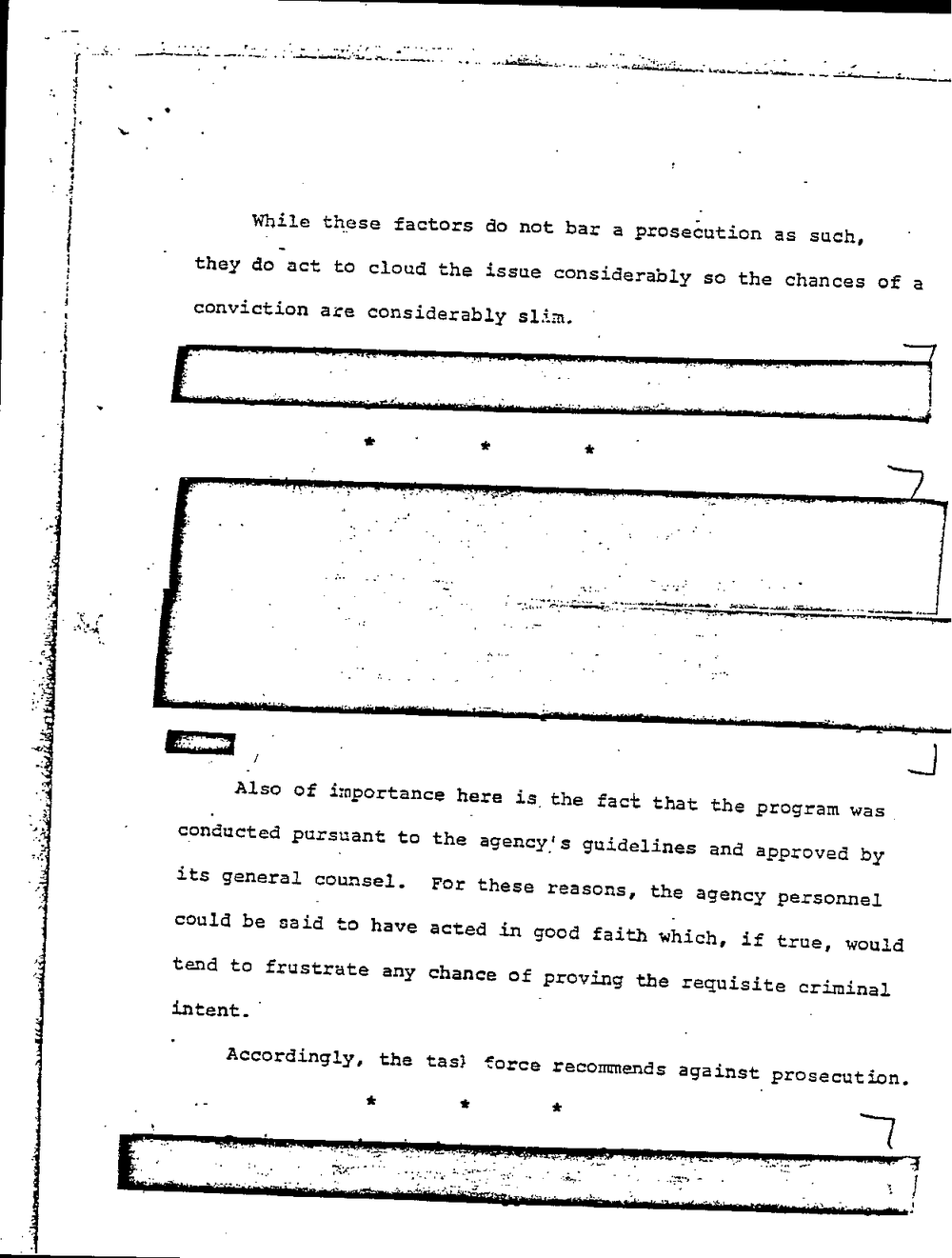
q? ..
. - .. 421'.? - JamWhile these factors do not bar a prosecution as such,
they do act to cloud the issue considerably so the chances of a
?5 conviction are conSiderably slirMh?h?ntra.? ?ruin-quagig.
the agency personnel
if true, would
3 Also of importance here is_the fact that the program was"
LE conducted pursuant to the guidelines and approved by
.
q; its general counsel. For these reasons,
i . .
could be said to have acted in good faith which,
1
tend to frustrate any chance of provrng the requisite criminal
3
intent.
a
i . Accordingly, the tasl force recommends against prosecution.L..
an
1
SI
q? ..
. - .. 421'.? - JamWhile these factors do not bar a prosecution as such,
they do act to cloud the issue considerably so the chances of a
?5 conviction are conSiderably slirMh?h?ntra.? ?ruin-quagig.
the agency personnel
if true, would
3 Also of importance here is_the fact that the program was"
LE conducted pursuant to the guidelines and approved by
.
q; its general counsel. For these reasons,
i . .
could be said to have acted in good faith which,
1
tend to frustrate any chance of provrng the requisite criminal
3
intent.
a
i . Accordingly, the tasl force recommends against prosecution.L..
an
1
SI
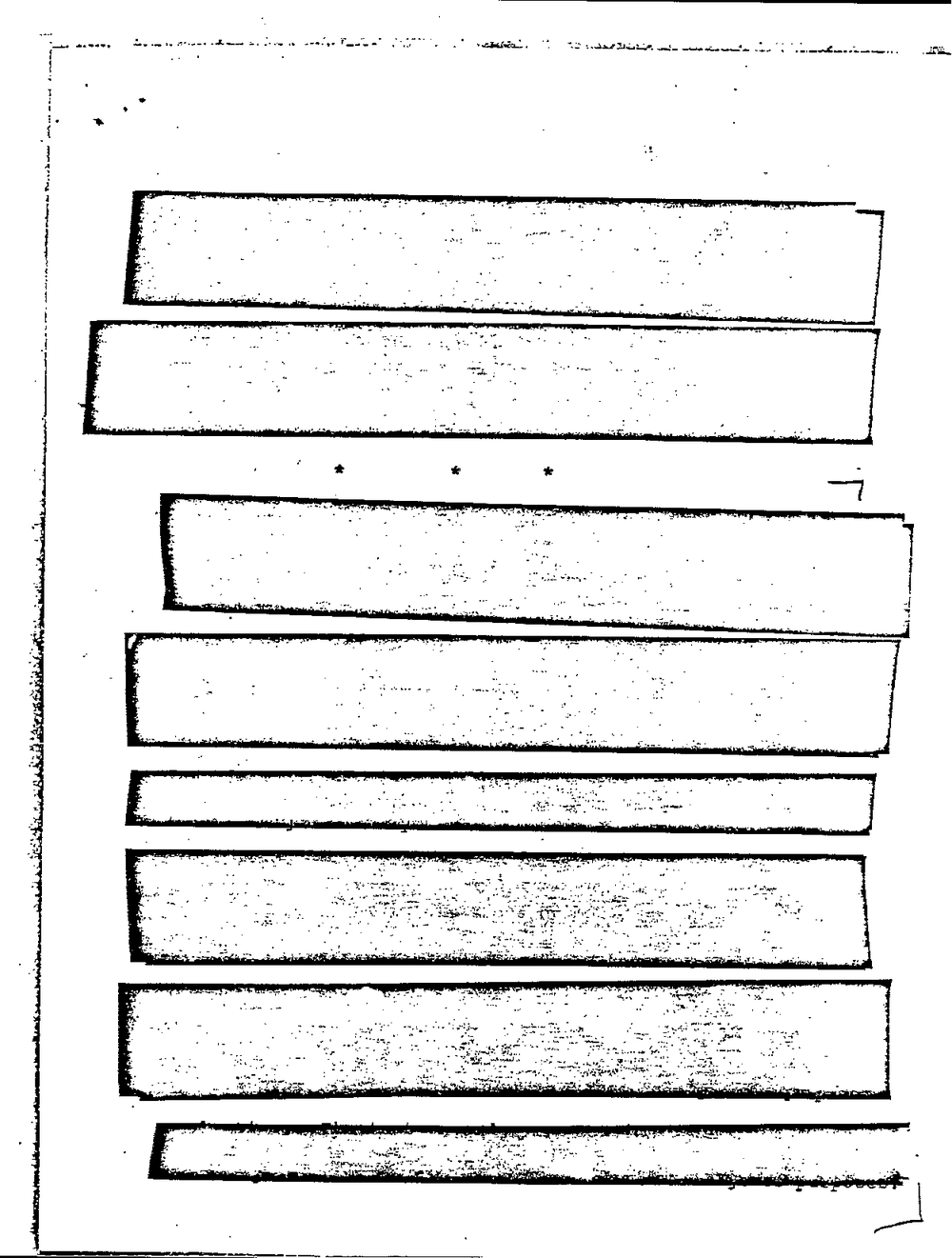
I .
. I. u-J. - --?null-dun.
iA?_
?43.5-4:
ML:
.
.l?Lnl ?355.13.
gull;
.
LA
Ind?K
k?
I .
. I. u-J. - --?null-dun.
iA?_
?43.5-4:
ML:
.
.l?Lnl ?355.13.
gull;
.
LA
Ind?K
k?
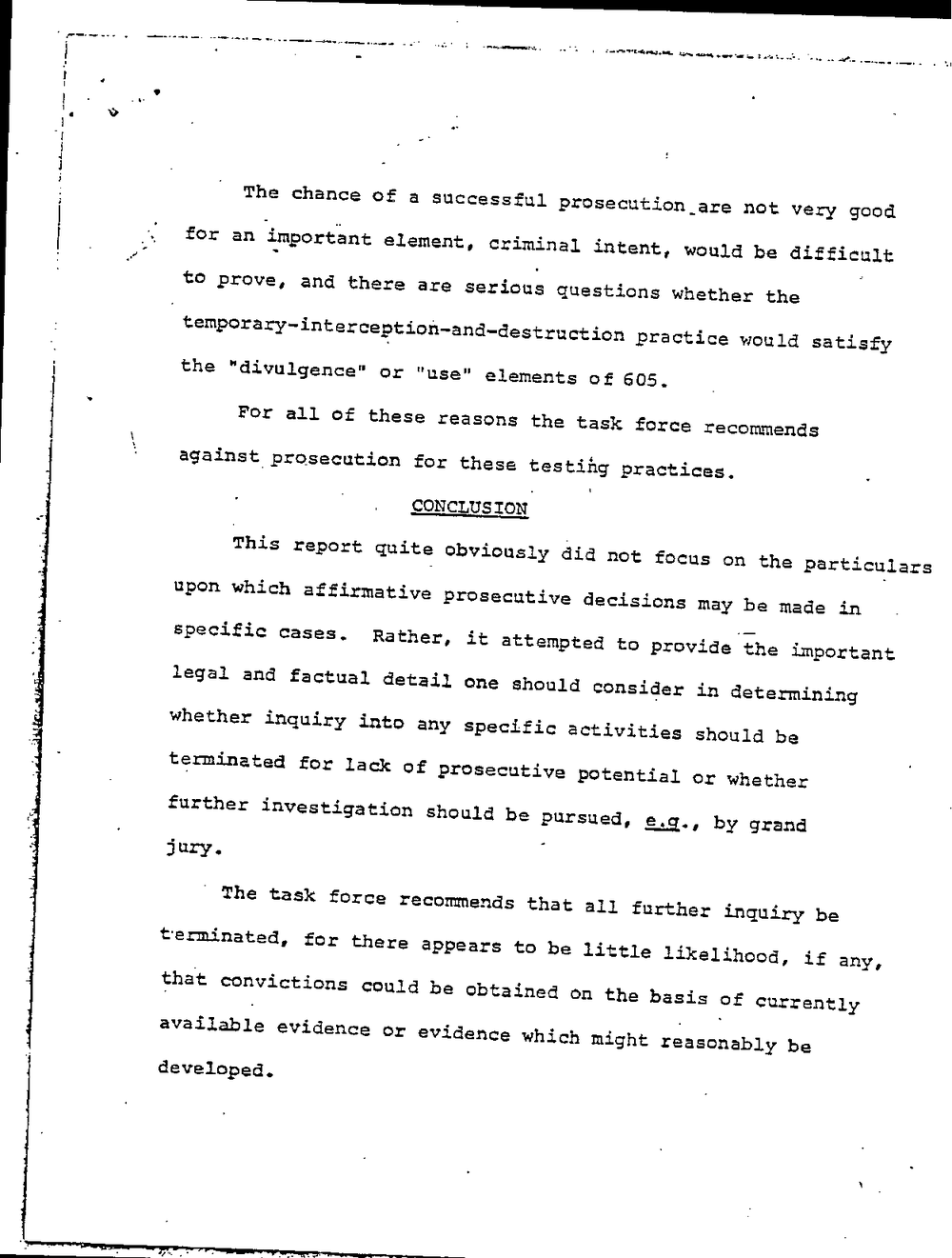
-.
. .- . .
A ?Lulu L1. .- A
Ila-.2.
A
. - nun-me?
. ma? 2.1.1- .. at.
.
The chance of a successful prosecution_are not very good
for an-important element, criminal intent, would be difficult
to prove, and there are serious questions whether the
practice would satisfy
the ?divulgence? or "use" elements of 605.
For all of these reasons the task force recommends
against_prosecution for these testing practices.
CONCLUSION
specific cases. Rather, it attempted to provide the important
legal and factual detail one should consider in determining
whether inquiry into any specific activities should be
terminated for lack of prosecutive potential or whether
further investigation should be pursued, 343., by grand
jury.
The task force recommends that all further inquiry be
terminated, for there appears to be little likelihood, if any,
develoPed.
-.
. .- . .
A ?Lulu L1. .- A
Ila-.2.
A
. - nun-me?
. ma? 2.1.1- .. at.
.
The chance of a successful prosecution_are not very good
for an-important element, criminal intent, would be difficult
to prove, and there are serious questions whether the
practice would satisfy
the ?divulgence? or "use" elements of 605.
For all of these reasons the task force recommends
against_prosecution for these testing practices.
CONCLUSION
specific cases. Rather, it attempted to provide the important
legal and factual detail one should consider in determining
whether inquiry into any specific activities should be
terminated for lack of prosecutive potential or whether
further investigation should be pursued, 343., by grand
jury.
The task force recommends that all further inquiry be
terminated, for there appears to be little likelihood, if any,
develoPed.
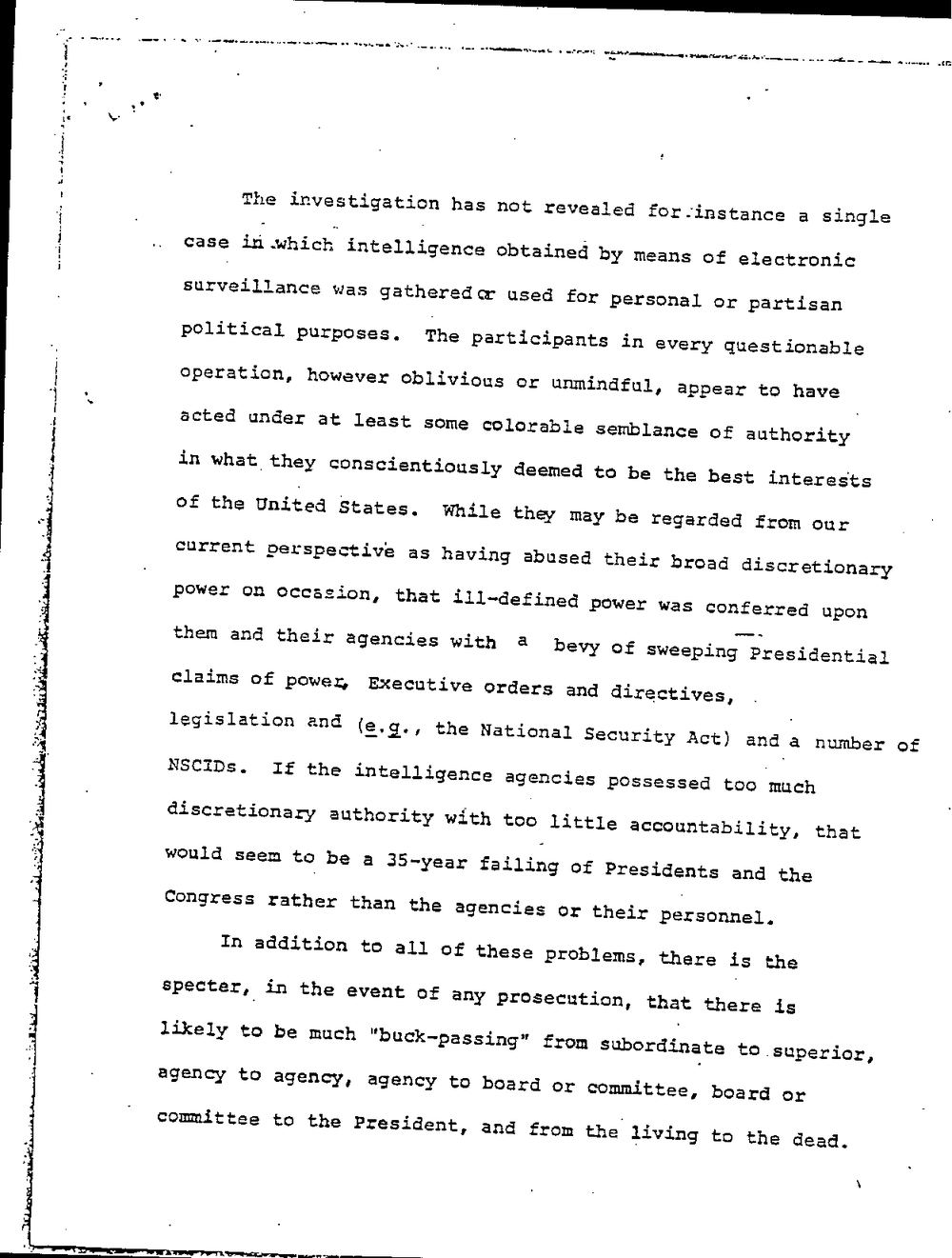
4u?n? . .. .4 man-?? .. -I-..-. .Il:
The investigation has not revealed forJinstance a single
case inlwhich intelligence obtained by means of electronic
surveillance was gatheredor used for personal or partisan
political purposes. fhe participants in every questionable
operation, however oblivious or unmindful, appear to have
acted under at least some colorable semblance of authority.
in what_they conscientiously deemed to be the best interests
of the United States. While they may be regarded from our
current perspective as having abused their broad discretionary
power on occasion, that ill-defined power was conferred upon
them and their agencies with a bevy of
claims of power, Executive orders and directives,
legislation and the National Security Act) and a number of
NSCIDs. If the intelligence agencies possessed too much
discretionary authority with too little accountability, that
would seem to be a 35-year failing of Presidents and the
Congress rather than the agencies or their personnel.
In addition to all of these problems, there is the
specter, in the event of any prosecution, that there is
likely to be much "buck-passing" from subordinate to superior,
agency to agenCy, agency to board or committee, board or
committee to the President, and from the living to the dead.
4u?n? . .. .4 man-?? .. -I-..-. .Il:
The investigation has not revealed forJinstance a single
case inlwhich intelligence obtained by means of electronic
surveillance was gatheredor used for personal or partisan
political purposes. fhe participants in every questionable
operation, however oblivious or unmindful, appear to have
acted under at least some colorable semblance of authority.
in what_they conscientiously deemed to be the best interests
of the United States. While they may be regarded from our
current perspective as having abused their broad discretionary
power on occasion, that ill-defined power was conferred upon
them and their agencies with a bevy of
claims of power, Executive orders and directives,
legislation and the National Security Act) and a number of
NSCIDs. If the intelligence agencies possessed too much
discretionary authority with too little accountability, that
would seem to be a 35-year failing of Presidents and the
Congress rather than the agencies or their personnel.
In addition to all of these problems, there is the
specter, in the event of any prosecution, that there is
likely to be much "buck-passing" from subordinate to superior,
agency to agenCy, agency to board or committee, board or
committee to the President, and from the living to the dead.
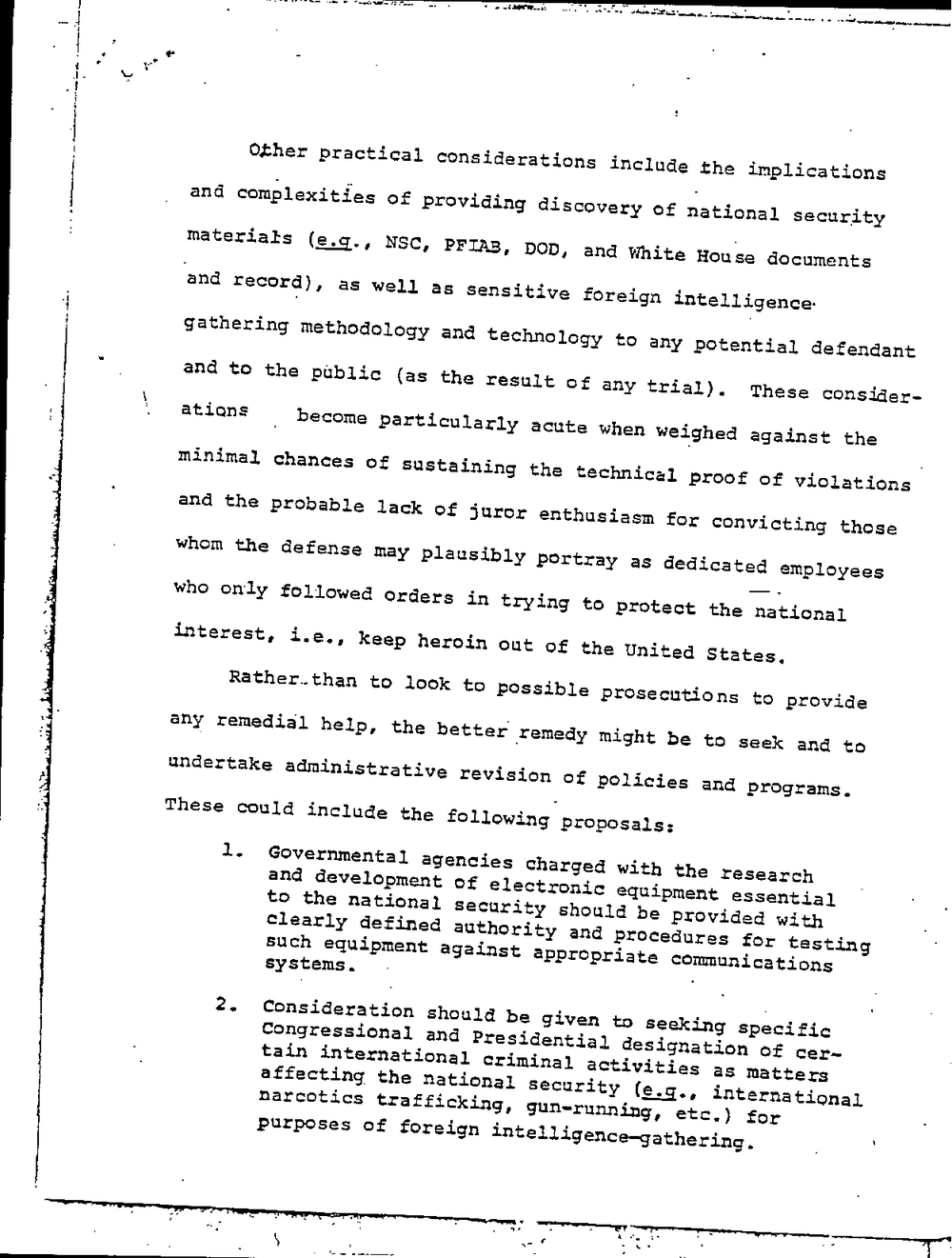
a
II- 1?411. 1.1
LIA
Lmnum-g?rmn.
.
5. 1
.
. .-.
'Jlml. ?bula:
and complexities of providing discovery of national security
materials NSC, PFIAB, DOD, and White House documents
and record), as well as sensitive foreign intelligence-
gathering methodology and technology to any potential defendant
and to the public (as the result of any trial). These consider-
ations become particularly acute when weighed against the
interest, keep heroin out of the United States.
Rathermthan to look to possible prosecutions to provide
any remedial help, the better remedy might be to seek and to
undertake administrative revision of policies and programs.
These could include the following proposals:
1. Governmental agencies charged with the research
affecting the national security international
narcotics trafficking, gun?running, etc.) for
purposes of foreign intelligence-gathering.
a
II- 1?411. 1.1
LIA
Lmnum-g?rmn.
.
5. 1
.
. .-.
'Jlml. ?bula:
and complexities of providing discovery of national security
materials NSC, PFIAB, DOD, and White House documents
and record), as well as sensitive foreign intelligence-
gathering methodology and technology to any potential defendant
and to the public (as the result of any trial). These consider-
ations become particularly acute when weighed against the
interest, keep heroin out of the United States.
Rathermthan to look to possible prosecutions to provide
any remedial help, the better remedy might be to seek and to
undertake administrative revision of policies and programs.
These could include the following proposals:
1. Governmental agencies charged with the research
affecting the national security international
narcotics trafficking, gun?running, etc.) for
purposes of foreign intelligence-gathering.
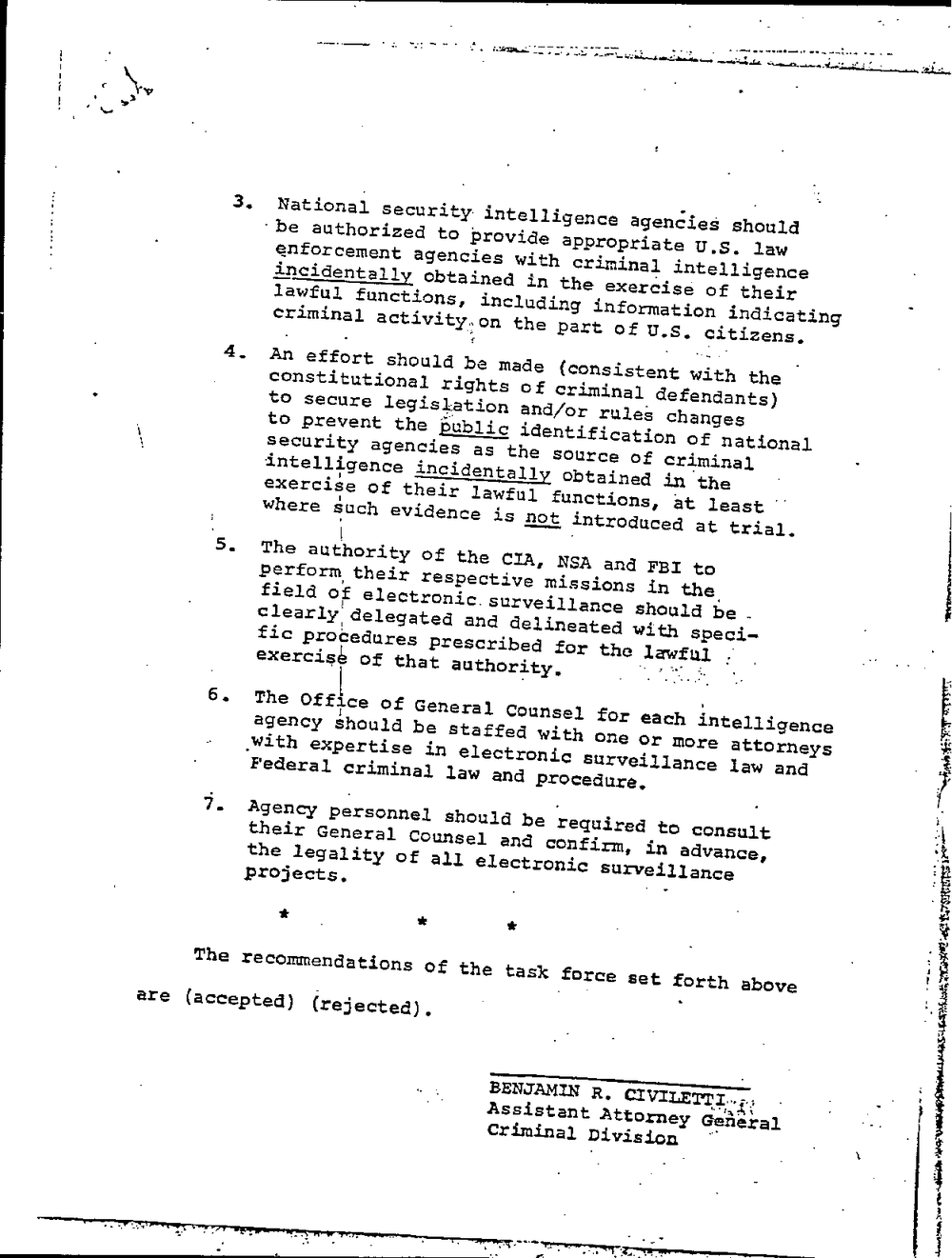
The
. 23?Ltwua-dguu
approPriate U.S.
with criminal intelligence
obtained in the exercise of their
lawful functions, including information indicating
criminal activityjon the part of U.S. citizens.
-
to prevent the Eublic identification of national
security agencies as the source of criminal
intelligence incidentall
fic procedures prescribed for the
exercise of that authority.
projects. a
it
i .3
recommendations of the task force set forth above 3;
are (accepted) (rejected).
EENJAMIN R. ennui-131m - i
Assistant Attorney General
Criminal Division i i
i
r'
.-
?wx ens-n
. .
The
. 23?Ltwua-dguu
approPriate U.S.
with criminal intelligence
obtained in the exercise of their
lawful functions, including information indicating
criminal activityjon the part of U.S. citizens.
-
to prevent the Eublic identification of national
security agencies as the source of criminal
intelligence incidentall
fic procedures prescribed for the
exercise of that authority.
projects. a
it
i .3
recommendations of the task force set forth above 3;
are (accepted) (rejected).
EENJAMIN R. ennui-131m - i
Assistant Attorney General
Criminal Division i i
i
r'
.-
?wx ens-n
. .